2017
2017
THE FIRST TWO ABSTRACTS ARE REVIEWS OF VARIOUS ASPECTS OF PROGRESS IN 2017
Adrienne P Savant, Susanna A McColley. Cystic fibrosis year in review 2017. Pediatr Pulmonol. 2018 Sep;53(9):1307-1317. doi: 10.1002/ppul.24081.Epub 2018 Jun 21. Full text available. [Pubmed]

Fig. 2 Susanna McColley

Fig. 1 Adrienne Savant
In this article, the authors highlight cystic fibrosis (CF) reports published in Pediatric Pulmonology during 2017. They also include articles from a variety of journals that are related or are of special interest to clinicians.
Authors are in the Division of Pulmonary Medicine, Ann & Robert H. Lurie Children’s Hospital of Chicago, Chicago, Illinois. Department of Pediatrics, Northwestern University Feinberg School of Medicine, Chicago, Illinois and Susanna McColley is also at the Stanley Manne Children’s Research Institute, Chicago, Illinois.
Rubin BK. Cystic Fibrosis 2017-The Year in Review. Respir Care. 2017 Dec 26. pii: respcare.06052. doi: 10.4187/respcare.06052. [Epub ahead of print][Pubmed]

Fig. 3 Bruce Rubin vippn.thoracic.org
Professor Rubin observes “it is always an exciting challenge to write a Year in Review artcicle identifying the best publications in the preceding year; in this case from October 2016 until the AARC meeting in October 2017. This is particularly true for cystic fibrosis (CF), where there has been an explosion of new data, new medications, and new understanding of the pathophysiology of the disease. PubMed lists more than 2,500 papers published during those 12 months, many of them outstanding. I am indebted to many colleagues and friends who are leaders in the CF community, active readers of the pediatric pulmonary listserv, and scientists and clinicians engaged in the care of CF, for offering their suggestions regarding which articles should be included in this review. I believe that you will enjoy reading this curated selection of manuscripts that I have tried to organize by theme”.
Bruce K Rubin (fig. 3) is the Jessie Ball du Pont Distinguished Professor and Chair Department of Pediatrics at the Virginia Commonwealth School of Medicine and Children’s Hospital Richmond. (Bruce.rubin@vcuhealth/org). He kindly provided me with a full text of his article which is a very readable account of the present state of our understanding and management of people with cystic fibrosis.
===========================
2017
Abusamra R, McShane D. Is deafness mutation screening required in cystic fibrosis patients? Paediatr Respir Rev. 2016 Aug;20 Suppl:24-6. doi: 10.1016/j.prrv.2016.06.010. Epub 2016 Jun 15. [PubMed]

Fig 4 Rania Abusamra
LinkedIn
Aminoglycosides are widely used in cystic fibrosis management. The m.1555A>G mutation predisposes to aminoglycoside ototoxicity. It may cause later onset hearing loss in the absence of aminoglycosides use and gradual hearing loss may be an inevitable consequence of the mutation. Given that aminoglycoside therapy forms the backbone of IV protocols in CF, these authors recommend screening for this mutation to allow informed decision-making prior to aminoglycoside administration, to avoid preventable deafness.
— Severe ototoxicity with aminoglycosides has been described in children with CF. However, it has been suggested, on the basis of only one of two children with CF and repeated aminoglycoside exposure in one series being affected, that penetrance of this pharmacologic interaction may have been overestimated (Al-Malky G et al, 2014)
Rania Abusamra (fig.4) is in the Department of Paediatrics, Cambridge University Hospitals NHS Foundation Trust, Cambridge, UK. Then Consultant in Respiratory Paediatrics at King’s College Hospital NHS Foundation Trust.

Fig 5. Abhinav Agrawal
Agrawal A, Agarwal A, Mehta D, Sikachi RR, Du D, Wang J. Nationwide trends of hospitalizations for cystic fibrosis in the United States from 2003 to 2013. Intractable Rare Dis Res. 2017 Aug;6(3):191-198. doi: 10.5582/irdr.2017.01043.(Full article available on journal website) [Pubmed]
The authors analysed the National Inpatient Sample Database (NIS) in the United States for all patients in which CF was the primary discharge diagnosis (ICD-9: 277.0-277.09) from 2003 to 2013 to evaluate the rate of hospitalizations and determine the cost and mortality associated with CF along with other epidemiological findings. The statistical significance of the difference in the number of hospital discharges, lengths of stays and associated hospital costs over the study period was calculated.
In 2003, there were 8,328 hospital discharges with the principal discharge diagnosis of CF in the United States, which increased to 12,590 discharges in 2013 (p < 0.001). The mean hospital charges increased by 57.64% from US$ 60,051 in 2003 to US$ 94,664 in 2013. The aggregate cost of hospital visits increased by 138.31% from US$ 500,105,727 to US$ 1,191,819,760. In the same time, the mortality decreased by 49.3 %. The number of inpatient discharges related to CF has increased from 2003 to 2013. This is due to increased life expectancy of CF patients, resulting in increased disease prevalence.
There has been a significant increase in the mean and aggregate cost associated with CF admissions. Over the last decade, many advances have been made in the diagnosis and treatment of CF, consequentially leading to a significant transformation in the epidemiology and demographics of this chronic disease. Rising hospital costs associated with the care of CF patients necessitates future studies analysing the diagnostic modalities, algorithms and treatment practices of physician’s treating CF patients.
Dr Abhinav Agrawal (fig. 5) is Fellow, in the Division of Pulmonary, Critical Care and Sleep Medicine at the Hofstra Northwell School of Medicine, New York.
Albert BB, Jaksic M, Ramirez J, Bors J, Carter P, Cutfield WS, Hofman PL. An unusual cause of growth failure in cystic fibrosis: A salutary reminder of the interaction between glucocorticoids and cytochrome P450 inhibiting medication. J Cyst Fibros. 2015 Jul;14(4):e9-11. doi: 10.1016/j.jcf.2014.09.007. Epub 2014 Oct 5. [25286825] [Pubmed]Free full text

Fig.6 Benjamin Albert
University of Auckland
A 12 ½ year old boy with cystic fibrosis presented with growth failure after itraconazole was added to a treatment regimen including inhaled and intranasal glucocorticoids. Investigations showed severe adrenal suppression. This case demonstrates the potential for exogenous glucocorticoids to accumulate when their degradation is inhibited by a CYP3A4 inhibitor – the major cytochrome P450 enzyme responsible for metabolism of synthetic glucocorticoids.. Other medications inhibiting CYP3A4 include macrolides (e.g. clarithromycin) and antivirals (e.g. ritonavir). Importantly, itraconazole is often used in combination with glucocorticoid treatment in patients with cystic fibrosis.
Dr. Benjamin B Albert (fig. 6) is a paediatrician at the University of Auckland School of Medicine.
Alton EW, Beekman JM, Boyd AC, Brand J, Carlon MS, Connolly MM, et al. Preparation for a first-in-man lentivirus trial in patients with cystic fibrosis. Thorax. 2017 Feb;72(2):137-147. doi: 10.1136/thoraxjnl-2016-208406. Epub 2016 Nov 16. Free PMC Article [Pubmed]

Fig. 7 Eric Alton Imperial College London
The authors have recently shown that non-viral gene therapy can stabilise the decline of lung function in patients with cystic fibrosis (CF). However, the effect was modest, and more potent gene transfer agents are still required. Fuson protein (F)/Hemagglutinin/Neuraminidase protein (HN)-pseudotyped lentiviral vectors are more efficient for lung gene transfer than non-viral vectors in preclinical models. In preparation for a first-in-man CF trial using the lentiviral vector, we have undertaken key translational preclinical studies. Regulatory-compliant vectors carrying a range of promoter/enhancer elements were assessed in mice and human air-liquid interface (ALI) cultures to select the lead candidate; cystic fibrosis transmembrane conductance receptor (CFTR) expression and function were assessed in CF models using this lead candidate vector. Toxicity was assessed and ‘benchmarked’ against the leading non-viral formulation recently used in a Phase IIb clinical trial. Integration site profiles were mapped and transduction efficiency determined to inform clinical trial dose-ranging. The impact of pre-existing and acquired immunity against the vector and vector stability in several clinically relevant delivery devices was assessed. A hybrid promoter hybrid cytosine guanine dinucleotide (CpG)- free CMV enhancer/elongation factor 1 alpha promoter (hCEF) consisting of the elongation factor 1α promoter and the cytomegalovirus enhancer was most efficacious in both murine lungs and human ALI cultures (both at least 2-log orders above background). The efficacy (at least 14% of airway cells transduced), toxicity and integration site profile supports further progression towards clinical trial and pre-existing and acquired immune responses do not interfere with vector efficacy. The lead rSIV.F/HN candidate expresses functional CFTR and the vector retains 90-100% transduction efficiency in clinically relevant delivery devices. The authors consider the data support the progression of the F/HN-pseudotyped lentiviral vector into a first-in-man CF trial in 2017.
— Recent progress of the UK Gene Therapy Consortium whose members are now working with viral vectors in view of the disappointing results of their recent trial using a liposome vector.
Archibald AD, Smith MJ, Burgess T, Scarff KL, Elliott J, Hunt CE, Barns-Jenkins C, Holt C, Sandoval K, Siva Kumar V, Ward L, Allen EC, Collis SV, Cowie S, Francis D, Delatycki MB, Yiu EM, Massie RJ, Pertile MD, du Sart D, Bruno D, Amor DJ Reproductive genetic carrier screening for cystic fibrosis, fragile X syndrome, and spinal muscular atrophy in Australia: outcomes of 12,000 tests. Genet Med. 2017 Oct 26. doi: 10.1038/gim.2017.134. [Epub ahead of print] [Pubmed]

Fig 8. Alison Archibald
A report, from Victoria Australia, of experience of offering simultaneous genetic carrier screening for cystic fibrosis (CF), fragile X syndrome (FXS), and spinal muscular atrophy (SMA). Carrier screening is offered through general practice, obstetrics, fertility, and genetics settings before or in early pregnancy. Carriers are offered genetic counselling with prenatal/preimplantation genetic diagnosis available to those at increased risk.
Screening of 12,000 individuals revealed 610 carriers (5.08%; 1 in 20): 342 CF, 35 FXS, 241 SMA (8 carriers of 2 conditions), approximately 88% of whom had no family history. At least 94% of CF and SMA carriers’ partners were tested. Fifty couples (0.42%; 1 in 240) were at increased risk of having a child with one of the conditions (14 CF, 35 FXS, and 1 SMA) with 32 pregnant at the time of testing. Of these, 26 opted for prenatal diagnosis revealing 7 pregnancies affected (4 CF, 2 FXS, 1 SMA). The combined affected pregnancy rate is comparable to the population risk for Down syndrome, emphasizing the need to routinely offer carrier screening. The availability of appropriate genetic counselling support and a collaborative approach between laboratory teams, genetics services, health professionals offering screening, and support organizations is essential.
Dr Alison Archibald (fig. 8) is associate Genetic Counsellor at the Victorian Genetics Services, Parkville, Victoria
Aslam AA, Higgins C, Sinha IP, Southern KW. Ataluren and similar compounds (specific therapies for premature termination codon class I mutations) for cystic fibrosis. Cochrane Database Syst Rev. 2017 Jan 19;1:CD012040. doi: 10.1002/14651858.CD012040.pub2. [Pubmed]
Objectives were to evaluate the benefits and harms of ataluren and similar compounds on clinically important outcomes in people with cystic fibrosis with class I mutations (premature termination codons). Searches identified 28 references to eight trials; five trials were excluded.
The authors concluded there is currently insufficient evidence to determine the effect of ataluren as a therapy for people with cystic fibrosis with class I mutations. Future trials should carefully assess for adverse events, notably renal impairment and consider the possibility of drug interactions. Cross-over trials should be avoided given the potential for the treatment to change the natural history of cystic fibrosis.
— A useful review on the present state of this treatment of these class 1 mutations.
From the Department of Women’s and Children’s Health, University of Liverpool, Alder Hey Children’s NHS Foundation Trust, Eaton Road, Liverpool, UK, L12 2AP.
Aziz DB, Low JL, Wu ML, Gengenbacher M, Teo JW, Dartois V, Dick T. Rifabutin Is Active Against Mycobacterium abscessus Complex. Antimicrob Agents Chemother. 2017 Apr 10. pii: AAC.00155-17. doi: 10.1128/AAC.00155-17. [Epub ahead of print] [Pubmed]

Fig. 9 Dinah Binte Aziz loop.frontiersin.org
A collection of more than 2700 approved drugs was screened at a single point concentration against an M. abscessus clinical isolate. Surprisingly, the rifampicin derivative rifabutin had an MIC of 3 ± 2 μM (3 μg/mL) against the screening strain, the reference strains M. abscessus subsp. abscessus ATCC 19977, M. abscessus subsp. bolletii CCUG 50184-T and M. abscessus subsp. massiliense CCUG 48898-T, as well as a collection of clinical isolates. Furthermore, rifabutin was active against clarithromycin resistant strains.
— The authors concluded, rifabutin – in contrast to rifampicin – is active against the Mycobacterium abscessus complex bacteria in vitro and may be considered for treatment of M. abscessus lung disease.
Dinah Bunte Aziz (fig.9) is in the Department of Microbiology and Immunology, Yong Loo Lin School of Medicine, National University of Singapore, Singapore.
Barry PJ, Flume PA*. Bronchodilators in cystic fibrosis: a critical analysis. Expert Rev Resp Med 11(1):13-20, 2017 Jan.[Pubmed]
The use of bronchodilators in CF remains commonplace “despite the lack of solid evidence”. The authors suggest further studies should define key endpoints to determine a role for bronchodilators in light of a substantial treatment burden endured by people with CF.
— It would seem sensible to use N=1 test and, with the patient, judge if they are obtaining benefit. Do we really need a trial for everything?
Batchelor H; Rayner O; Nickless J; Wan M; Southern K; Rose C. Children with cystic fibrosis: understanding issues related to oral administration of liquid flucloxacillin. Arch Dis Child 2016; 101(9):e2, [Pubmed

Fig 10. Hannah Bachelor
Palatability of flucloxacillin is poor, yet is used long-term in the management of children with cystic fibrosis (CF). Strategies to aid administration of unpalatable medicines have been reported, however there has never been a systematic approach to gathering views of many parents/carers all administering the same medication to the same population of children. This study aimed to quantify the extent of flucloxacillin palatability issues for parents/cares of children with CF and identify parent/carer and healthcare professional (HCP) reported age-specific strategies to aid administration of flucloxacillin to children with CF.
The results from this study showed that flucloxacillin is unpalatable and that parents/carers use a range of strategies to improve acceptability of this product. Although food is an obvious strategy for making flucloxacillin more palatable when treating an acute infection; it may be that this doesn’t work in longer term therapy (e.g. CF) and the wider population can learn from parents/carers with more experience with this medicine. Parents of children with CF and HCPs have provided useful age-specific strategies to ease administration of the known poorly tolerated medicine, liquid flucloxacillin.
Dr, Hannah Batchelor (fig. 10) is Senior Lecturer in Pharmaceutics, Formulation and Drug Delivery, Institute of Clinical Sciences, University of Birmingham.
— A practically useful study by pharmacists, parents, CF Trust and a paediatrician that should be of help to parents. Hannah Batchelor’s research focuses on the design and manipulation of medicines to create age appropriate drug formulations to maximise clinical efficacy in paediatric patients. The full summary contains more detail.
Berg KH, Ryom L, Faurholt-Jepsen D, Pressler T, Katzenstein TL. Prevalence and characteristics of chronic kidney disease among Danish adults with cystic fibrosis. J Cyst Fibros. 2017 Nov 27. pii: S1569-1993(17)30958-X. doi: 10.1016/j.jcf.2017.11.001. [Epub ahead of print] [Pubmed]
With improved prognosis of CF, co-morbidities including chronic kidney disease (CKD) are becoming increasingly important. Identification of those at highest CKD risk is hence a priority. In this cross-sectional study, adults with CF attending the Copenhagen CF Centre at Rigshospitalet with ≥2 measurements of serum creatinine from 2013 to 2015 were included. Data was obtained from an electronic CF database, which contains anonymised clinical and laboratory data on all individuals attending the clinic. CKD was defined as a confirmed (≥3months apart) estimated glomerular filtration rate≤60mL/min/1.73m2.
Of 181 individuals, the CKD prevalence was 2.7% and increased to 11% after inclusion of lung transplanted patients. Individuals with CKD were generally older (median 39 (IQR, 36-45) vs. 31 (IQR, 24-39) years; p<0.001), diabetic (86% vs. 41%, p<0.001), with longer median duration of chronic pulmonary infection (28.3 (20.0-35.8) vs. 20.0 (9.9-34.7) years; p=0.008) and with longer intravenous aminoglycosides use (606 (IQR, 455-917) vs. 273 (IQR, 91-826) days, p=0.005).
The chronic kidney disease prevalence is high and related to age, diabetes, chronic infection, transplantation and aminoglycosides use. The authors suggest their observations call for longitudinal studies investigating CKD predictors in adults with CF.
Kristina H Berg is at Copenhagen Cystic Fibrosis Centre, Department of Infectious Diseases, Rigshospitalet, Copenhagen University, Copenhagen, Denmark.
Blanchard AC, Horton E, Stanojevic S, Taylor L, Waters V, Ratjen F. Effectiveness of a stepwise Pseudomonas aeruginosa eradication protocol in children with cystic fibrosis. J Cyst Fibros. 2017 Feb 9. pii: S1569-1993(17)30014-0. doi: 10.1016/j.jcf.2017.01.007. [Epub ahead of print] [Pubmed]

Fig 11. Ana Blanchard ResearchGate
The aim of this study was to evaluate the effectiveness of a multi-step protocol for AET (antibiotic eradication therapy) for new-onset Pseudomonas infections in children with CF. A three-step AET protocol was used which includes: (step 1) 28 days of tobramycin inhalation solution (TIS) for new-onset Pa infection; (step 2) a second course of TIS for patients with positive respiratory tract culture after step 1; (step 3) 14 days of intravenous antibiotics followed by 28 days of TIS for patients with a subsequent positive culture. During the study period, 128 patients had a total of 213 new-onset Pa infections. Of 195 asymptomatic episodes, 150 (76.9%, 95% CI 70.4; 82.6) cleared after step 1 and 12 cleared after step 2 (33.3% (95% CI 18.6; 50.9) stepwise success rate and 87.1% (95% CI 77.1; 88.1) cumulative success rate). Intravenous antibiotics followed by 28days of TIS were administered in 24 episodes; this was successful in 10 episodes (41.7%; 95% CI 22.1; 63.4). The regimen in asymptomatic patients failed in fourteen episodes (7.5%; 95% CI 4.2; 12.3) then considered chronically infected with Pa. Overall, the cumulative success rate of the asymptomatic arm was 88.2% (95% CI 82.8; 92.4).
The authors concluded the first step of the AET protocol led to the greatest eradication success. Subsequent eradication attempts have a success rate below 50%. They suggest prospective studies of eradication protocols for this population are needed to determine the most effective treatment strategy.
— It would appear that the success in eradication is related both to the Pa strain and the time to starting treatment from first isolation. Obviously if cultures are infrequent the culture may have been positive for some time before recognised. So both regular cultures and early treatment appear to be very important.
The Torpedo study from Europe is another study looking at effectiveness of eradication therapy and will assess whether ten days intravenous ceftazidime with tobramycin is superior to three months oral ciprofloxacin at eradicating P. aeruginosa from the lungs of Cystic Fibrosis patients. Both treatment regimes will be in conjunction with three months nebulised colistin. Both were effective and of similar effect in eradication P. aeruginsa
Ana Blanchard (fig. 11) is a Clinical Fellow at the Hospital For Sick Children, Toronto.
Bombard Y, Miller FA, Barg CJ, Patton SJ, Carroll JC, Chakraborty P, Potter BK, Tam K, Taylor L, Kerr E, Davies C, Milburn J, Ratjen F, Guttmann A, Hayeems RZ. A secondary benefit: the reproductive impact of carrier results from newborn screening for cystic fibrosis. Genet Med. 2017 Apr;19(4):403-411. doi: 10.1038/gim.2016.125. Epub 2016 Sep 8.[Pubmed]

Fig. 12 Yvonne Bombard
Unity Health Toronto
Newborn screening (NBS) for cystic fibrosis (CF) can identify carriers, which is considered a benefit that enables reproductive planning. The authors examined the reproductive impact of carrier result disclosure of NBS for CF. They surveyed mothers of carrier infants after NBS (Time 1) and 1 year later (Time 2) to ascertain intended and reported communication of their infants’ carrier results to relatives, carrier testing for themselves/other children, and reproductive decisions. A sub-sample of mothers was also interviewed at Time 1 and Time 2.
The response rate was 54%. A little more than half (55%) of mothers underwent carrier testing at Time 1; another 40% of those who intended to undergo testing at Time 1 underwent testing at Time 2. Carrier result communication to relatives was high (92%), but a majority of participants did not expect the results to influence family planning (65%). All interviewed mothers valued learning their infants’ carrier results. Some underwent carrier testing and then shared results with family. Others did not use the results or used them in unintended ways.
The authors concluded that, although mothers valued learning carrier results from NBS, they reported moderate uptake of carrier testing and limited influence on family planning. The study highlights the secondary nature of the benefit of disclosing carrier results of NBS
— These findings reflect the disappointingly low interest the public have in pursuing carrier testing among their partners and relatives even when they learn a member of the family is a CF carrier.
Yvonne Bombard (fig.12) is at the Li Ka Shing Knowledge Institute of St. Michael’s Hospital, Toronto, Ontario, Canada. Institute of Health Policy, Management and Evaluation, University of Toronto, Toronto, Ontario, Canada.
Bouso JM, Burns JJ, Amin R, Livingston FR, Elidemir O. Household proximity to water and non-tuberculous mycobacteria in children with cystic fibrosis. Pediatr Pulmonol. 2017 Jan 30. doi: 10.1002/ppul.23646. [Epub ahead of print] [Pubmed]

Fig. 13 Jennifer Bouso US News Health
study to determine if there is an association between household proximity to water and NTM in children with CF. Of the 150 CF patients, 65 met inclusion criteria and 21 (32.3%) tested positive for NTM.
The CF patients who lived within 500 meters of water were 9.4 times more likely to acquire NTM (P = 0.013). Other significant predictors included a history of Aspergillus fumigatus (OR 7.9, P = 0.011) and recent history of Pseudomonas aeruginosa (OR 2.5, P = 0.007).
— Not sure how this helps in practice although NTM seems to be an increasing problem so all information relating to the infection is valuable perhaps when choosing a new home?
Jennifer Bouso (fig. 13) is with the Pediatric Residency Program at Sacred Heart Hospital, University of Florida, Pensacola, Florida.and Department of Pediatric Pulmonology, Nemours Children’s Specialty Care, Pensacola, Florida.
Britton LJ, Oates GR, Oster RA, Self ST, Troxler RB, Hoover WC, Gutierrez HH, Harris WT. Risk stratification model to detect early pulmonary disease in infants with cystic fibrosis diagnosed by newborn screening. Pediatr Pulmonol. 2016 Nov;51(11):1168-1176. doi: 10.1002/ppul.23536. Epub 2016 Aug 24. [Pubmed]

Fig 14. William T Harris
The clinical benefit of newborn screening (NBS) for cystic fibrosis (CF) has been primarily nutritional, with less overt respiratory impact. Identification of risk factors for infant CF lung disease could facilitate targeted interventions to improve pulmonary outcomes. This retrospective study evaluated socioeconomic information, clinical data, and results from routine infant pulmonary function testing (iPFT) of infants diagnosed with CF through NBS (N = 43) at a single CF center over a 4-year period (2008-2012). A five-item composite clinical score was developed and combined with socioeconomic indicators to facilitate identification of CF infants at increased risk of early-onset respiratory impairment.
Paternal education was positively associated with lung function (P = 0.02). Clinical score <7 (on a scale of 0-10) predicted diminished pulmonary measure (P < 0.005). Retrospective risk stratification by clinical score and paternal education identified CF infants at low, intermediate, or high risk of pulmonary disease. Forced expiratory volume (FEV0.5 %, mean ± SD) averaged 115 ± 19% in the low-risk group, 97 ± 17% in the intermediate-risk group, and 90 ± 8% in the high-risk group (P < 0.005). Results were similar for mid-expiratory flows (FEF25-75 %). Multiple regression analysis confirmed the predictive value of this risk stratification model of CF infant pulmonary health.
The authors combined socioeconomic and clinical data to risk-stratify CF infants for early-onset lung disease as quantified by iPFT. Their model showed significant differences in infant pulmonary function across risk groups. The developed tool offers an easily available, inexpensive, and non-invasive way to assess risk of respiratory decline in CF infants and identify those meriting targeted therapeutic attention.
— A useful contribution to aid identification of the substantial number of infants who develop early lung diseases despite being identified in the first weeks by newborn screening.
William T Harris, (fig. 14) the corresponding author, is Assistant Professor and Director of the Pediatric Research Bronchoscopy Program at the Children’s of Alabama.
Burke DG, Fouhy F, Harrison MJ, Rea MC, Cotter PD, O’Sullivan O, Stanton C, Hill C, Shanahan F, Plant BJ, Ross RP. The altered gut microbiota in adults with cystic fibrosis. BMC Microbiol. 2017 Mar 9;17(1):58. doi: 10.1186/s12866-017-0968-8. [Pubmed]
The authors compared the gut microbiota of 43 individuals with CF during a period of stability, to that of 69 non-CF controls using 454-pyrosequencing of the 16S rRNA gene.
This is one of the largest single-centre studies on gut microbiota in stable adults with CF and demonstrates the significantly altered gut microbiota, including reduced microbial diversity seen in CF patients compared to healthy controls. The data show the impact that CF and it’s management have on gut microbiota, presenting the opportunity to develop CF specific probiotics to minimise microbiota alterations.
— There is increasing evidence that the situation in the gut can have a significant effect on the respiratory infection.
D G Burke is at Teagasc Food Research Centre, Moorepark, Fermoy, Co, Cork, Ireland. APC Microbiome Institute, University College Cork, Cork, Ireland.
Calvo-Lerma J, Hulst JM, Asseiceira I, Claes I, Garriga M, Colombo C, Fornés V, Woodcock S, Martins T, Boon M, Ruperto M, Walet S, Speziali C, Witters P, Masip E, Barreto C, de Boeck K, Ribes-Koninckx C; MyCyFAPP Project. Nutritional status, nutrient intake and use of enzyme supplements in paediatric patients with Cystic Fibrosis; a European multicentre study with reference to current guidelines. J Cyst Fibros. 2017 Jul;16(4):510-518. doi: 10.1016/j.jcf.2017.03.005. Epub 2017 Mar 17. [Pubmed]

Fig 15. Joaquim Calvo-Lerma
The New European guidelines have established the most updated recommendations on nutrition and pancreatic enzyme replacement therapy (PERT) in CF. In the context of MyCyFAPP project – a European study in children with CF aimed at developing specific tools for improvement of self-management – the objective of the current study was to assess nutritional status, daily energy and macronutrient intake, and PERT dosing with reference to these new guidelines.
A cross sectional study in paediatric patients with CF from 6 European centres. SD-scores for weight-for-age (WFA), height-for-age (HFA) and body mass index-for-age (BMI) were obtained. Through a specific 4-day food and enzyme-dose record, energy and macronutrients intake and PERT-use (LU/g lipids) were automatically calculated by the MyCyFAPP system. Comparisons were made using linear regression models.
Among the 6 centres, a large variability and inconsistency with new guidelines on nutrition and PERT-use was found. Our findings document the lack of a general criterion to adjust PERT and suggest the potential benefit of educational and self-managerial tools to ensure adherence to therapies, both for clinical staff and families. They will be taken into account when developing these new tools during the next stages of MyCyFAPP Project.
— This great variability and difference in results, particularly regarding PERT doses is not surprising as the majority of CF centres make no measurement of fat absorption, even by simple semi-quantitative methods such a stool microscopy. The result is that a frequent response to any abdominal symptoms is an increase in the dose of PERT. It is of concern that “only a reduced number filled in specific questions about gastrointestinal symptoms and stool frequency so those data could not be used for the analysis”. So, the only measure of the success of PERT was the nutritional status, there not even being a record of the stool characteristics and no mention of semi-quantitative or fecal fat measurements. Also the authors “did not study the association between nutritional status and FEV1” although the activity of the chest infection has a major influence on energy utilisation and nutritional state. Unfortunately, but perhaps understandably, in recent years nutrition has always taken second place to the respiratory system and this would seem to be still the case. It is interesting that, for some years, Dorothy Andersen considered CF to be primarily a nutritional problem.
Dr. Joaquim Calvo Lerma (fig. 15) is a nutritionist at Universitat Politecnica de Valencia. He is project manager of the MyCyFAPP project
Carrion A, Borowitz DS, Freedman SD, Siracusa CM, Goralski JL, Hadjiladis D, Srinivasan S, Stokes DC. Reduction of Recurrence Risk of Pancreatitis in Cystic Fibrosis with Ivacaftor: Case Series. J Pediatr Gastroenterol Nutr. 2017 Oct 17. doi: 10.1097/MPG.0000000000001788. [Epub ahead of print] [Pubmed

Fig 16. Andres Carrion
A multicenter retrospective study of CF patients taking ivacaftor who had a history of recurrent pancreatitis. During the first three months of therapy, only one of the six patients had an episode of pancreatitis, which was managed on an outpatient basis. Between three and twelve months on ivacaftor therapy, none of the patients had recurrence of pancreatitis or required hospitalization. The use of ivacaftor was associated with a reduced frequency and recurrence rate of pancreatitis in CF patients.
Dr. Andres Carrion (fig.16) is pediatric pulmonologist at the Division of Pulmonary and Sleep Medicine, Le Bonheur Children’s Hospital, Memphis.
Castellani C, Tridello G, Tamanini A, Assael BM. Sweat chloride and immunoreactive trypsinogen in infants carrying two CFTR mutations and not affected by cystic fibrosis. Arch Dis Child. 2017 Jul;102(7):648-650. doi: 10.1136/archdischild-2015-309348. Epub 2016 Jan 11. [Pubmed]
Newborns with raised immunotrypsinogen levels who have non-pathological sweat chloride values and carry two cystic fibrosis transmembrane regulator (CFTR) mutations of which at least one is not acknowledged to be cystic fibrosis (CF)-causing, are at risk of developing clinical manifestations consistent with CFTR-related disorders or even CF. It is not known whether newborns with similar genotypes and normal immunoreactive trypsinogen (IRT) may share the same risk. This study found that newborns with these characteristics and normal IRT have lower sweat chloride values than those with raised IRT (p=0.007).
— Negative sweat tests in children who later develop CF have been recognised for many years. It is important that that these infants have prolonged follow-up preferably by the same team at a CF Centre.
Caudri D, Turkovic L, Ng J, de Klerk NH, Rosenow T, Hall GL, Ranganathan SC, Sly PD, Stick SM; AREST CF. The association between Staphylococcus aureus and subsequent bronchiectasis in children with cystic fibrosis. J Cyst Fibros. 2017 Dec 21. pii: S1569-1993(17)30980-3. doi: 10.1016/j.jcf.2017.12.002. [Epub ahead of print] [Pubmed]

Fig. 17 Daan Caudri Excellence in Pediatrics Conference
Staphylococcus aureus (S. aureus) may be related to more rapid progression of cystic fibrosis (CF) lung disease. In the AREST CF cohort study, children diagnosed with CF undergo annual bronchoscopies with bronchoalveolar lavage and ultra-low-dose, chest computed tomography (CT) up to 6-years-old. Spirometry was assessed 3-monthly from the age of 4years. Associations between de novo S. aureus acquisition before school age and CT and lung function at ages 5-7years were investigated. Models were adjusted for multiple markers of disease severity at baseline.
De novo S. aureus acquisition at 3-years-old (n/N=12/122) was associated with increased bronchiectasis score at age 5-6years. This association decreased but remained significant after adjustment for confounders. S. aureus at 3 was associated with significantly reduced FEF25-75 at age 5-7years, but not with FEV1-%-predicted. De novo S. aureus acquisition at age 3 is associated with later bronchiectasis and FEF25-75 in children with CF.
— These findings are very important but not surprising. They lend support to the, oft criticised, UK guideline recommendation for long-term flucloxacillin from birth during the early years. The unnecessarily high proportion of CF patients chronically infected with SA in many countries (amounting on average to almost 50% of patients – ECFS patient Registry 2014) compared with the very low incidence in the UK (15.48%) is a refection of the early aggressive approach to eradication and prevention of SA infection pioneered in the UK by the late Dr. David Lawson, who first advised anti-staphylococcal prophylaxis from diagnosis and it is still recommended in the UK.
Daan Caudri (fig 17) is a clinical epidemiologist and paediatrician at Telethon Kids Institute, Perth, Australia; Dept. of Respiratory Medicine, Princess Margaret Hospital, Perth, Australia; Dept. of Pediatrics/Respiratory Medicine, Erasmus MC, Rotterdam, The Netherlands.
Cheng K, Ashby D, Smyth RL. Ursodeoxycholic acid for cystic fibrosis-related liver disease. Cochrane Database Syst Rev. 2017 Sep 11;9:CD000222. doi:10.1002/14651858.CD000222.pub4. [Epub ahead of print] [Pubmed]
To analyse evidence that ursodeoxycholic acid improves indices of liver function, reduces the risk of developing chronic liver disease and improves outcomes. Twelve trials have been identified, of which four trials involving 137 participants were included; data were only available from three of the trials (118 participants) since one cross-over trial did not report appropriate data. The dose of ursodeoxycholic acid ranged from 10 to 20 mg/kg/day for up to 12 months. The complex design used in two trials meant that data could only be analysed for subsets of participants. There was no significant difference in weight change, mean difference -0.90 kg (95% confidence interval -1.94 to 0.14) based on 30 participants from two trials. Improvement in biliary excretion was reported in only one trial and no significant change after treatment was shown. There were no data available for analysis for long-term outcomes such as death or need for liver transplantation.
The authors of the review concluded there were few trials assessing the effectiveness of ursodeoxycholic acid. The quality of the evidence identified ranged from low to very low. They consider there is currently insufficient evidence to justify its routine use in cystic fibrosis.
— Despite the conclusions of these Cochrane Reviewers, most experienced clinicians, including this writer when practising, would treat people with CF and early signs of liver abnormality with regular URSO. Before the introduction of URSO for children with CF by Carla Colombo in 1989, there was nothing one could do to halt the progression of liver involvement, which in some children had a serious outcome. The latest text book advice (Cystic Fibrosis 4th Ed – Bush, Bilton & Hodson, 2016) on the use of URSO states that “it is likely that this less than objective use of UDCA in patients with CF liver disease will continue based on the evidence that is available and in the setting of a drug that is well tolerated and has very few associated adverse effects”.
Katherine Cheng is c/o Cochrane CFGD Group, Department of Women’s and Children’s Health, University of Liverpool, Alder Hey Children’s NHS Foundation Trust, Eaton Road, Liverpool, UK, L12 2AP.
Chudleigh J, Buckingham S, Dignan J, O’Driscoll S, Johnson K, Rees D, Wyatt H, Metcalfe A. Parents’ Experiences of Receiving the Initial Positive Newborn Screening (NBS) Result for Cystic Fibrosis and Sickle Cell Disease. J Genet Couns. 2016 Dec;25(6):1215-1226. Epub 2016 Apr 20. [Pubmed]

Fig. 18 Jane Chudleigh
Kings College London
This study followed the principles of grounded theory to explore parents’ experiences of receiving the initial positive newborn screening (NBS) result for their child with cystic fibrosis (CF) or sickle cell disease (SCD). Study conclusions indicate that most parents thought initial positive NBS results should be delivered by a health professional with “condition specific knowledge”, preferably with both parents present. Genetic counselling needs to include a focus on the impact of NBS results on parental relationships.
— Ideally the news an infant has CF should be given to the parents by the paediatrician, expert in CF, who will be responsible for establishing the diagnosis and who will be looking after the child in the long term.
(“Grounded theory” is a systematic methodology in the social sciences involving the construction of theory through methodic gathering and analysis of data”).
Dr. Jane Chudleigh (fig.18) is Programme Director, School of Health Sciences, Division of Nursing, City University of London.
Cigana C, Bianconi I, Baldan R, De Simone M, Riva C, Sipione B, Rossi G, Cirillo DM, Bragonzi A. Staphylococcus aureus impacts Pseudomonas aeruginosa chronic respiratory disease in murine models. J Infect Dis. 2017 Dec 5. doi: 10.1093/infdis/jix621. [Epub ahead of print] [Pubmed]

Fig. 19 Cristina Cigna
eventscribe.net
Staphylococcus aureus and Pseudomonas aeruginosa are key bacterial pathogens of the respiratory tract in patients with cystic fibrosis. While P. aeruginosa chronic bronchial infection is associated with a poorer prognosis, the consequences of S. aureus colonization on CF outcomes are controversial. In this paper, murine models of infection resembling traits of the CF human airways disease have been revisited using an infection schedule that mimics the sequence of events of pulmonary disease in CF patients. First, mice were infected with S. aureus, embedded in agar beads; this was followed by P. aeruginosa infection and analysis of bacterial load, leukocyte infiltration, and lung tissue damage.
The authors concluded that: i) S. aureus promotes severe lesions including abscess formation, ii) S. aureus increases the risk of subsequent chronic P. aeruginosa respiratory infection, iii) once the chronic infection has been established, P. aeruginosa influences most of the inflammatory responses independent of S. aureus.
The authors suggest their findings establish the significance of S. aureus colonization per se and the impact on the subsequent P. aeruginosa infection. This would point towards a thorough assessment for the need of treatment against S. aureus.
– The need for treatment of S. aureus is clear. The organism should always be treated aggressively and eradicated whenever possible. However, if the infection has been ignored, as obviously happens not infrequently in some CF centres, it would be wise to give long term oral anti-staphylococcal therapy to limit subsequent damage.
Christina Cigana (fig.19) is at the Infections and Cystic Fibrosis Unit, Milano, Italy.
Coffey MJ; Whitaker V; Gentin N; Junek R; Shalhoub C; Nightingale S; Hilton J; Wiley V; Wilcken B; Gaskin KJ; Ooi CY. Differences in Outcomes between Early and Late Diagnosis of Cystic Fibrosis in the Newborn Screening Era. J Pediatr 2017; 181:137-145.[Pubmed]

Fig 20. Michael Coffey
To evaluate children with cystic fibrosis (CF) who had a late diagnosis of CF (LD-CF) despite newborn screening (NBS) and compare their clinical outcomes with children diagnosed after a positive NBS (NBS-CF). A retrospective review of patients with LD-CF in New South Wales, Australia, from 1988 to 2010 was performed. LD-CF was defined as NBS-negative (negative immunoreactive trypsinogen or no F508del) or NBS-positive but discharged following sweat chloride < 60mmol/L. Cases of LD-CF were each matched 1:2 with patients with NBS-CF for age, sex, hospital, and exocrine pancreatic status.
A total of 45 LD-CF cases were identified (39 NBS-negative and 6 NBS-positive) with 90 NBS-CF matched controls. Median age (IQR) of diagnosis for LD-CF and NBS-CF was 1.35 (0.4-2.8) and 0.12 (0.03-0.2) years, respectively (P<.0001). Estimated incidence of LD-CF was 1 in 45000 live births. Compared with NBS-CF, LD-CF had more respiratory manifestations at time of diagnosis (66% vs 4%; P<.0001), a higher rate of hospital admission per year for respiratory illness (0.49 vs 0.2;P=.0004), worse lung function (forced expiratory volume in 1 second percentage of predicted, 0.88 vs 0.97; P=.007), and higher rates of chronic colonization with Pseudomonas aeruginosa (47% vs 24%; P=.01). The LD-CF cohort also appeared to be shorter than NBS-CF controls (mean height z-score -0.65 vs -0.03; P=.02).
— The authors’ conclusion that LD-CF, despite NBS, seems to be associated with worse health before diagnosis and worse later growth and respiratory outcomes, provides further support for NBS programs for CF and for very early intervention which is now receiving much attention.
Dr. Michel J Coffey (fig.20) of the School of Women’s and Children’s Health, Faculty of Medicine, University of New South Wales, Sydney, Australia with others involved in neonatal CF screening for many years.
Cogen JD, Oron AP Gibson RL, Hoffman LR, Kronman MP, Ong T, Rosenfeld M. Characterization of Inpatient Cystic Fibrosis Pulmonary Exacerbations. Pediatrics. 2017 Jan 26. pii: e20162642. doi: 10.1542/peds.2016-2642. [Epub ahead of print] [Pubmed]

Fig 21. Jonahan Cogen
This trial was a retrospective cross-sectional study. From 38 hospitals, 4827 individual pulmonary exacerbations were examined. Median length of stay was 10.0 days (interquartile range, 6-14.0 days). Significant variation was seen among centers in the use of hypertonic saline (11%-100%), azithromycin (5%-83%), and systemic corticosteroids (3%-61%) and in the frequency of lung function testing. Four different admission antibiotic regimens were used >10% of the time, and the most commonly used admission antibiotic regimen comprised 2 intravenous antibiotics with no additional oral or inhaled antibiotics (29%). Significant variation exists in the treatment and monitoring of pulmonary exacerbations across Pediatric Health Information System-participating Cystic Fibrosis Foundation-accredited care centers.
—- The authors suggest results from this study can inform future research working toward standardised inpatient pulmonary exacerbation management to improve CF care. However, perhaps there is a case for not becoming too rigid in treating individual patients’ exacerbations? However, the great variation in such “add ons” as azithromycin, hypertonic saline and corticosteroids is interesting and would be worth discussing with selected centre directors.
Dr. Jonathan David Cogen (fig.21) specialises in pulmonary and sleep medicine at Seattle Children’s.
Colombo C; Crosignani A; Alicandro G; Zhang W; Biffi A; Motta V; Corti F; Setchell KD. Long-Term Ursodeoxycholic Acid Therapy Does Not Alter Lithocholic Acid. Levels in Patients with Cystic Fibrosis with Associated Liver Disease. J Pediatr 2016; 177:59-65.[Pubmed]

Fig. 21 Carla Colombo
ResearchGate
To evaluate the fasting and postprandial serum bile acid composition in patients with cystic fibrosis-associated liver disease (CFLD) after chronic administration of ursodeoxycholic acid (UDCA) (20mg/kg/day). The aim was to specifically focus on the extent of biotransformation of UDCA to its hepatotoxic metabolite, lithocholic acid because of recent concerns regarding the safety of long-term, high-dose UDCA treatment for CFLD. During chronic UDCA administration (median duration 8 years, IQR: 6-16), UDCA became the predominant serum bile acid in all patient (median, IQR: 3.17, 1.25-5.56 mumol/L) and chenodeoxycholic acid concentrations were greater than cholic acid (1.86, 1.00-4.70 mumol/L vs 0.40, 0.24-2.71 mumol/L). The secondary bile acids, deoxycholate and lithocholate, were present in very low concentrations in fasted serum (<0.05 mumol/L). After UDCA administration, 2-hour postprandial concentrations of both UDCA and chenodeoxycholic acid significantly increased (P < .01), but no significant changes in serum lithocholic acid concentrations were observed.
The authors conclude these data do not support recent suggestions that enhanced biotransformation of UDCA to the hepatotoxic secondary bile acid lithocholic occurs when patients with CFLD are treated with relatively high doses of UDCA.
— The possibility of UDCA toxicity had been raised (Ooi CY et al 2012) following the recommendation in the European Guidelines for starting UDCA as soon as the diagnosis CFRLD is made (Debray D et al, 2012). The details of the latter are concerns and Carla Colombo’s reply is detailed in the “Topics-Liver” section of this history (Colombo C et al, 2012). In summary of this reply Carla stated “we deem there are no compelling arguments for precluding CF patients to start UDCA early, before the liver disease has potentially progressed to a stage at which changing the course by any medical treatment in no longer possible”. (Please see “Topics – Liver” for the other relevant abstracts).
Carla Colombo was the first to introduce UDCA for the treatment of CF liver disease in 1990 – before this there was no treatment.
Dagan A, Cohen-Cymberknoh M, Shteinberg M, Levine H, Vilozni D, Bezalel Y, Bar Aluma BE, Sarouk I, Ashkenazi M Lavie M, Tsabari R, Blau H, Kerem E, Bentur L, Efrati O, Livnat G. Ivacaftor for the p.Ser549Arg (S549R) gating mutation – The Israeli experience. Respir Med. 2017 Oct;131:225-228. doi: 10.1016/j.rmed.2017.08.026. Epub 2017 Sep 1. [Pubmed]
Information about the efficacy of ivacaftor in patients carrying the rare p.Ser549Arg (S549R) CFTR mutation is sparse. Data obtained from CF patients receiving ivacaftor for one year is reported. Eight CF patients, mean age 21 ± 10 years, received ivacaftor. After one year, significant improvement was found in FEV1, increasing from 74% to 88% (p < 0.001), FVC, 89% to 101% (p = 0.019), and FEF25-75, 59%-76% (p = 0.019). Sweat chloride concentration decreased from 116 ± 8 mmol/L to 51 ± 17 mmol/L (p < 0.001), and BMI increased from 20 ± 3 to 22 ± 4 (p = 0.003). Glucose tolerance improved in five patients. There was no significant change in bacterial colonization.
Therefore, ivacaftor therapy resulted in significant clinical improvement in patients carrying the p.Ser549Arg (S549R) CFTR mutation.
Adi Dagan is at the Pediatric Pulmonary Unit and the National Center for Cystic Fibrosis, Edmond and Lili Safra Children’s Hospital, Chaim Sheba Medical Center at Tel Hashomer, Affiliated with Sackler Medical School, Tel Aviv University, Israel.
Darrah R, Bederman I, Vitko M, Valerio DM, Drumm ML, Hodges CA. Growth deficits in cystic fibrosis mice begin in utero prior to IGF-1 reduction. PLoS One. 2017 Apr 6;12(4):e0175467. doi: 10.1371/journal.pone.0175467. eCollection 2017. Free full text [Pubmed]

Fig. 22 Rebecca Darrah
case.edu
Growth deficits are common in cystic fibrosis (CF), but their cause is complex. The CF mouse model displays similar growth impairment despite exocrine pancreatic function and in the absence of chronic pulmonary infection. Restoration of the cystic fibrosis transmembrane conductance regulator (CFTR) in the intestinal epithelium prevents intestinal obstruction but does not improve growth.
The authors further investigated growth deficits in CF and gut-corrected CF mice by assessing insulin-like growth factor 1 (IGF-1). IGF-1 levels were significantly decreased in CF and gut-corrected CF adult mice compared to wild type litter mates and were highly correlated with weight. Interestingly, perinatal IGF-1 levels were not significantly different between CF and wild type littermates, even though growth deficits in CF mice could be detected late in gestation.
Since CFTR has been suggested to play a role in water and nutrient exchange in the placenta through its interaction with aquaporins, the authors analysed placental aquaporin expression in late-gestation CF and control litter mates. While significant differences were observed in Aquaporin 9 expression in CF placentas in late gestation, there was no evidence of placental fluid exchange differences between CF and control litter-mates.
The authors conclude from this study that decreased IGF-1 levels are highly correlated with growth in CF mice, independent of CF intestinal obstruction. However, the perinatal growth deficits that are observed in CF mice are not due to decreased IGF-1 levels or differences in placenta-mediated fluid exchange. Further investigation is necessary to understand the aetiology of early growth deficits in CF, as growth has been shown to be a significant factor in disease outcomes.
— This is an interesting but somewhat confusing study suggesting there could be a cause to intrinsic growth defects in CF already evident in the perinatal period but not due to placenta-mediated fluid exchange or decreased IGF levels?
Rebecca Darrah (fig. 22) is at the Frances Payne Bolton School of Nursing, Case Western Reserve University, Cleveland, Ohio, United States of America and the Department of Genetics and Genome Sciences, Case Western Reserve University,
De Boeck K, Haarman E, Hull J, Lands LC, Moeller A, Munck A, Riethmüller J, Tiddens H, Volpi S, Leadbetter J, Charlton B, Malfroot A; DPM-CF-204 Study Group. Inhaled dry powder mannitol in children with cystic fibrosis: A randomised efficacy and safety trial. J Cyst Fibros. 2017 May;16(3):380-387. doi: 10.1016/j.jcf.2017.02.003. Epub 2017 Mar 1.
This phase 2, randomised, placebo-controlled crossover study examined the efficacy of inhaled mannitol in children aged 6 – 17 yrs with cystic fibrosis (CF). Subjects were randomly assigned to mannitol 400 mg every 12 h or matching placebo for 8 weeks, followed by an 8 week washout and an 8 week period with the alternate treatment. The primary endpoint was the absolute change from baseline in ppFEV1 (percent predicted FEV1). A total of 92 subjects were studied. During mannitol treatment ppFEV1 was 3.42% (p=0.004) higher compared to placebo or a 4.97% (p=0.005) relative difference; relative change from baseline FEF25-75 was 10.52% (p=0.013). During mannitol treatment, acute post-treatment sputum weight was higher (p=0.012). In pre-specified subgroups (rhDNase use, age, and disease severity), the treatment differences consistently favoured mannitol. The most common AEs were cough and pulmonary exacerbations. Pulmonary exacerbation AEs were approximately 30% lower in the mannitol group.
In children with CF, inhaled mannitol was associated with significant improvements in lung function and sputum weight, irrespective of rhDNase use, age or disease severity. Inhaled mannitol was well tolerated and was associated with a reduced incidence of pulmonary exacerbation AEs.
— In 2015 in the UK only 3.4% of all patients were taking inhaled mannitol and very few of these were children. By comparison 57.3% of all patients were taking rhDNase – more of these were children than adults. 27.4% of all patients were taking hypertonic saline relatively evenly distributed across the age range. The most tested and effective of these three mucolytic agents is rhDNase used by even more eligible patients in the USA (86%) than in UK (57.3%).
De Boeck K, Davies JC. Where are we with transformational therapies for patients with cystic fibrosis? Curr Opin Pharmacol. 2017 Jun;34:70-75. doi: 10.1016/j.coph.2017.09.005. Epub 2017 Oct 6. pubmed.ncbi.nlm.nih.gov/28992608/

Fig. 23 Kris de Boeck ECFS
Cystic fibrosis is caused by a disturbance in the synthesis or function of the CFTR anion channel. Several types of small molecules geared to overcome the underlying defect in specific patient groups are in the clinical pipeline. Two drugs have obtained regulatory approval. The potentiator ivacaftor brings major clinical benefit in patients with CFTR protein expression at the cell membrane; the combination ivacaftor plus corrector lumacaftor brings a modest benefit for patients homozygous for the most common mutation F508del. The busy drug pipeline puts pressure on the finite CF patient population. Improving CFTR function in patients has at times yielded unexpected findings. The initial success with ivacaftor has set high expectations, has pushed drug prices sky high and has resulted in inequity in drug access.
Kris De Boeck (fig.23) is professor at Pediatric Pulmonology, University of Leuven, Leuven, Belgium.
Deppisch C, Herrmann G, Graepler-Mainka U, Wirtz H, Heyder S, Engel C, Marschal M, Miller CC, Riethmüller J. Gaseous nitric oxide to treat antibiotic resistant bacterial and fungal lung infections in patients with cystic fibrosis: a phase I clinical study. Infection. 2016 Aug;44(4):513-20. doi: 10.1007/s15010-016-0879-x. Epub 2016 Feb 9. [Pubmed]
Nitric oxide (NO) gas possesses antimicrobial activity against a wide variety of microorganisms in vitro, in vivo in animal models and a phase I study in healthy adults showed administration of intermittent 160 ppm NO to be safe.
The authors assessed feasibility and safety of inhaled NO in eight CF patients who received 160 ppm NO for 30 min, three times daily for 2 periods of 5 days. The NO treatment was safe and in none of the patients were serious drug-related adverse events observed which caused termination of the study. The intention-to-treat analysis revealed a significant mean reduction of the colony forming units of all bacteria and all fungi, while mean forced expiratory volume 1 s % predicted (FEV1) relative to baseline increased 17.3 ± 8.9 % (P = 0.012).
The authors concluded that NO treatment may improve the therapy of chronic microbial lung infections in CF patients, particularly concerning pathogens with intrinsic or acquired resistance to antibiotics.
— Antibiotic resistance is, and will continue to be, an increasing problem so approaches such as this deserve thorough evaluation
Christine Deppisch is at the Cystic Fibrosis Center, Children’s Clinic, Tübingen, Germany.
Destouni A, Poulou M, Kakourou G, Vrettou C, Tzetis M1, Traeger-Synodinos J, Kitsiou-Tzeli S. Single-cell high resolution melting analysis: A novel, generic, pre-implantation genetic diagnosis (PGD) method applied to cystic fibrosis (HRMA CF-PGD). J Cyst Fibros. 2016 Mar;15(2):163-70. doi: 10.1016/j.jcf.2015.09.009. Epub 2015 Oct 19. [Pubmed]

Fig 24. Aspasia Destouni
Institutions offering CF-PGD face the challenge of developing and optimising single cell genotyping protocols that should cover for the extremely heterogeneous CF mutation spectrum. The authors report the development and successful clinical application of a generic CF-PGD protocol to facilitate direct detection of any CFTR nucleotide variation(s) by HRMA and simultaneous confirmation of diagnosis through haplotype analysis.
A multiplex PCR was optimized supporting co-amplification of any CFTR exon-region, along with 6 closely linked STRs. Single cell genotypes were established through HRM analysis following melting of the 2nd round PCR products and were confirmed by STR haplotype analysis of the 1st PCR products. The protocol was validated pre-clinically, by testing 208 single lymphocytes, isolated from whole blood samples from 4 validation family trios. Fifteen PGD cycles were performed and 103 embryos were biopsied.
In 15 clinical PGD cycles, genotypes were achieved in 88/93 (94.6%) embryo biopsy samples, of which 57/88 (64.8%) were deemed genetically suitable for embryo transfer. Amplification failed at all loci for 10/103 blastomeres biopsied from poor quality embryos. Six clinical pregnancies were achieved (2 twin, 4 singletons). PGD genotypes were confirmed following conventional amniocentesis or chorionic villus sampling in all achieved pregnancies.
The single cell HRMA CF-PGD protocol described herein is a flexible, generic, low cost and robust genotyping method, which facilitates the analysis of any CFTR genotype combination. Single-cell HRMA can be beneficial to other clinical settings, for example the detection of single nucleotide variants in single cells derived from clinical tumor samples.
– It is likely that PGD will become increasingly used for high-risk carrier couples to avoid CF as antenatal diagnosis and termination of an already established pregnancy becomes increasingly unacceptable to many future parents. Recent published data suggests, although there are exceptions, most parents and people with CF are still in favour of avoiding the birth of a CF infant, particularly if there is a choice that does not involve termination of an established pregnancy. As the outlook for people with CF improves the relative lack of interest in prevention is a new and increasing phenomenon.
Dr. Aspasia Destouni (fig.24) currently has a post-Doc position in the Laboratory for Cytogenetics and Genome Research, University of Leuven.
Donaldson SH, Pilewski JM, Griese M, Cooke J, Viswanathan L, Tullis E, Davies JC, Lekstrom-Himes JA, Wang LT; VX11-661-101 Study Group. Tezacaftor/Ivacaftor in Subjects with Cystic Fibrosis and F508del/F508del-CFTR or F508del/G551D-CFTR. Am J Respir Crit Care Med. 2017 Sep 20. doi: 10.1164/rccm.201704-0717OC. [Epub ahead of print] [Pubmed]

Fig 25. Scott Donaldson
Tezacaftor (formerly VX-661) is an investigational small molecule that improves processing and trafficking of the cystic fibrosis transmembrane conductance regulator (CFTR) in vitro, and improves CFTR function alone and in combination with ivacaftor. This is a study to evaluate safety and efficacy of tezacaftor monotherapy and tezacaftor/ivacaftor combination therapy in subjects with CF homozygous for F508del or compound heterozygous for F508del and G551D. This was a randomized, placebo-controlled, double-blind, multicenter, phase 2 study (NCT01531673). Subjects homozygous for F508del received tezacaftor (10 mg to 150 mg) qday alone or in combination with ivacaftor 150 mg q12h in a dose escalation phase, as well as in a dosage regimen-testing phase. Subjects compound heterozygous for F508del and G551D taking physician prescribed ivacaftor received tezacaftor 100 mg qday.
Primary endpoints were safety through day 56 and change in sweat chloride from baseline through day 28. Secondary endpoints included change in percent predicted FEV1 (ppFEV1) from baseline through day 28 and pharmacokinetics. The incidence of adverse events was similar across treatment arms.
Tezacaftor 100 mg qday/ivacaftor 150 mg q12h resulted in a 6.04 mmol/L decrease in sweat chloride and 3.75 percentage point increase in ppFEV¬1 in subjects homozygous for F508del and a 7.02 mmol/L decrease in sweat chloride and 4.60 percentage point increase in ppFEV¬1 in subjects compound heterozygous for F508del and G551D from baseline through day 28 (P < 0.05 for all).
The authors consider these results support continued clinical development of tezacaftor 100 mg qday in combination with ivacaftor 150 mg q12h in subjects with CF.
Dr. Scott H Donaldson (fig. 25) is Associate Professor of Medicine, Pulmonary Diseases and Critical Care Medicine, University of North Carolina School of Medicine.
D’Sylva P, Caudri D, Shaw N, Turkovic L, Douglas T, Bew J, Keil AD, Stick S, Schultz A. Induced sputum to detect lung pathogens in young children with cystic fibrosis. Pediatr Pulmonol. 2017 Feb;52(2):182-189. doi: 10.1002/ppul.23636. Epub 2016 Nov 30. [Pubmed]
Microbiological culture results were compared between 61 paired induced sputum and bronchoalveolar lavage fluid samples from young children with cystic fibrosis. The first cohort received no airway clearance and the second cohort received airway clearance. Induced sputum was sampled within 7 days of bronchoscopy. The Median age (range) of participants was 3.3 years (0.9-6.7). Sensitivity and specificity (95%CI) of induced sputum was 36.8% (16.3, 61.6), and 69% (52.9, 82.4), respectively (N = 61). In subgroup analysis, induced sputum with (N = 31) and without airway clearance (N = 30) demonstrated sensitivity of 50% (15.7, 84.3) and 27.3% (6.0, 61.0), respectively, and specificity of 60.9% (38.5, 80.3), and 78.9% (54.4, 93.9), respectively.
— The authors concluded that induced sputum is not highly sensitive or specific as routine surveillance for detection of lower airway pathogens in young children with cystic fibrosis. It seems there is still merit in performing quite frequent cultures thus increasing the chance of identifying a significant pathogen – in some CF centres these are performed on every attendance and when any new respiratory symptoms occur.
Downes KJ, Dong M, Fukuda T, Clancy JP, Haffner C, Bennett MR, Vinks AA, Goldstein SL. Urinary kidney injury biomarkers and tobramycin clearance among children and young adults with cystic fibrosis: a population pharmacokinetic analysis. J Antimicrob Chemother. 2017 Jan;72(1):254-260. Epub 2016 Sep 1.[Pubmed]

Fig 26. kevin Downes
The authors evaluated the pharmacokinetics of once-daily intravenous tobramycin in patients with CF and tested the influence of covariates on tobramycin CL, including serum creatinine (SCr) and urinary biomarkers: neutrophil gelatinase-associated lipocalin (NGAL), retinol-binding protein (RBP) and kidney injury molecule-1 (KIM-1). They describe urinary biomarkers as predictors of tobramycin CL using a population pharmacokinetic modelling approach. Their findings suggest that patient weight and urinary NGAL or RBP could be used to individualise tobramycin therapy in patients with CF
– Dr. Kevin J. Downes (fig.26) is an attending physician in the Division of Infectious Diseases at The Children’s Hospital of Philadelphia – previously at the Children’s Hospital Cincinnati.
Dupuis EC, Sperou AJ, Fiorillo L. Cover Image: Aquagenic wrinkling of the palms: a clue to underlying cystic fibrosis heterozygosity. Br J Dermatol. 2017 Feb;176(2):553-554. doi: 10.1111/bjd.15290. [Pubmed]
A letter to the editor. Within 2 min of water immersion, this patient developed characteristic changes of aquagenic wrinkling of the palms (AWP). A rare dermatosis, AWP is distinguished by the transient appearance of white oedematous papules and plaques amid excessive wrinkling of volar skin within minutes of water exposure. It is common in cystic fibrosis (CF), and is reported in 9–25% of CF carriers. Despite having an unremarkable family history, our patient carried the common delta F508 mutation in CFTR. Although not validated, the timing to symptom onset may distinguish carrier status. Given the associations, the authors suggest CF screening and genetic testing should be considered for all patients with AWP.
– For first reports and illustration of finger wrinkling (Elliott RB, 1974; Norman AP et al, 1974) see abstracts in Seventies section.
Edgeworth D, Keating D, Ellis M, Button B, Williams E, Clark D, Tierney A, Heritier S, Kotsimbos T, Wilson J. Improvement in exercise duration, lung function and well-being in G551D-cystic fibrosis patients: a double-blind, placebo-controlled, randomized, cross-over study with ivacaftor treatment. Clin Sci (Lond). 2017 Jul 16;131(15):2037-2045. doi: 10.1042/CS20170995. Print 2017 Aug 1. [Pubmed]

Fig 27. John Wilson
The effect of ivacaftor, a CFTR-potentiator, on exercise capacity in CF is unknown. Twenty G551D-CF patients were recruited to a single-centre, double-blind, placebo-controlled, 28-day crossover study of ivacaftor. A positive treatment effect on spirometry, BMI (increased), SCT (decreased) and total and activity based CF-specific QOL measures was expected. However, the lack of discernible improvement in VO2max and VE despite other positive changes including spirometric lung function and exercise time with a 28-day ivacaftor intervention suggests that ventilatory parameters are not the sole driver of change in exercise capacity in this study cohort. Investigation over a more prolonged period may delineate the potential interdependencies of the observed discordances over time.
Prof. John Wilson (fig. 27) is head of the Cystic Fibrosis Service at The Alfred, Melbourne.
Elborn JS, Ramsey BW, Boyle MP, Konstan MW, Huang X, Marigowda G, Waltz D, Wainwright CE; VX-809 TRAFFIC and TRANSPORT study groups. Efficacy and safety of lumacaftor/ivacaftor combination therapy in patients with cystic fibrosis homozygous for Phe508del CFTR by pulmonary function subgroup: a pooled analysis. Lancet Respir Med. 2016 Aug;4(8):617-626. doi: 10.1016/S2213-2600(16)30121-7. Epub 2016 Jun 10.
Lumacaftor/ivacaftor combination therapy has shown clinical benefits in patients with cystic fibrosis homozygous for the Phe508del CFTR mutation; however, pretreatment lung function is a confounding factor that potentially affects the efficacy and safety of this therapy. We aimed to assess the efficacy and safety of lumacaftor/ivacaftor therapy in these patients, defined by specific categories of lung function.
METHODS:Both trials (TRAFFIC and TRANSPORT) included in this pooled analysis were multinational, randomised, double-blind, placebo-controlled, parallel-group, phase 3 studies. Eligible patients from 187 participating centres in North America, Australia, and the European Union (both trials) were aged 12 years or older with a confirmed diagnosis of cystic fibrosis, homozygous for the Phe508del CFTR mutation, and with a percent predicted FEV1 (ppFEV1) of 40-90 at the time of screening. Patients were randomly assigned with an interactive web response system (1:1:1) to receive placebo, lumacaftor (600 mg once daily) plus ivacaftor (250 mg every 12 h), or lumacaftor (400 mg every 12 h) plus ivacaftor (250 mg every 12 h) for 24 weeks. Prespecified subgroup analyses of pooled efficacy and safety data by lung function, as measured by ppFEV1, were done for patients with baseline ppFEV1 (<40 and ≥40) and screening ppFEV1 (<70 and ≥70). The primary endpoint was the absolute change from baseline in ppFEV1 at week 24 analysed in all randomised patients who received at least one dose of study drug.
FINDINGS: Both trials were done between April, 2013, and April, 2014. Of the 1108 patients included in the efficacy analysis, 81 patients had a ppFEV1 that decreased to lower than 40 between screening and baseline and 1016 had a ppFEV1 of 40 or higher at baseline. At screening, 730 had a ppFEV1 of less than 70, and 342 had a ppFEV1 of 70 or higher. Improvements in the absolute change from baseline at week 24 in ppFEV1 were observed with both lumacaftor/ivacaftor doses in the subgroup with baseline ppFEV1 levels lower than 40 (least-squares mean difference vs placebo was 3·7 percentage points [95% CI 0·5-6·9; p=0·024] in the lumacaftor [600 mg/day]-ivacaftor group and 3·3 percentage points [0·2-6·4; p=0·036] in the lumacaftor [400 mg/12 h]-ivacaftor group). Improvements in ppFEV1 compared with placebo were also reported in the subgroup with baseline ppFEV1 levels of 40 or higher (3·3 percentage points [2·3-4·4; p<0·0001] in the lumacaftor [600 mg per day]-ivacaftor group and 2·8 percentage points [1·7-3·8; p<0·0001] in the lumacaftor [400 mg/12 h]-ivacaftor group). Similar absolute improvements in ppFEV1 compared with placebo were observed in subgroups with screening ppFEV1 levels lower than 70 and ppFEV1 levels of 70 or higher. Increases in body-mass index and reduction in number of pulmonary exacerbation events were observed in both lumacaftor/ivacaftor dose groups compared with placebo across all lung function subgroups. Treatment was generally well tolerated, although the incidence of some respiratory adverse events was higher with lumacaftor/ivacaftor than with placebo in all subgroups. In patients with baseline ppFEV1 levels lower than 40, these adverse events included cough, dyspnoea, and abnormal respiration.
INTERPRETATION:These analyses confirm that lumacaftor/ivacaftor combination [Orkambi] therapy benefits patients with cystic fibrosis homozygous for Phe508del CFTR who have varying degrees of lung function impairment.)
Everage NJ, Bai Y, Loop B, Volkova N, Liu N, Enger C. Diagnosed cataracts in patients with cystic fibrosis in a United States administrative database. Ophthalmic Genet. 2017 Apr 10:1-6. doi: 10.1080/13816810.2017.1301964. [Epub ahead of print [Pubmed]
The prevalence of diagnosed cataracts among patients with CF alive and enrolled in a large US health plan on August 31, 2012 was 4.8% versus 2.8% in the general population. The adjusted IRR comparing the CF and GP cohorts was 1.5 (95% CI: 1.2-1.8).
– Yet another potential problem for people with CF that increases with age.
Farrell PM, White TB. Introduction to “Cystic Fibrosis Foundation Consensus Guidelines for Diagnosis of Cystic Fibrosis”. J Pediatr. 2017 Feb;181S:S1-S3. doi: 10.1016/j.jpeds.2016.09.062.[Pubmed]
Introduction to an important supplement of J Pediatrics reviewing the various existing guidelines for diagnosis of CF. Phillip Farrell reviews the various articles and concludes in this introduction to the Supplement – “Most importantly, all CF clinic/center leaders are urged to read carefully every article in the Supplement because as emphasised under historical aspects herein and elsewhere “Every physician’s first duty is to diagnose – accurately and promptly. Diagnosis is the first step of treatment”.
Farrell PM, White TB, Ren CL, Hempstead SE, Accurso F, Derichs N, Howenstine M, McColley SA, Rock M, Rosenfeld M, Sermet-Gaudelus I, Southern KW, Marshall BC, Sosnay PR. Diagnosis of Cystic Fibrosis: Consensus Guidelines from the Cystic Fibrosis Foundation. J Pediatr. 2017 Feb;181S:S4-S15.e1. doi: 10.1016/j.jpeds.2016.09.064. (Free article) [Pubmed]
To improve diagnosis and achieve standardised definitions worldwide, the CF Foundation convened a committee of 32 experts in CF diagnosis from 9 countries to develop clear and actionable consensus guidelines on the diagnosis of CF and to clarify diagnostic criteria and terminology for other disorders associated with CFTR mutations. An a priori threshold of ≥80% affirmative votes was required for acceptance of each recommendation statement.
The committee recommended that diagnoses associated with CFTR mutations in all individuals, from newborn to adult, be established by evaluation of CFTR function with a sweat chloride test. The latest mutation classifications annotated in the Clinical and Functional Translation of CFTR project (http://www.cftr2.org/index.php) should be used to aid in diagnosis. Newborns with a high immunoreactive trypsinogen level and inconclusive CFTR functional and genetic testing may be designated CFTR-related metabolic syndrome or CF screen positive, inconclusive diagnosis; these terms are now merged and equivalent, and CFTR-related metabolic syndrome/CF screen positive, inconclusive diagnosis may be used. International Statistical Classification of Diseases and Related Health Problems, 10th Revision codes for use in diagnoses associated with CFTR mutations are included.
Farrell PM, White TB, Howenstine MS, Munck A, Parad RB, Rosenfeld M, Sommerburg O, Accurso FJ, Davies JC, Rock MJ, Sanders DB, Wilschanski M, Sermet-Gaudelus I, Blau H, Gartner S, McColley SA. Diagnosis of Cystic Fibrosis in Screened Populations. J Pediatr. 2017 Feb;181S:S33-S44.e2. doi: 10.1016/j.jpeds.2016.09.065. [Pubmed]
Cystic fibrosis (CF) can be difficult to diagnose, even when newborn screening (NBS) tests yield positive results. This challenge is exacerbated by the multitude of NBS protocols, misunderstandings about screening vs diagnostic tests, and the lack of guidelines for presumptive diagnoses. There is also confusion regarding the designation of age at diagnosis.
It is recommended that all diagnoses be established by demonstrating dysfunction of the CF transmembrane conductance regulator (CFTR) channel, initially with a sweat chloride test and, when needed, potentially with newer methods assessing membrane transport directly, such as intestinal current measurements. Even in babies with 2 CF-causing mutations detected via NBS, diagnosis must be confirmed by demonstrating CFTR dysfunction. The committee also recommends that the latest classifications identified in the Clinical and Functional Translation of CFTR project [http://www.cftr2.org/index.php] should be used to aid with CF diagnosis. Finally, to avoid delays in treatment, the committee provide guidelines for presumptive diagnoses and recommend how to determine the age of diagnosis.
Fidler MC, Beusmans J, Panorchan P, Van Goor F. Correlation of sweat chloride and percent predicted FEV1 in cystic fibrosis patients treated with ivacaftor. J Cyst Fibros. 2017 Jan;16(1):41-44. doi: 10.1016/j.jcf.2016.10.002. Epub 2016 Oct 20.[Pubmed]

Fig. 28 Meredith Fidler
LinkedIn
Several previous analyses have reported no statistical correlation between change from baseline in ppFEV1 and reduction in sweat chloride levels for individuals treated with ivacaftor. The objective of the post hoc analysis described here was to expand upon previous analyses and evaluate the correlation between sweat chloride levels and absolute ppFEV1 changes across multiple cohorts of patients with different CF-causing mutations who were treated with ivacaftor. The goal of the analysis was to help define the potential value of sweat chloride as a pharmacodynamic biomarker for use in CFTR modulator trials.
The authors concluded that for any given study, reductions in sweat chloride levels and improvements in absolute ppFEV1 were not correlated for individual patients. However, when the data from all studies were combined, a statistically significant correlation between sweat chloride levels and ppFEV1changes was observed (p<0.0001). Thus, sweat chloride level changes in response to potentiation of the CFTR protein by ivacaftor appear to be a predictive pharmacodynamic biomarker of lung function changes on a population basis but are unsuitable for the prediction of treatment benefits for individuals.
– See also two articles by Vermeulen F in these 2017 abstracts and the Editorial by Burkhard Tummler.
Meredith C Fidler (fig.28) is a Research Fellow with Vertex Pharmaceuticals LLC, 11010 Torreyanna Road, San Diego. Subsequently Senior Director of Clinical Development with Bellus Health
Fink AK, Yanik EL, Marshall BC, Wilschanski M, Lynch CF, Austin AA, Copeland G, Safaeian M, Engels EA. Cancer risk among lung transplant recipients with cystic fibrosis. J Cyst Fibros. 2017 Jan;16(1):91-97. doi: 10.1016/j.jcf.2016.07.011. Epub 2016 Aug 15. [Pubmed]

Fig 29. Aliza Fink
The authors used data from the US transplant registry and 16 cancer registries. Standardised incidence ratios (SIRs) compared cancer incidence to the general population, and competing risk methods were used for the cumulative incidence of colorectal cancer.
They evaluated 10,179 lung recipients (1681 with CF). Risk was more strongly increased in CF recipients than non-CF recipients for overall cancer (SIR 9.9 vs. 2.7) and multiple cancers including colorectal cancer (24.2 vs. 1.7), oesophageal cancer (56.3 vs. 1.3), and non-Hodgkin lymphoma (61.8 vs. 9.4). At five years post-transplant, colorectal cancer was diagnosed in 0.3% of CF recipients aged <50 at transplant and 6.4% aged ≥50.
The authors concluded CF recipients have increased risk for colorectal cancer, and suggested a need for enhanced screening.
Dr. Aliza Fink (figure 29) is the lead epidemiologist in a number of major national cancer studies in the USA.
Gelfond D, Heltshe SL, Skalland M, Heubi JE, Kloster M, Leung DH, Ramsey BW, Borowitz D; BONUS Study Investigators. Pancreatic Enzyme Replacement Therapy use in infants with Cystic Fibrosis Diagnosed by Newborn Screening. J Pediatr Gastroenterol Nutr. 2017 Nov 15. doi: 10.1097/MPG.0000000000001829. [Epub ahead of print] [Pubmed]

Fig 30. Daniel Gelfond
To describe pancreatic enzyme practices during the first year of life in infants with cystic fibrosis (CF) and evaluate associations between dosing and outcomes, including growth and gastrointestinal symptoms. Data was analysed from a subset of infants who were in a prospective cohort study conducted at 28 US CF centers. Anthropometric measurements and medications were recorded at each visit. Diaries with infant diet, pancreatic enzyme replacement therapy (PERT) dosing, stool frequency and consistency and pain were completed by a parent/guardian for three days prior to each visit.
231 infants were enrolled in the main study; 205 of these met criteria for pancreatic insufficiency. PERT dose between birth and 6 months was on average 1882 LU/kg/meal (range: 492-3727) and was similar between 6 months and 12 months (mean: 1842 LU/kg/mean, range: 313-3612). PERT dose had a weak, negative association with weight z-score at 3 and 6 months (r = -0.16, 95% CI = -0.29, -0.02 and r = -0.18, 95% CI = -0.31, -0.04, respectively) but not at 12 months. There was not a clear relationship between PERT dosing and number of stools/day, stool consistency or pain. 144 infants (70%) were placed on acid suppression medication. Weight z-score mean was 0.37 higher in infants using proton pump inhibitors exclusively vs. those using histamine-2 blockers exclusively (95% CI = -0.02, 0.76, p = 0.06).
The authors did not observe that centers with a higher PERT dosing strategy yielded greater clinical benefit than dosing at the lower end of the recommended range
Dr. Daniel Gelfond (fig. 30) is a pediatric gastroenterologist in Batavia, New York
Grubb BR, Rogers TD, Boucher RC, Ostrowski LE. Ion transport across CF and normal murine olfactory and ciliated epithelium. Am J Physiol Cell Physiol. 2009 Jun;296(6):C1301-9. doi: 10.1152/ajpcell.00578.2008. Epub 2009 Mar 25. [19321738] Free PMC Article [Pubmed]

Fig 31. Barbara Grubb
The nasal epithelium of the cystic fibrosis (CF) mouse has been used extensively in CF research because it exhibits ion transport defects similar to those of human CF airways. This tissue is composed of approximately 50% olfactory (OE) and approximately 50% ciliated epithelium (CE), and on the basis of previous observations, the authors hypothesised that a significant fraction of the bioelectric signals from murine nasal tissue may arise from OE rather than CE, while CE is the target tissue for CF gene therapy.
They compared the bioelectric properties of isolated OE from the nasal cavity and CE from the nasopharynx in Ussing chamber studies. Hyperabsorption of Na(+) [amiloride response; CF vs. wild type (WT)] was approximately 7.5-fold greater in the OE compared with the CE. The forskolin response in native tissues did not reliably distinguish genotypes, likely due to a cyclic nucleotide-gated cation conductance in OE and a calcium-mediated Cl(-) conductance in CE. By potential difference assay, hyperabsorption of Na(+) (CF vs. WT) and the difference in response to apical 0 Cl(-) buffer (CF vs. WT) were approximately 2-fold greater in the nasal cavity compared with the nasopharynx.
Their studies demonstrate that in the CF mouse, both the hyperabsorption of Na(+) and the Cl(-) transport defect are of larger magnitude in the OE than in the CE. Thus, while the murine CF nasal epithelium is a valuable model for CF studies, the bioelectrics are likely dominated by the signals from the OE, and assays of the nasopharynx may be more specific for studying the ciliated epithelium.
Professor Barbara Grubb (fig. 31) is a senior scientist at the Marsico Lung Institute University of North Carolina. Her particular areas of interest are ion and water transport across epithelia, mouse models, and cardiopulmonary comparative physiology.
Guissart C, Dubucs C, Raynal C, Girardet A, Tran Mau Them F, Debant V, Rouzier C, Boureau-Wirth A, Haquet E, Puechberty J, Bieth E5, Dupin Deguine D, Khau Van Kien P, Brechard MP, Pritchard V, Koenig M, Claustres M, Vincent MC. Non-invasive prenatal diagnosis (NIPD) of cystic fibrosis: an optimized protocol using MEMO fluorescent PCR to detect the p.Phe508del mutation. J Cyst Fibros. 2017 Mar;16(2):198-206. doi: 10.1016/j.jcf.2016.12.011. Epub 2016 Dec 28.[Pubmed]
Analysis of cell-free fetal DNA (cff-DNA) in maternal plasma is very promising for early diagnosis of monogenic diseases; in particular, cystic fibrosis. However, NIPD of single-gene disorders has been limited by the availability of suitable technical platforms and the need to set up patient or disease-specific custom-made approaches.
To make research applications more readily accessible to the clinic, the authors offer a simple assay combining two independent methods to determine the presence or absence of paternally inherited fetal allele p.Phe508del (the most frequent mutation in CF patients worldwide). The first method detects the presence or absence of a p.Phe508del allele by Mutant Enrichment with 3′-Modified Oligonucleotide PCR coupled to Fragment Length Analysis (MEMO-PCR-FLA). The second method detects the p.Phe508del allele with classical Multiplex Fluorescent PCR including five intragenic and extragenic STR markers of the CFTR locus and a specific SRY sequence.
The authors collected 24 plasma samples from 23 women carrying fetuses at risk for CF and tested each sample using both methods. Our new procedures were successfully applied to 10 couples where fathers carried the p.Phe508del mutation and mothers were carrying a different mutation in the CFTR gene. These simple tests provided clear positive or negative results from the maternal plasma of the pregnant women. We confirmed the presence of cff-DNA in the studied samples by the identification of a tri-allelic DNA profile using a miniSTR kit. All results were correlated with chorionic villus sampling or amniocentesis analyses.
The authors concluded this NIPD approach, easily set up in any clinical laboratory where prenatal diagnosis is routinely performed, offers many advantages over current methods: it is simple, rapid, and cost-effective. It opens up the possibility for testing a large number of couples with offspring at risk for CF.
C Guissart is at Laboratoire de Génétique Moléculaire, IURC, CHRU de Montpellier, France; Equipe Accueil EA7402, Université Montpellier, Montpellier, France.
Gini A, Zauber AG, Cenin DR, Omidvari AH, Hempstead SE, Fink AK, Lowenfels AB. Cost-Effectiveness of Screening Individuals With Cystic Fibrosis for Colorectal Cancer. Gastroenterology. 2017 Dec 27. pii: S0016-5085(17)36715-X. doi: 10.1053/j.gastro.2017.12.011. [Epub ahead of print] [Pubmed]

Fig. 32 Andrea Gini
LinkedIn
Individuals with cystic fibrosis are at increased risk of colorectal cancer (CRC) compared to the general population, and risk is higher among those who received an organ transplant. The authors performed a cost-effectiveness analysis to determine optimal CRC screening strategies for patients with cystic fibrosis. They adjusted the existing Microsimulation Screening Analysis-Colon microsimulation model to reflect increased CRC risk and lower life expectancy in patients with cystic fibrosis. Modeling was performed separately for individuals who never received an organ transplant and patients who had received an organ transplant. They modeled 76 colonoscopy screening strategies that varied the age range and screening interval. The optimal screening strategy was determined based on a willingness to pay threshold of $100,000 per life-year gained. Sensitivity and supplementary analyses were performed, including fecal immunochemical test (FIT) as an alternative test, earlier ages of transplantation, and increased rates of colonoscopy complications, to assess whether optimal screening strategies would change.
Colonoscopy every 5 years, starting at age 40 years, was the optimal colonoscopy strategy for patients with cystic fibrosis who never received an organ transplant; this strategy prevented 79% of deaths from CRC. Among patients with cystic fibrosis who had received an organ transplant, optimal colonoscopy screening should start at an age of 30 or 35 years, depending on the patient’s age at time of transplantation. Annual fecal immunochemical screening (FIT) screening was predicted to be cost-effective for patients with cystic fibrosis. However, the level of accuracy of the FIT in population is not clear.
Using a Microsimulation Screening Analysis-Colon microsimulation model, the authors found screening of patients with cystic fibrosis for CRC to be cost-effective. Due to the higher risk in these patients for CRC, screening should start at an earlier age with a shorter screening interval. The findings of this study (especially those on FIT screening) may be limited by restricted evidence available for patients with cystic fibrosis.
Andrea Gini (fig. 32) is a post-doctoral scientist at the Department of Public Health, Erasmus Medical Center, University Medical Center Rotterdam, Rotterdam, The Netherlands.
Hadjiliadis D, Khoruts A, Zauber AG, Hempstead SE, Maisonneuve P, Lowenfels AB; Cystic Fibrosis Colorectal Cancer Screening Task Force. Collaborators (21). Cystic Fibrosis Colorectal Cancer Screening Consensus Recommendations. Gastroenterology. 2017 Dec 28. pii: S0016-5085(17)36716-1. doi: 10.1053/j.gastro.2017.12.012. [Epub ahead of print] [Pubmed]

Fig. 33 Denis Hadjiliadis
pennmedicine.org
Improved therapy has substantially increased survival of persons with cystic fibrosis (CF). But the risk of colorectal cancer (CRC) in adults with CF is 5-10 times greater compared to the general population, and 25-30 times greater in CF patients after an organ transplantation. An independent decision analysis evaluating the benefits of screening relative to harms and resources required was conducted by the Department of Public Health at Erasmus Medical Center, Netherlands using the Microsimulation Screening Analysis model from the Cancer Innervation and Surveillance Modeling Network. The task force included recommendation statements in the final guideline only if they reached an 80% acceptance threshold.
The task force makes 10 clear CRC screening recommendations that emphasize shared, individualized decision-making and familiarity with CF-specific gastrointestinal challenges. They recommend colonoscopy as the preferred screening method, initiation of screening at age 40 years, 5-year re-screening and 3-year surveillance intervals (unless shorter interval is indicated by individual findings), and a CF-specific intensive bowel preparation. Organ transplant recipients with CF should initiate CRC screening at age 30 years within 2 years of the transplantation because of the additional risk for colon cancer associated with immunosuppression.
Denis Hadjiliadis (fig. 33) is at the Perelman School of Medicine, University of Pennsylvania Philadelphia, Pennsylvania.
Handelsman JA, Nasr SZ, Pitts C2, King WM. Prevalence of hearing and vestibular loss in cystic fibrosis patients exposed to aminoglycosides. Pediatr Pulmonol. 2017 Sep;52(9):1157-1162. doi: 10.1002/ppul.23763. Epub 2017 Jul 24.
[Pubmed]

Fig 34. Jayne Handelsman
Of the authors’ cohort of 71 patients, 56 (79%) patients have vestibular system dysfunction while only 15 (21%) have normal vestibular system function. Overall, 16 patients (23%) have hearing loss. In considering the relationship between auditory and vestibular function, 12 (17%) demonstrated both normal hearing and normal vestibular function and 13 (18%) have both hearing loss and abnormal vestibular function. Of the 55 (78%) patients with normal hearing, 43 (61%) have vestibular dysfunction, while 3 (4%) of patients with normal vestibular function have hearing loss.
The authors consider these results suggest that monitoring hearing alone appears to be insufficient to detect ototoxicity in CF patients being treated with systemic aminoglycosides.
Dr. Jayne Handelsman (fig. 34) is director of pediatric audiology in the Department of Otolaryngology-Head and Neck Surgery at the University of Michigan. She is President of the American Speech-Language-Hearing Association (ASHA),
Harper J C. Preimplantation genetic screening. J Med Screen. 2017 Jan 1:969141317691797. doi: 10.1177/0969141317691797. [Epub ahead of print] [Pubmed]

Fig. 35 Joyce Harper
Preimplantation genetic diagnosis was first successfully performed in 1989 as an alternative to prenatal diagnosis for couples at risk of transmitting a genetic or chromosomal abnormality, such as cystic fibrosis, to their child. From embryos generated in vitro, biopsied cells are genetically tested. From the mid-1990s, this technology has been employed as an embryo selection tool for patients undergoing in vitro fertilisation, screening as many chromosomes as possible, in the hope that selecting chromosomally normal embryos will lead to higher implantation and decreased miscarriage rates. This procedure, preimplantation genetic screening, was initially performed using fluorescent in situ hybridisation, but 11 randomised controlled trials of screening using this technique showed no improvement in in vitro fertilisation delivery rates. Progress in genetic testing has led to the introduction of array comparative genomic hybridisation, quantitative polymerase chain reaction, and next generation sequencing for preimplantation genetic screening, and three small randomised controlled trials of preimplantation genetic screening using these new techniques indicate a modest benefit. Other trials are still in progress but, regardless of their results, preimplantation genetic screening is now being offered globally. In the near future, it is likely that sequencing will be used to screen the full genetic code of the embryo.
Professor Joyce Harper (fig. 35) is head of the Reproductive Health Department in the Institute for Women’s Health, London and is one of the international leaders working in the fields of IVF and reproduction.
— The impressive advance in treatment of specific mutations and the improving general outlook for people with CF, understandably, has reduced the general interest in prevention of the condition by prenatal and antenatal screening. However, it is likely that within a few years failure to prevent CF by preimplantation genetic diagnosis, when there are means available to do so without terminating an established pregnancy, will be unacceptable to some people.
Hayes D Jr, Tumin D, Kopp BT, Tobias JD, Sheikh SI, Kirkby SE. Influence of graft ischemic time on survival in children with cystic fibrosis after lung transplantation. Pediatr Pulmonol. 2016 Sep;51(9):908-13. [Pubmed]
The influence of graft ischemic time on survival after lung transplantation (LTx) in children with cystic fibrosis (CF) is not well studied. The United Network for Organ Sharing (UNOS) database was queried from May 2005 to September 2013 to examine the impact of ischemic time of <4, 4-6, and >6 hr in pediatric LTx recipients with CF.
The authors concluded ischemic time of 4-6 hr was associated with the highest long-term survival in first-time pediatric LTx recipients with CF, with ischemic time <4 hr related to diminished survival.
Further comment from the original article – The finding that the shortest graft ischemic times are associated with higher mortality hazard is clinically relevant as the standard of care is to reduce the ischemic time as much as possible. With the shorter ischemic time being associated with inferior outcomes, a certain level of hypothermia appears to be needed to suppress cellular metabolism and other factors that contribute to detrimental effect of ischemia. Mechanisms likely involved would include the nonspecific inhibition of enzymatic processes required for cellular integrity and tissue homeostasis.
Don Hayes Jr is affiliated with the Department of Pediatrics, The Ohio State University College of Medicine, Columbus, Ohio and a number of other hospitals in Columbus Ohio.

Fig 36. Sonya Heltshe
Heltshe SL, Godfrey EM, Josephy T, Aitken ML, Taylor-Cousar JL. Pregnancy among cystic fibrosis women in the era of CFTR modulators. J Cyst Fibros. 2017; 16(6): 687-694
The Cystic Fibrosis Foundation Patient Registry was used to examine pregnancy rates and outcomes by genotype class before, during, and after the introduction of CFTR modulator therapies between 2005 and 2014.
Among women with CF, ages 15-44years, there was a slight downward trend in annual pregnancy rates from 2005 to 2014 (2% reduction per year, p=0.041). Among women with G551D, pregnancy rates during phase 3 ivacaftor trial years was 14.4/1000 women-years compared to 34.0/1000 prior to the trial period (relative risk [RR]=0.65; 95% CI=0.43-0.96; p=0.011) and 38.4/1000 after drug approval in June 2012 (RR=1.52 post-approval compared to trial period; 95% CI=1.26, 1.83; p<0.001). Pregnancy outcomes did not significantly change between 2005 and 2014 for any genotype class.
Evidence of significantly increased numbers of pregnancies among women taking approved CFTR modulators is important because of the unknown risk to pregnancy and fetal outcomes. Increases may be temporary following pregnancy prevention during controlled clinical trials, or from altered perceptions about maternal survival with new approved treatments. As more women with CF become eligible to receive modulators, the CF community must study their effect on contraceptive efficacy and safety during pregnancy. With increased health and survival due to modulation, family planning topics will become more common in CF.
Dr. Sonya Heltshe (fig.36) is an Assistant Professor in Pediatrics at the University of Washington School of Medicine and the Faculty Director of Statistical Research at the Therapeutics Development Network.
Hisert KB, Heltshe SL, Pope C, Jorth P, Wu X, Edwards RM, Radey M, Accurso FJ, Wolter DJ, Cooke G, Adam RJ, Carter S, Grogan B, Launspach JL, Donnelly SC1, Gallagher CG, Bruce JE, Stoltz DA, Welsh MJ, Hoffman LR, McKone EF, Singh PK. Restoring Cystic Fibrosis Transmembrane Conductance Regulator Function Reduces Airway Bacteria and Inflammation in People with Cystic Fibrosis and Chronic Lung Infections. Am J Respir Crit Care Med. 2017 Jun 15;195(12):1617-1628. doi: 10.1164/rccm.201609-1954OC.[Pubmed]

Fig 37. Katherine Hisert
Previous work indicates that ivacaftor improves cystic fibrosis transmembrane conductance regulator (CFTR) activity and lung function in people with cystic fibrosis and G551D-CFTR mutations but does not reduce density of bacteria or markers of inflammation in the airway. These findings raise the possibility that infection and inflammation may progress independently of CFTR activity once cystic fibrosis lung disease is established. (see my comments below re. Drittanti et al 1997)
To better understand the relationship between CFTR activity, airway microbiology and inflammation, and lung function in subjects with cystic fibrosis and chronic airway infections, the authors studied 12 subjects with G551D-CFTR mutations and chronic airway infections before and after ivacaftor. They measured lung function, sputum bacterial content, and inflammation, and obtained chest computed tomography scans.
Ivacaftor produced rapid decreases in sputum Pseudomonas aeruginosa density that began within 48 hours and continued in the first year of treatment. However, no subject eradicated their infecting P. aeruginosa strain, and after the first year P. aeruginosa densities rebounded. Sputum total bacterial concentrations also decreased, but less than P. aeruginosa. Sputum inflammatory measures decreased significantly in the first week of treatment and continued to decline over 2 years. Computed tomography scans obtained before and 1 year after ivacaftor treatment revealed that ivacaftor decreased airway mucous plugging.
Ivacaftor caused marked reductions in sputum P. aeruginosa density and airway inflammation and produced modest improvements in radiographic lung disease in subjects with G551D-CFTR mutations. However, P. aeruginosa airway infection persisted. Thus, measures that control infection may be required to realise the full benefits of CFTR-targeting treatments.
Dr. Katherine Hisert (fig.37) is based in the Division of Pulmonary and Critical Care and Sleep Medicine, Center for Lung Biology, Seattle.
—- A paper by Drittanti et al, 1997 (Gene Therapy 1997; 4:1001-1003.[PubMed] in the Nineties Clinical section of this history) deals with this suggestion of inflammation eventually progressing independently of CFTR activity.
Drittanti et al suggested that before the onset of chronic 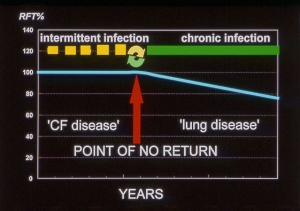 infection people with CF can be considered to be in the phase of “CF Disease” i.e. they have various physicochemical alterations in the electrolyte and liquid composition of the airway fluid but no tissue damage. Although they develop respiratory infections these can be eradicated, if treated early with antibiotics and their respiratory function remains stable.
infection people with CF can be considered to be in the phase of “CF Disease” i.e. they have various physicochemical alterations in the electrolyte and liquid composition of the airway fluid but no tissue damage. Although they develop respiratory infections these can be eradicated, if treated early with antibiotics and their respiratory function remains stable.
However eventually a new respiratory infection is not eradicated and chronic infection of the tissues becomes established. At this stage the patient then enters the phase of “Lung disease” where infection and chronic inflammation become established, self perpetuating and progress independently of the basic CFTR abnormality – this change is referred to as the “Point of no return” and there follows a slow deterioration in their condition, the speed of which is determined by the type and intensity of treatment they receive.
This reviewer, as a clinician who has personally treated and observed hundreds of children with CF over many years, accepts this concept suggested Drittanti is exactly what happens – I have illustrated it in the accompanying figure. The effort in preventing children passing the “point of no return” does, at times, involve in quite intensive treatment for children who do not appear particularly ill. For example, a new cough which does not clear with oral antibiotics would be treated with a course of IV antibiotics even though the child was not unwell. So the aim of modern treatment is to avoid passing the “Point of no return” i.e. prevent or delay for as long as possible the onset of chronic infection of the airways.
Hubert D, Chiron R, Camara B, Grenet D, Prévotat A, Bassinet L, Dominique S, Rault G, Macey J, Honoré I, Kanaan R, Leroy S, Desmazes Dufeu N, Burgel PR. Real-life initiation of lumacaftor/ivacaftor combination in adults with cystic fibrosis homozygous for the Phe508del CFTR mutation and severe lung disease. J Cyst Fibros 2017;16(3):388-91.[Pubmed]

Fig 38. Dominique Hubert
A study to investigate the short-term adverse events and effectiveness of lumacaftor/ivacaftor combination treatment in adults with cystic fibrosis (CF) and severe lung disease in a real life setting. A multicentre observational study investigated adverse events, treatment discontinuation, FEV1 and body mass index (BMI) one month and three months after lumacaftor/ivacaftor initiation in adults with CF and FEV1 below 40% predicted.
Respiratory adverse events (AEs) were reported by 27 of 53 subjects (51%) and 16 (30%) discontinued treatment. The mean absolute change in FEV1 was +2.06% after one month of treatment (P=0.086) and +3.19% after 3 months (P=0.009). BMI was unchanged.
The authors concluded treatment with lumacaftor/ivacaftor in patients with CF and severe lung disease was discontinued more frequently than reported in clinical trials, due to respiratory adverse events. Nevertheless, the patients who continued treatment had an increase in lung function comparable to what was observed in pivotal trials.
Dr. Dominique Hubert (fig.38) set up the CF Center at the Hospital Cochin, Paris in 1986. She is involved in the clinical and research aspects of CF and coordinates the activity of the Resource Center and Competence Center for CF.
Horsley A, Barry P. Orkambi in patients with severe disease – Bumps in the road to CFTR modulation. J Cyst Fibros. 2017 May;16(3):11-312. doi: 10.1016/j.jcf.2017.04.008. Epub 2017 Apr 20.[Pubmed]

Fig 39. Alex Horsley
(This is a very helpful article I have covered here in some detail as there is no abstract on PubMed)
CFTR modulation therapies offer the promise to patients and clinicians that true disease modification in CF is possible. In this issue of the journal, we can examine the first published reports of the effects of lumacaftor/ivacaftor (Orkambi™) in clinical practice (Popowicz et al, 2017 [Pubmed] Hubert D et al, 2017 [Pubmed]. Two studies report on patients too ill to qualify for the pivotal phase 3 studies. Although lacking the rigour of clinical trials, these reports provide important and consistent observations that appear to differ from the trials [Wainwright et al, 2015 [Pubmed]; Boyle MP et al, 2014 [Pubmed].
The headline news is that tolerability of Orkambi in patients with FEV1 < 40% predicted is substantially worse than in the registration studies. The authors report discontinuation rates of 25 and 30% before 3 months, the majority due to adverse respiratory events. This stands in striking contrast to the discontinuation rate of 4.6% at the equivalent dose in the phase 3 trials. Hubert et al. describe respiratory adverse events in 51% of patients commencing therapy and Popowicz et al. report similar events in 83% within 24 h, which persisted in two thirds at 1 month. They also report acute deterioration in lung function, including a mean fall in FEV1 of 20% at 1 h. This is very substantial, and potentially destabilising in patients with a median FEV1 of 36% predicted at baseline. These findings raise several questions.
Could these results have been anticipated?
The consistency of both reports suggests that these findings are reflective of the true experience of this compound in clinical practice in patients with low baseline lung function.
What is the cause of these adverse events?
Similar events were not described with ivacaftor monotherapy (Wainwright CE et al, 2015 [Pubmed]; Barry PJ et al, 2014[Pubmed], so the respiratory adverse events described here are almost certainly related to lumacaftor. In the phase 2 trials, there was also a dose related decrement in FEV1 in the lumacaftor monotherapy arm [Boyle MP et al, 2014]. Interestingly, these effects appear to be worse after initiation of the medication, and may abate with time [Konstan et al, 2017 [Pubmed]. Withdrawal of therapy appears to lead to resolution of these symptoms.
Events described as dyspnoea and chest tightness were accompanied by an acute fall in FEV1. Similar decline in FEV1 has also been reported in healthy controls challenged with lumacaftor. In healthy subjects the acute FEV1 decline was attenuated by bronchodilator therapy, leading to speculation that it was caused by bronchospasm (Marigowda et al, 2017 [Pubmed]. Unfortunately, a protective effect of bronchodilators was not witnessed in the studies reported in this issue, and in the study by Popowicz additional bronchodilators did not reverse the fall in FEV1. Popowicz speculates that the phenomenon may instead be due to changing hydration of the airway mucus. Whilst this may be contributory, it doesn’t explain why the same tightness was absent in Gly551Asp patients with severe disease treated with ivacaftor [Barry et al, 2014 [Pubmed]. Nor has this featured in the early reports of the pipeline modulator VX-661 (tezacaftor), which restores CFTR function to a similar level (Pilewski J et al, 2015 [Pubmed] and in a recent press release seems to be at least as effective at improving FEV1. It would therefore appear most likely that this is an off-target effect, but without a clear explanation the treatment to mitigate it also remains uncertain.
What are the clinical implications of these findings?
To prescribe a therapy, which will likely cause adverse events in patients with severe lung disease, requires confidence that it will ultimately be effective. In the phase 3 subgroup analysis by Elborn, patients with FEV1 <40% predicted showed the greatest improvement [Elborn et al, 2016 [Pubmed].. However, these subjects had declined between screening and baseline assessment, so their improvement is at least partially regression back to true baseline. Popowicz describes high rates of ongoing symptoms at 1 month, and no change in lung function. Hubert however reports that in those who tolerate and continue treatment, similar lung function improvements to that in the clinical trials can be achieved, with an absolute increase of 5% in FEV1 seen in a third of patients. Ultimately, lung function changes may not be as important as establishing the effect on exacerbations, which was the clearest demonstration of benefit for a severe Gly551Asp cohort treated with ivacaftor [Barry P J et al, 2014 [Pubmed] The reviewers suggest that as health care professionals, we may need to temper enthusiasm to provide realistic counsel to patients. Media reports of a ‘life-saving’ therapy may mean that the common failure to tolerate therapy can be perceived as disastrous. Our mantra: this may help you feel better, but we might see very little change in lung function and you might well feel worse when you first start taking it. Now we need to quantify these observations to better predict who will benefit, and whether tolerance can be improved, for a population awaiting the realisation of hope.
Dr.Alex Horsley (fig. 39) is Senior Lecturer and Consultant in Respiratory Medicine at The University of Manchester and Manchester Adult CF Centre.
Janhsen WK, Arnold C, Hentschel J, Lehmann T, Pfister W, Baier M, Böer K, Hünniger K, Kurzai O, Mainz JG. Colonization of CF patients’ upper airways with S. aureus contributes more decisively to upper airway inflammation than P. aeruginosa. Microbiol Immunol 2016 Oct;205(5):485-500. doi: 10.1007/s00430-016-0463-0. Epub 2016 Jul 4. pubmed.ncbi.nlm.nih.gov/27377929/
In cystic fibrosis (CF) patients’ airways, inflammatory processes decisively contribute to remodelling and pulmonary destruction. The aims of this study were to compare upper airway (UAW) inflammation in the context of Staphylococcus aureus and Pseudomonas aeruginosa colonization in a longitudinal setting, and to examine further factors influencing UAW inflammation.
The results indicate that UAW colonization with S. aureus significantly impacts the concentration of all measured inflammatory mediators in NL fluid except TIMP-1, whereas these effects were not significant for P. aeruginosa. Patients with S. aureus colonization of both the UAW and LAW showed significantly increased concentrations of IL-1β, IL-6, IL-8, MMP-9, and slightly elevated concentrations of NE in NL fluid compared to non-colonized patients. This work elaborates a survey on S. aureus’ virulence factors that may contribute to this underestimated pathology. Serial assessment of epithelial lining fluid by NL reveals that colonization of the UAW with S. aureus contributes more to CF airway inflammatory processes than hitherto expected.
—- These results are not surprising remembering that for many years S. aureus was the main pathogen leading to fatal destruction of the lungs in CF children who died. I certainly remember such children who died in the Sixties and Seventies where S. aureus appeared to be the only pathogen in their lungs. It is surprising that the presence of S. aureus is tolerated in so many CF units – but not all. For example in Copenhagen and Leeds. S. aureus can and should always be eradicated but, as in the case of Pseudomonas, this is not possible once the infection becomes chronic and well established.
Wibke Katharina Janssen is in the Department of Pediatrics, Cystic Fibrosis Center, Jena University Hospital, Kochstrasse 2, 07745, Jena, Germany.
Jelin AC; Sharshiner R; Caughey AB. Maternal co-morbidities and neonatal outcomes associated with cystic fibrosis. J Maternal-Fetal Neo M 2017; 30(1):4-7.[Pubmed]

Fig 40. Angela Jelin
This is a retrospective cohort study of 2 178 954 singleton pregnancies at>=20 weeks’ gestation with and without CF in the state of California during the years 2005-2008. The cohort included 2 178 954 pregnancies of which 77 mothers had CF. Mothers with CF were more likely to have pre-gestational diabetes and had higher rates of primary cesarean delivery. Neonates delivered to mothers with CF were more likely to be born preterm and have congenital anomalies but otherwise were not at increased risk for significant neonatal morbidity or mortality when adjusted for gestational age.
Mothers with CF are more likely to have pre-gestational diabetes, deliver preterm (<37 weeks gestation) and have a primary cesarean delivery. Infants are more likely to have congenital anomalies. The authors recommend that in addition to early diabetic screening and genetic counseling, a detailed fetal anatomy ultrasound should be performed in women with CF.
Dr Angie Jelin (fig. 40) is a maternal-fetal medicine specialist who practices in Washington, DC. She is affiliated with Medstar Washington Hospital Center. She is assistant director of prenatal genetics at the Prenatal Diagnostics Center in the Division of Maternal-Fetal Medicine and an assistant professor in the Johns Hopkins Medicine Department of Gynecology and Obstetrics.
Knauf F, Thomson RB, Heneghan JF, Jiang Z, Adebamiro A,Asplin JR, Egan ME, Alper SL, Aronson PS. Loss of Cystic Fibrosis Transmembrane Regulator Impairs Intestinal Oxalate Secretion. J Am Soc Nephrol. 2017 Jan;28(1):242-249. doi: 10.1681/ASN.2016030279. Epub 2016 Jun 16. [Pubmed]

Fig. 41 Felix Knauf
Yale School of Medicine
Patients with cystic fibrosis have an increased incidence of hyperoxaluria and calcium oxalate nephrolithiasis. Net intestinal absorption of dietary oxalate results from passive paracellular oxalate absorption as modified by oxalate back secretion mediated by the SLC26A6 oxalate transporter. The authors used mice deficient in the cystic fibrosis transmembrane conductance regulator gene (Cftr) to test the hypothesis that SLC26A6-mediated oxalate secretion is defective in cystic fibrosis. In association with the profound defect in intestinal oxalate secretion, Cftr-/- mice had serum and urine oxalate levels 2.5-fold greater than those of wild-type mice.
The authors concluded that defective intestinal oxalate secretion mediated by SLC26A6 may contribute to the hyperoxaluria observed in this mouse model of cystic fibrosis. They suggest future studies are needed to address whether similar mechanisms contribute to the increased risk for calcium oxalate stone formation observed in patients with cystic fibrosis.
– The reported incidence of renal stones and nephrocalcinosis in CF is between 3% and 6% compared to 1% to 2% in age-matched controls.
Felix Knauf (fig 41) is at the Department of Internal Medicine, Yale and the Department of Nephrology and Hypertension, Friedrich Alexander Universität Erlangen-Nürnberg, Erlangen, Germany.
Konstan MW, McKone EF2 Moss RB, Marigowda G, Tian S, Waltz D, Huang X, Lubarsky B, Rubin J, Millar SJ, Pasta DJ, Mayer-Hamblett N, Goss CH, Morgan W, Sawicki GS. Assessment of safety and efficacy of long-term treatment with combination lumacaftor and ivacaftor therapy in patients with cystic fibrosis homozygous for the F508del-CFTR mutation (PROGRESS): a phase 3, extension study. Lancet Respir Med. 2017 Feb;5(2):107-118. doi: 10.1016/S2213-2600(16)30427-1. Epub 2016 Dec 21 [Pubmed]
The 24-week safety and efficacy of lumacaftor/ivacaftor combination therapy was shown in two randomised controlled trials (RCTs)-TRAFFIC and TRANSPORT-in patients with cystic fibrosis who were aged 12 years or older and homozygous for the F508del-CFTR mutation. [full details in PubMed]
The long-term safety profile of lumacaftor/ivacaftor combination therapy was consistent with previous RCTs. Benefits continued to be observed with longer-term treatment, and lumacaftor/ivacaftor was associated with a 42% slower rate of ppFEV1 decline than in matched registry controls.
Kopp BT; Ortega-Garcia JA; Sadreameli SC; Wellmerling J; Cormet-Boyaka E; Thompson R; McGrath-Morrow S; Groner JA. The Impact of Secondhand Smoke Exposure on Children with Cystic Fibrosis: A Review. Int J Environ Res Public Health [Electronic Resource]. 13(10), 2016 Oct 12. [Pubmed]

Fig 42. Benjamin Kopp
This review examines what is known regarding the prevalence of SHSe (second hand smoke exposure) in CF, with the majority of reviewed studies utilizing parental-reporting of SHSe without an objective biomarker of exposure. A wide range of SHSe is reported in children with CF, but under-reporting is common in studies involving both reported and measured SHSe. Additionally, the impact of SHSe on respiratory and nutritional health is discussed, with potential decreases in long-term lung function, linear growth, and weight gain noted in CF children with SHSe. Immunologic function in children with CF and SHSe remains unknown. The impact of SHSe on cystic fibrosis transmembrane conductance regulator (CFTR) function is also examined, as reduced CFTR function may be a pathophysiologic consequence of SHSe in CF and could modulate therapeutic interventions. Finally, potential interventions for on going SHSe are delineated along with recommended future areas of stu
— This is a very interesting and extensively referenced review of the effects of second hand smoke exposure in people with CF. The full article is available via PubMed link.
Benjamin T Kopp (fig. 42) is Assistant Professor of Pediatrics at the Ohio State University College of Medicine.
Langton Hewer SC; Smyth AR. Antibiotic strategies for eradicating Pseudomonas aeruginosa in people with cystic fibrosis. [Review][Update of Cochrane Database Syst Rev. 2014 Nov 10;(11):CD004197; PMID: 25383937] Cochrane Database of Systematic Reviews. 4:CD004197, 2017 04 25. [Pubmed]

Fig 43. Simon Langton-Hewer
The authors’ main conclusions were that nebulised antibiotics, alone or in combination with oral antibiotics, were better than no treatment for early infection with Pseudomonas aeruginosa. Eradication may be sustained for up to two years. However, they consider there is insufficient evidence to determine whether antibiotic strategies for the eradication of early Pseudomonas aeruginosa decrease mortality or morbidity, improve quality of life, or are associated with adverse effects compared to placebo or standard treatment. Four trials comparing two active treatments have failed to show differences in rates of eradication of Pseudomonas aeruginosa. There have been no published randomised controlled trials that investigate the efficacy of intravenous antibiotics to eradicate Pseudomonas aeruginosa in cystic fibrosis. Overall, there is still insufficient evidence from this review to state which antibiotic strategy should be used for the eradication of early Pseudomonas aeruginosa infection in cystic fibrosis.
Simon Langton-Hewer (fig. 43) is a consultant paediatrician in Bristol who organised the Torpedo trial on the role of IV antibiotics in the eradication of early P. aeruginosa infection which showed IV therapy to be no better than oral antibiotic treatment for eradicating initial P. aeruginosa infection.
—- The authors’ conclusions from this present extensive Cochrane review deserves comment, in particular – “There is insufficient evidence to determine whether antibiotic strategies for the eradication of early Pseudomonas aeruginosa decrease mortality or morbidity, improve quality of life, or are associated with adverse effects compared to placebo or standard treatment”. Although trials conforming to rigorous Cochrane standards may not be available, there is now a wealth of published evidence and experience that avoidance or delay of chronic P. aeruginosa infection by eradication certainly does decrease morbidity and improve the quality of life.
For example the 2015 statement on the CF Foundation’s website is unequivocal and reads – “Chronic infection with P. aeruginosa is associated with increased morbidity and mortality. Effective regimens include antibiotic therapy for newly acquired infection and routine surveillance with oropharyngeal cultures”. Other relevant publications include the following –
Nixon GM, Armstrong DS, Carzino R, Carlin JB, Olinsky A, Robertson CF, et al. Clinical outcome after early Pseudomonas aeruginosa infection in cystic fibrosis. J Pediatr. 2001;138(5):699–704. http://dx.doi.org/10.1067/mpd.2001.112897 [PubMed]
‘Acquisition of P aeruginosa was common by 7 years of age in this CF birth cohort and was associated with increased morbidity and mortality (J Pediatr 2001;138:699-704)’
Hudson VL, Wielinski CL, Regelmann WE. Prognostic implications of initial oropharyngeal bacterial flora in patients with cystic fibrosis diagnosed before the age of two years. J Pediatr. 1993;122(6):854–860. http://dx.doi.org/10.1016/S0022-3476(09)90007-5 [PubMed]
P. aeruginosa in initial oropharyngeal cultures from patients ≤2 years of age with cystic fibrosis was associated with significantly increased morbidity, and the finding of P. aeruginosa and S. aureus together in initial oropharyngeal cultures with a significantly increased mortality rate during the first 10 years after diagnosis.
Kosorok MR, Zeng L, West SE, Rock MJ, Splaingard ML, Laxova A, et al. Acceleration of lung disease in children with cystic fibrosis after Pseudomonas aeruginosa acquisition. Pediatr Pulmonol. 2001;32(4):277–287. http://dx.doi.org/10.1002/ppul.2009.abs [PubMed]
“Our data show that Pa acquisition is associated with declining pulmonary status in children with CF, and that this effect is probably gradual rather than precipitous. Because these patients were diagnosed and treated aggressively, our estimates of the effects of Pa acquisition may be conservative.”
Emerson J, Rosenfeld M, McNamara S, Ramsey B, Gibson RL. Pseudomonas aeruginosa and other predictors of mortality and morbidity in young children with cystic fibrosis. Pediatr Pulmonol. 2002;34(2):91–100. http://dx.doi.org/10.1002/ppul.10127 [PubMed]
The authors conducted a registry-based study to determine prognostic indicators of 8-year mortality and morbidity in young children with cystic fibrosis (CF). Patients ages 1–5 years from the 1990 U.S. Cystic Fibrosis Foundation (CFF) National Patient Registry served as the study cohort (N = 3,323). Registry data provided information on baseline characteristics in 1990, 8-year mortality, and clinical outcomes in 1998. P. aeruginosa respiratory infection was found to be a major predictor of morbidity and mortality. The 8-year risk of death was 2.6 times higher in patients who had respiratory cultures positive for P. aeruginosa in 1990 (95% confidence interval 1.6, 4.1) than in children without P. aeruginosa in their respiratory cultures. Culture-positive patients in 1990 also had a significantly lower percent predicted forced expiratory volume in 1 sec (FEV1) and weight percentile at follow-up, and they had an increased risk of continued P. aeruginosa respiratory infection and hospitalisation for acute respiratory exacerbation in 1998. Among the other predictors of increased morbidity and mortality were lower baseline weight percentiles and number of CF-related hospitalisations during the baseline year.
—- So one must seriously question the authors’ conclusions, or indeed the validity of Cochrane Reviews, regarding the adverse effects following acquisition of P. aeruginosa and the advantages of avoiding chronic infection.

Fig 44. Gillian Levelle
Lavelle GM, White MM, Browne N, McElvaney NG, Reeves EP. Animal Models of Cystic Fibrosis Pathology: Phenotypic Parallels and Divergences. Biomed Res Int. 2016;2016:5258727. doi: 10.1155/2016/5258727. Epub 2016 Jun 1. [27340661] Free PMC article
Much knowledge surrounding the pathophysiology of the disease has been gained through the generation of animal models, despite inherent limitations in each. The failure of certain mouse models to recapitulate the phenotypic manifestations of human disease has initiated the generation of larger animals in which to study CF, including the pig and the ferret.
This review summarises the basic phenotypes of three animal models and describe the contributions of such animal studies to our current understanding of CF.
Dr. Gillian Lavelle (fig. 44) is Senior Scientific Writer at Novartis Ireland Ltd. She was awarded the 2016 Gerd Doring Award of the ECFS – awarded to honour an exceptional young European Scientist.
— This is an excellent review of the use of animal models in cystic fibrosis
Lee AL; Rawlings S; Bennett KA; Armstrong D. Pain and its clinical associations in individuals with cystic fibrosis: A systematic review. Chro Respir Dis 13(2):102-17, 2016 May.[Pubmed]

Fig 45. Ann Marie Lee
Pain is recognized as a clinical complication in cystic fibrosis (CF), but the prevalence, characteristics and clinical associations of this
co-morbidity have not been systematically reviewed. Electronic searches of six databases were performed. The pooled prevalence of pain in adults with CF was 77% (95% confidence interval (CI): 57%-92%) and in children was 42% (95% CI: 0%-91%). Common regions of pain included back, abdomen, chest and limbs. In children and adults, pain was associated with a poorer quality of life (QOL) and significant interference with treatments.
Pain is a surprisingly common problem in both children and adults with CF. It has negative clinical associations with QOL and the ability to successfully undertake treatment.
Anne Marie Lee (fig. 45) is post doctoral research fellow at West Park Healthcare Centre Canada. She is a physiotherapist and has published extensively on co-morbidities in chronic respiratory disorders.
Leung DH; Heltshe SL; Borowitz D; Gelfond D; Kloster M; Heubi JE; Stalvey M; Ramsey BW; Baby Observational and Nutrition Study (BONUS) Effects of Diagnosis by Newborn Screening for Cystic Fibrosis on Weight and Length in the First Year of Life. JAMA Pediatrics. 171(6):546-554, 2017 Jun 01. [Pubmed]

Fig 46. Daniel Leung
Since the implementation of universal newborn screening (NBS) for cystic fibrosis, the timing and magnitude of growth deficiency or its association with correlates of disease among infants with CF who underwent NBS has not been well described.
The objective was to examine incremental weight gain, linear growth, and clinical features in the first year of life among infants with CF who underwent NBS.
The Baby Observational and Nutrition Study (BONUS), a multicenter, longitudinal, observational cohort study, was conducted during regular CF clinic visits in the first 12 months of life at 28 US Cystic Fibrosis Foundation-accredited Care Centers from January 7, 2012, through May 31, 2015. Participants included 231 infants younger than 3.5 months who underwent NBS and had confirmed CF, with a gestational age of at least 35 weeks, birth weight of at least 2.5 kg, and toleration of full oral feeds. Of these, 222 infants (96.1%) had follow-up beyond 6 months of age and 215 (93.1%) completed 12 months of follow-up.
Main Outcome and Measures: Attained weight and length for age and World Health Organisation normative z scores at ages 1 to 6 and 8, 10, and 12 months (defined a priori). Of the 231 infants enrolled,110 infants (47.6%) were female and 121 (52.4%) were male, with a mean (SD) age of 2.58 (0.69) months. Infants had lower than mean birth weights (mean z score, -0.15; 95% CI,-0.27 to -0.04) and higher birth lengths (mean z score, 0.44; 95% CI, 0.26to 0.62). They achieved normal weight by 12 months, a significant improvement over a prescreening cohort of newborns with CF from 20 years before the contemporary cohort (mean z score increase, 0.57; 95% CI,0.37-0.77). However, length was lower than the mean at 12 months (mean z score, -0.56; 95% CI, -0.70 to -0.42). Only 30 infants (13.6%) were at less than the 10th percentile of weight for age, whereas 53 (23.9%) were at less than the 10th percentile of length for age at more than half their visits. Male sex, pancreatic insufficiency, meconium ileus, histamine blocker use, and respiratory Pseudomonas aeruginosa infection were associated with lower weight or length during the first year. Insulin like growth factor 1 levels were significantly lower among low-length infants. Persistently low-weight infants consumed significantly more calories, and weight and length z scores were negatively correlated with caloric intake.
The authors’ conclusions. Since initiation of universal NBS for CF, significant improvement has occurred in nutritional status, with normalisation of weight in the first year of life. However, length stunting remains common.
Daniel H Leung (fig.46) is a Paediatric Gastroenterologist and Assistant Professor of Pediatrics, Baylor College of Medicine, Houston.
— This study appears to support the suggestion that CF infants do have an intrinsic growth problem as has been suggested by others in previous studies.
Loo TW, Clarke DM. Corrector VX-809 promotes interactions between cytoplasmic loop one and the first nucleotide-binding domain of CFTR. Biochem Pharmacol. 2017 Jul 15;136:24-31. doi: 10.1016/j.bcp.2017.03.020. Epub 2017 Mar 31. [Pubmed]
A large number of correctors have been identified that can partially repair defects in folding, stability and trafficking of CFTR processing mutants that cause cystic fibrosis (CF). The best corrector, VX-809 (Lumacaftor), has shown some promise when used in combination with a potentiator (Ivacaftor) [ORKAMBI].
Understanding the mechanism of VX-809 is essential for development of better correctors. Here, the authors tested their prediction that VX-809 repairs folding and processing defects of CFTR by promoting interactions between the first cytoplasmic loop (CL1) of transmembrane domain 1 (TMD1) and the first nucleotide-binding domain (NBD1).
Their results (which are detailed in the full summary) suggest that the mechanism by which VX-809 promotes maturation and stability of CFTR is by promoting CL1/NBD1 interactions.
Tip W Loo is in the Department of Medicine, University of Toronto, Toronto, Ontario M5S 1A8, Canada; Department of Biochemistry, University of Toronto, Toronto, Ontario M5S 1A8, Canada.
Marigowda G, Liu F, Waltz D. Effect of bronchodilators in healthy individuals receiving lumacaftor/ivacaftor combination therapy. J Cyst Fibros. 2017 Mar;16(2):246-249. doi: 10.1016/j.jcf.2016.11.001. Epub 2016 Nov 25. 27894875 Free full text pubmed.ncbi.nlm.nih.gov/27894875/

Fig. 47 Gautham Marigowda
LinkedIn
In an open-label, single-center phase 1 pharmacokinetic study in healthy subjects who received lumacaftor (LUM) in combination with ivacaftor (IVA), review of spirometry data showed a transient decline in percent predicted forced expiratory volume in 1s (ppFEV1) within 4h of drug administration. An additional cohort of healthy subjects with normal baseline ppFEV1 values was studied to evaluate the ppFEV1 response to LUM/IVA administration and assess the effect of long-acting bronchodilators (LABDs) and short-acting bronchodilators (SABDs) on ppFEV1 response. The ppFEV1 decline observed at 4h was attenuated following administration of an LABD and reversed following administration of an SABD. Concomitant administration of LUM/IVA with bronchodilators was well tolerated.
These data show that a transient decline in ppFEV1 was observed in healthy subjects following administration of LUM/IVA combination therapy, which can be ameliorated with LABDs or SABDs.
Gautham Marigowda (fig.47) is with Vertex Pharmaceuticals Incorporated. He is Vice president and Head of Clinical Development, Cell and Gene Therapy.
Milla CE, Ratjen F, Marigowda G, Liu F, Waltz D, Rosenfeld M; VX13-809-011 Part B Investigator Group. Lumacaftor/Ivacaftor in Patients Aged 6-11 Years with Cystic Fibrosis and Homozygous for F508del-CFTR. Am J Respir Crit Care Med. 2017 Apr 1;195(7):912-920. doi: 10.1164/rccm.201608-1754OC [Pubmed]
Combination lumacaftor/ivacaftor has been shown to improve lung function and other endpoints in patients aged 12 years and older with cystic fibrosis and homozygous for F508del-CFTR, but it has not been assessed in younger patients. In this open-label phase III trial, we evaluated the safety, tolerability, pharmacodynamics, and efficacy of lumacaftor/ivacaftor combination therapy in patients aged 6-11 years with cystic fibrosis who were homozygous for F508del-CFTR. Patients (N = 58) received 200 mg lumacaftor/250 mg ivacaftor orally every 12 hours for 24 weeks in addition to their existing cystic fibrosis medications.
Lumacaftor/ivacaftor was well tolerated; the safety profile was generally similar to that observed in larger lumacaftor/ivacaftor trials with older patients. Four patients discontinued (two because of drug-related adverse events: elevated liver transaminases, n = 1; rash, n = 1). No safety concerns were associated with spirometry. No significant changes in percent predicted FEV1 were observed (change from baseline at Week 24, +2.5 percentage points; 95% confidence interval [CI], -0.2 to 5.2; P = 0.0671). At Week 24, significant improvements from baseline were observed in sweat chloride (-24.8 mmol/L; 95% CI, -29.1 to -20.5; P < 0.0001), body mass index z score (+0.15; 95% CI, 0.08 to 0.22; P < 0.0001), Cystic Fibrosis Questionnaire-Revised respiratory domain score (+5.4; 95% CI, 1.4 to 9.4; P = 0.0085), and lung clearance index based on lung volume turnover required to reach 2.5% of starting N2concentration (-0.88; 95% CI, -1.40 to -0.37; P = 0.0018).
CONCLUSIONS:
Lumacaftor/ivacaftor was well tolerated in this young population; no new safety concerns were identified. Improvements in lung clearance index, sweat chloride, nutritional status, and health-related quality of life were observed after 24 weeks of treatment.
Magruder JT, Crawford TC, Grimm JC, Shah AS, Bush EL, Higgins RS, Merlo CA. Risk Factors for De Novo Malignancy Following Lung Transplantation. Am J Transplant. 2017 Jan;17(1):227-238.[Pubmed]

Fig. 48 J Trent Magruder
LinkedIn
Risk factors for non-skin cancer de novo malignancy (DNM) after lung transplantation have yet to be identified. The authors queried the United Network for Organ Sharing database for all adult lung transplant patients between 1989 and 2012. Standardised incidence ratios (SIRs) were computed by comparing the data to Surveillance, Epidemiology, and End Results Program data after excluding skin squamous/basal cell carcinomas. They identified 18,093 adult lung transplant patients; median follow-up time was 1086 days (interquartile range 436-2070). De novo malignancy occurred in 1306 patients, with incidences of 1.4%, 4.6%, and 7.9% at 1, 3, and 5 years, respectively. The overall cancer incidence was elevated compared with that of the general US population (SIR 3.26, 95% confidence interval [CI]: 2.95-3.60). The most common cancer types were lung cancer (26.2% of all malignancies, SIR 6.49, 95% CI: 5.04-8.45) and lymphoproliferative disease (20.0%, SIR 14.14, 95% CI: 9.45-22.04). Predictors of DNM following lung transplantation were age (hazard ratio [HR] 1.03, 95% CI: 1.02-1.05, p < 0.001), male gender (HR 1.20, 95% CI: 1.02-1.42, p = 0.03), disease etiology (not cystic fibrosis, idiopathic pulmonary fibrosis or interstitial lung disease, HR 0.59, 95% CI 0.37-0.97, p = 0.04) and single-lung transplantation (HR 1.64, 95% CI: 1.34-2.01, p < 0.001). Significant interactions between donor or recipient smoking and single-lung transplantation were noted. On multivariable survival analysis, DNMs were associated with an increased risk of mortality (HR 1.44, 95% CI: 1.10-1.88, p = 0.009).
– These figures do not indicate a particular risk for people with CF?
J Trent Magruder (fig. 48) is a cardiothoracic surgeon in the Division of Cardiac Surgery, Johns Hopkins University School of Medicine, Baltimore, MD.
McColley SA. A safety evaluation of ivacaftor for the treatment of cystic fibrosis. Cardiopulmonary Comparative Physiology Expert Opin Drug Saf. 2016 May;15(5):709-15. [Pubmed]
Transaminitis (elevated transaminases) was noted in ivacaftor and combination lumacaftor-ivacaftor trials. Ivacaftor was associated with cataracts in juvenile rat pups in pre-clinical studies; non-congenital cataracts have been found in children taking ivacaftor. Ivacaftor is a CYP3A substrate; CYP3A inhibitors (Ketoconazole, Itraconazole, Fluconazole, Cimetidine, Clarithromycin, Erythromycin, Troleandomycin, Grapefruit juice) inducers should be avoided during its administration. Ivacaftor and its M1 metabolite may inhibit CYP3A and P-gp; therefore, ivacaftor may increase systemic exposure to drugs which are substrates of CYP3A and/or P-gp, increasing the potential for adverse events.
Ivacaftor therapy may be associated with ocular and hepatic side effects; specific recommendations for monitoring are available. Potential drug interactions should be evaluated in patients taking ivacaftor. High clinical efficacy suggests that the risk benefit ratio of ivacaftor favours therapy.
Susanna A McColley (fig. 2 above) is Professor of Pediatrics (Pulmonary Medicine) at Northwestern University.
McColley SA, Schechter MS, Morgan WJ, Pasta DJ, Craib ML, Konstan MW. Risk factors for mortality before age 18 years in cystic fibrosis. Pediatr Pulmonol. 2017 Jul;52(7):909-915. doi: 10.1002/ppul.23715. Epub 2017 Apr 24.
[Pubmed]
Data from the Epidemiologic Study of Cystic Fibrosis (ESCF) collected 1994-2005 were linked with the Cystic Fibrosis Foundation Patient Registry (CFFPR) demographic and mortality data from 2013. Among 5365 patients enrolled in ESCF who met inclusion criteria, 3880 (72%) were linked to the CFFPR. Among these, 191 (5.7%) died before age 18 years; median age at death was 13.4 ± 3.1 years. Multivariable regression showed clubbing, crackles, female sex, unknown CFTR genotype, minority race or ethnicity, Medicaid insurance (a proxy of low socioeconomic status), Pseudomonas aeruginosa on 2 or more cultures, and weight-for-age <50th percentile were significant risk factors for death regardless of inclusion of FEV1 at age 6-8 years in the model.
The authors identified multiple risk factors for childhood death of patients with CF, all of which remained important after incorporating FEV1 at age 6-8 years. Among the factors identified were the presence of clubbing or crackles at age 3-5 years, signs that are not routinely collected in registries.
— A study showing the increasing value of patient registries in confirming clinical impressions. Most clinicians would already recognise crackles, finger clubbing, low weight for age and poor economic status as very bad prognostic signs in children aged 3-5 yrs. Although most of the factors listed as risk factors for death before 18 years are not unexpected, confirmation using the patient registries is useful and presents opportunities for intervention. The need for very early intervention following diagnosis by neonatal screening to identify and prevent or control pulmonary infection is a major problem which many groups are addressing as a matter of urgency.
McGarry ME, Illek B, Ly NP, Zlock L, Olshansky S, Moreno C, Finkbeiner WE, Nielson DW. In vivo and in vitro ivacaftor response in cystic fibrosis patients with residual CFTR function: N-of-1 studies. Pediatr Pulmonol. 2017 Apr;52(4):472-479. doi: 10.1002/ppul.23659. Epub 2017 Jan 9. Full article.[Pubmed]

Fig 49. Megan McGarry
Some CF patients have CFTR in the epithelium with residual CFTR function. The effect of ivacaftor in these patients is unknown. This was a series of randomized, crossover N-of-1 trials of ivacaftor and placebo in CF patients ≥8 years old with potential residual CFTR function (as indicated by intermediate sweat chloride concentration, pancreatic sufficient, or mild bronchiectasis on chest CT). Human nasal epithelium (HNE) was obtained via nasal brushing and cultured. Sweat chloride concentration change was the in vivo outcome. Chloride current change in HNE cultures with ivacaftor was the in vitro outcome.
Three subjects had decreased sweat chloride concentration (-14.8 to -40.8 mmol/L, P < 0.01). Two subjects had unchanged sweat chloride concentration. Two subjects had increased sweat chloride concentration (+23.8 and +27.3 mmol/L, P < 0.001); both were heterozygous for A455E and pancreatic sufficient. Only subjects with decreased sweat chloride concentration had increased chloride current in HNE cultures.
The authors concluded some CF patients with residual CFTR function have decreased sweat chloride concentration with ivacaftor. Increased chloride current in human nasal epithelium cultures among subjects with decreased sweat chloride concentrations may predict clinical response to ivacaftor. Ivacaftor can increase sweat chloride concentration in certain mutations with unclear clinical effect.
Dr. Meghan McGarry (fig. 49) is assistant professor and pediatric pulmonologist at the University of California, San Francisco.
McKinzie CJ, Goralski JL, Noah TL, Retsch-Bogart GZ, Prieur MB. Worsening anxiety and depression after initiation of lumacaftor/ivacaftor combination therapy in adolescent females with cystic fibrosis. J Cyst Fibros. 2017 Jul;16(4):525-527. doi: 10.1016/j.jcf.2017.05.008. Epub 2017 Jun 8.[Pubmed]

Fig 50. Cameron McKinzie
In both phase III studies of lumacaftor/ivacaftor, as well as an extension study, worsening of mental health was not reported as a common side effect. Here the authors describe five cases in adolescent female patients that suggest a worsening of anxiety or depression associated with its use. In these five patients, two experienced suicidal ideation and three made suicide attempts that resulted in psychiatric hospitalizations.
Dr. Cameron Jordan McKinzie (fig. 50) is a Clinical Specialist, Pediatric Pulmonology, Pharmacy Department, University of North Carolina Children’s Hospital.
Milla CE, Ratjen F, Marigowda G, Liu F, Waltz D, Rosenfeld M; VX13-809-011 Investigator Group. Lumacaftor/Ivacaftor in Patients Aged 6-11 Years with Cystic Fibrosis and Homozygous for F508del-CFTR. Am J Respir Crit Care Med. 2017 Apr 1;195(7):912-920. doi: 10.1164/rccm.201608-1754OC. [Pubmed]

Fig 51. Carlos Milla
Combination lumacaftor/ivacaftor has been shown to improve lung function and other endpoints in patients aged 12 years and older with cystic fibrosis and homozygous for F508del-CFTR, but it has not been assessed in younger patients.
In this open-label phase III trial, the authors evaluated the safety, tolerability, pharmacodynamics, and efficacy of lumacaftor/ivacaftor combination therapy in patients aged 6-11 years with cystic fibrosis who were homozygous for F508del-CFTR. Patients (N = 58) received 200 mg lumacaftor/250 mg ivacaftor orally every 12 hours for 24 weeks in addition to their existing cystic fibrosis medications.
Lumacaftor/ivacaftor was well tolerated; the safety profile was generally similar to that observed in larger lumacaftor/ivacaftor trials with older patients. Four patients discontinued (two because of drug-related adverse events: elevated liver transaminases, n = 1; rash, n = 1). No safety concerns were associated with spirometry. No significant changes in percent predicted FEV1 were observed (change from baseline at Week 24, +2.5 percentage points; 95% confidence interval [CI], -0.2 to 5.2; P = 0.0671). At Week 24, significant improvements from baseline were observed in sweat chloride (-24.8 mmol/L; 95% CI, -29.1 to -20.5; P < 0.0001), body mass index z score (+0.15; 95% CI, 0.08 to 0.22; P < 0.0001), Cystic Fibrosis Questionnaire-Revised respiratory domain score (+5.4; 95% CI, 1.4 to 9.4; P = 0.0085), and lung clearance index based on lung volume turnover required to reach 2.5% of starting N2 concentration (-0.88; 95% CI, -1.40 to -0.37; P = 0.0018).
The authors concluded Lumacaftor/ivacaftor was well tolerated in this young population; no new safety concerns were identified. Improvements in lung clearance index, sweat chloride, nutritional status, and health-related quality of life were observed after 24 weeks of treatment.
Dr. Carlos Milla (fig. 51) is Professor of Pediatrics (Pulmonary Medicine) at the Lucile Salter Packard Children’s Hospital, Sanford.
Muhlebach MS, Beckett V, Popowitch E, Miller MB, Baines A, Mayer-Hamblett N, Zemanick ET, Hoover WC, VanDalfsen JM, Campbell P, Goss CH; STAR-too study team. Microbiological efficacy of early MRSA treatment in cystic fibrosis in a randomised controlled trial. Thorax. 2017 Apr;72(4):318-326. doi: 10.1136/thoraxjnl-2016-208949. Epub 2016 Nov 15. [Pubmed]

Fig 52. Marianne Muhlbach
To evaluate microbiological effectiveness, that is, culture negativity, of a non-blinded eradication protocol (Rx) compared with observation (Obs) in clinically stable cystic fibrosis participants with newly positive methicillin resistant Staphylococcus aureus (MRSA) cultures. This non-blinded trial randomised participants ages 4-45 years with first or early (≤2 positive cultures within 3 years) MRSA-positive culture without MRSA-active antibiotics within 4 weeks 1:1 to Rx or Obs. The Rx protocol was: oral trimethoprim-sulfamethoxazole or if sulfa-allergic, minocycline plus oral rifampin; chlorhexidine mouthwash for 2 weeks; nasal mupirocin and chlorhexidine body wipes for 5 days and environmental decontamination for 21 days. The primary end point was MRSA culture status at day 28.
Between 1 April 2011 to September 2014, 45 participants (44% female, mean age 11.5 years) were randomised (24 Rx, 21 Obs). At day 28, 82% (n=18/22) of participants in the Rx arm compared with 26% (n=5/19) in the Obs arm were MRSA-negative. Adjusted for interim monitoring, this difference was 52% (95% CI 23% to 80%, p<0.001). Limiting analyses to participants who were MRSA-positive at the screening visit, 67% (8/12) in the Rx arm and 13% (2/15) in the Obs arm were MRSA-negative at day 28, adjusted difference: 49% (95% CI 22% to 71%, p<0.001). Fifty-four per cent in the Rx arm compared with 10% participants in the Obs arm remained MRSA-negative through day 84. Mild gastrointestinal side effects were higher in the Rx arm.
The authors concluded this MRSA eradication protocol for newly acquired MRSA demonstrated microbiological efficacy with a large treatment effect.
Marianne S Muhlebach (fig. 52) is Professor and Paediatric pulmonologist at UNC School of Medicine.
Nichols DP, Happoldt CL, Bratcher PE, Caceres SM, Chmiel JF, Malcolm KC, Saavedra MT, Saiman L, Taylor-Cousar JL, Nick JA. Impact of azithromycin on the clinical and antimicrobial effectiveness of tobramycin in the treatment of cystic fibrosis. J Cyst Fibros. 2017 May;16(3):358-366. doi: 10.1016/j.jcf.2016.12.003. Epub 2016 Dec 24.[Pubmed]

Fig 53. David Nichols
Concomitant use of oral azithromycin and inhaled tobramycin occurs in approximately half of US cystic fibrosis (CF) patients. Recent data suggest that this combination may be antagonistic. To test the hypothesis that azithromycin reduces the clinical benefits of tobramycin by analyses of clinical trial data, in vitro modelling of P. aeruginosa antibiotic killing, and regulation of the MexXY efflux pump. Ongoing administration of azithromycin associates with reduced ability of inhaled tobramycin, as compared with aztreonam, to improve lung function and quality of life in a completed clinical trial. In users of azithromycin FEV1 (L) increased 0.8% during a 4-week period of inhaled tobramycin and an additional 6.4% during a subsequent 4-week period of inhaled aztreonam (P<0.005). CFQ-R respiratory symptom score decreased 1.8 points during inhaled tobramycin and increased 8.3 points during subsequent inhaled aztreonam (P<0.001). A smaller number of trial participants not using azithromycin had similar improvement in lung function and quality of life scores during inhaled tobramycin and inhaled aztreonam. In vitro, azithromycin selectively reduced the bactericidal effects tobramycin in cultures of clinical strains of P. aeruginosa, while up regulating antibiotic resistance through MexXY efflux.
The authors concluded azithromycin appears capable of reducing the antimicrobial benefits of tobramycin by inducing adaptive bacterial stress responses in P. aeruginosa, suggesting that these medications together may not be optimal chronic therapy for at least some patients. The authors are now conducting a prospective trial to test the impact of adding oral azithromycin to inhaled tobramycin in subjects with CF and chronic P. aeruginosa infection
Dave P Nichols (fig. 53) is in the Department of Pediatrics, Seattle Children’s Hospital, University of Washington School of Medicine, Seattle, WA, United States.
O’Neill K; Tunney MM; Johnston E; Rowan S; Downey DG; Rendall J; Reid A; Bradbury I; Elborn JS; Bradley JM. Lung Clearance Index in Adults and Children With Cystic Fibrosis. Chest. 150(6):1323-1332, 2016 Dec. [Pubmed]

Fig 54. Katherine O’Neill
Lung clearance index (LCI) has good clinimetric properties and an acceptable feasibility profile as a surrogate end point in cystic fibrosis (CF). Although most studies to date have been in children,increasing numbers of adults with CF also have normal spirometric findings. Further study of LCI as an end point in adults with CF is required. Therefore, the purpose of this study was to determine the clinimetric properties of LCI across the age range of people with CF. Clinically stable adults and children with CF and age-matchedhealthy control subjects were recruited. LCI and spirometry data for 110 subjects with CF and 61 control subjects were collected at a stable visit. The CF Questionnaire-Revised (CFQ-R) was completed by 80 of 110 subjects with CF. Fifty-six subjects with CF completed a second stable visit. The LCI coefficient of variation percent was 4.1% in adults and 6.3% in children with CF. The coefficient of repeatability of LCI was 1.2 in adults and 1.3 in children. In both adults and children, LCI (area under the receiving operator characteristic curve [AUCROC] = 0.93 and 0.84, respectively) had greater combined sensitivity and specificity to discriminate between people with CF and control subjects when compared with FEV1 (AUCROC = 0.88 and 0.60,respectively) and forced expiratory flow at 25% to 75% of the curve (AUCROC = 0.87 and 0.68, respectively). LCI correlated significantly with the CFQ-R treatment burden in adults (r = -0.37; P < .01) and children (r= -0.50; P < .01). Washout tests were successful in 90% of subjects with CF and were perceived as comfortable and easy to perform in both adults and children. The authors suggest these data support the use of LCI as a surrogate outcome measure in CF clinical trials in adults as well as in children.
Dr. Katherine O’Neill (fig. 54) is Clinical Research Fellow at the School of Medicine, Dentistry and Biomedical Sciences Centre for Experimental Medicine, Belfast.
O’Neill K, Moran F, Tunney MM, Elborn JS, Bradbury I, Downey DG, Rendall J, Bradley JM. Timing of hypertonic saline and airway clearance techniques in adults with cystic fibrosis during pulmonary exacerbation: pilot data from a randomised crossover study. Open Respir Res. 2017 Jan 12;4(1):e000168. doi: 10.1136/bmjresp-2016-000168. eCollection 2017.[Pubmed]
The optimal timing of treatment with hypertonic saline (HTS) and airway clearance techniques (ACT) is unknown. This study hypothesised that HTS before ACT would be more effective than HTS during ACT as measured by Lung Clearance Index (LCI). Thirteen adults with CF providing written informed consent were randomised to a crossover trial of HTS before ACT or HTS during ACT on consecutive days. ACT treatment consisted of Acapella Duet.
In this pilot study, HTS before ACT was no more effective than HTS during ACT as measured by LCI.
— One would imagine that taking the hypertonic saline before rather than after ACT would be more effective but this appears not to be the case. Interestingly, it is also the case that rhDNase is just as effective whether taken before or after airway clearance; in fact in one study those chronically infected with P. aeruginosa derived more benefit when administered after physiotherapy (Dentice R, Elkins M. Timing of dornase alpha inhalation for cystic fibrosis. Cochrane Database Syst Rev 2011;(5):Cd007923). Dentice and Elkins most recent advice is – “in the absence of strong evidence to indicate that one timing regimen is better than another, the timing of dornase alpha inhalation can be largely based on pragmatic reasons or individual preference with respect to the time of airway clearance and time of day. They suggest further research is warranted ‘[Pubmed]
— Although the usual conclusion of Cochrane Reviewers is that “further research is warranted” it would seem reasonable to take their present advice and time the hypertonic saline according to the benefit and life style of the patient.
Ong T, Marshall SG, Karczeski BA, Sternen DL, Cheng E, Cutting GR. Editors. In: Adam MP, Ardinger HH, Pagon RA, Wallace SE, Bean LJH, Stephens K, Amemiya A, editors. Source GeneReviews® [Internet]. Seattle (WA): University of Washington, Seattle; 1993-2018. 2001 Mar 26 [updated 2017 Feb 2].[Pubmed]
This is detailed review of current knowledge and management of men with congenital absence of the vas deferens.
Pisaturo M, Deppen A, Rochat I, Robinson WM, Hafen GM. Death after cessation of treatment by cystic fibrosis patients: An international survey of clinicians. Palliat Med. 2017 Jan;31(1):82-88. doi: 10.1177/0269216316637773. Epub 2016 Jul 10.[Pubmed]
More than 200 cystic fibrosis patients not considered to be terminally ill and, who voluntarily ceased treatment, were reported by the clinicians surveyed. Detailed data were reported in 102 patients (4 children, 25 adolescents and 73 adults). Only one child, six adolescents and one adult were judged by clinicians not to be competent to make the decision to stop treatment. Time-consuming and low immediate-impact therapies, such as respiratory physiotherapy, were most frequently discontinued. Resignation was the main reported reason for discontinuing treatment, followed by reactive depression and lack of familial support. A total of 69% of the patients received palliative care and 72% died in the 6 months following cessation of treatment. Death of cystic fibrosis patients, not considered to be terminally ill, is reported in Europe, the United States and Australia due to voluntary cessation of treatment.
— Although there is great optimism regarding the improving outlook for people with CF, it remains a very demanding and life-changing condition.
Marisa Pisaturo is the Faculty of Biology and Medicine, University of Lausanne, Lausanne, Switzerland.
Padoan R; Poli P; Colombrita D; Borghi E; Timpano S; Berlucchi M. Acute Scedosporium apiospermum Endobronchial Infection in Cystic Fibrosis. Pediatr Infect Dis J 2016 35(6):701-2. [Pubmed]
Fungi are known pathogens in cystic fibrosis patients. A boy with cystic fibrosis presented with acute respiratory distress. Bronchoscopy showed airways obstruction by mucus plugs and bronchial casts. Scedosporium apiospermum was identified as the only pathogen.
Bronchoalveolar lavage successfully resolved the acute obstruction. Plastic bronchitis is a new clinical picture of acute Scedosporium endobronchial colonisation in cystic fibrosis patients.
Pauna HF, Monsanto RC, Kurata N, Paparella MM, Cureoglu S. Changes in the inner ear structures in cystic fibrosis patients. J Pediatr Otorhinolaryngol. 2017 Jan;92:108-114. doi: 10.1016/j.ijporl.2016.11.013. Epub 2016 Nov 16. [Pubmed]
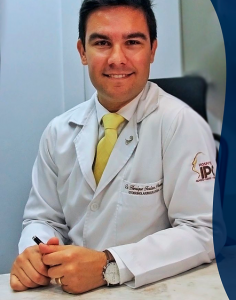
Fig. 55 Henrique Furlan Pauna drhenriquefurlan.com
The authors used human temporal bones to analyse the density of vestibular dark, transitional, and hair cells in specimens from CF patients who were exposed to several types of antibiotics, as compared with specimens from an age-matched control group with no history of ear disease or antibiotic use. Additionally, they analysed the changes in the elements of the cochlea (hair cells, spiral ganglion neurones, and the area of the stria vascularis). Data was gathered using differential interference contrast microscopy and light microscopy.
In the CF group, 83% of patients were exposed to some ototoxic drugs, such as aminoglycosides. As compared with the control group, the density of both type I and type II vestibular hair cells was significantly lower in all structures analysed; the number of dark cells was significantly lower in the lateral and posterior semicircular canals. They noted a trend toward a lower number of both inner and outer cochlear hair cells at all turns of the cochlea. The number of spiral ganglion neurones in Rosenthal’s canal at the apical turn of the cochlea was significantly lower; furthermore, the area of the stria vascularis at the apical turn of the cochlea was significantly smaller.
The authors concluded deterioration of cochlear and vestibular structures in CF patients might be related to their exposure to ototoxic antibiotics. They comment that well-designed case-control studies are necessary to rule out the effect of CF itself.
Henrique Furlan Pauna (fig, 55) is Affiliated Staff, Department of Otorhinolaryngology, Head and Neck Surgery, University of Campinas, Brazil
— This is an unusual study where the anatomical changes in both cochlear and peripheral vestibular systems in the ears of people with CF were examined.
Panchaud A; Di Paolo ER; Koutsokera A; Winterfeld U; Weisskopf E; Baud D; Sauty A; Csajka C. Safety of Drugs during Pregnancy and Breastfeeding in Cystic Fibrosis Patients. [Review] Respiration. 91(4):333-48, 2016.[Pubmed]

Fig 56. Alice Panchaud
Health management of cystic fibrosis (CF) patients should be maximised during pregnancy and breastfeeding, because of its significant impact on the maternal and newborn outcomes. Thus, numerous drugs will have to be continued during pregnancy and lactation. Most of the drugs representing CF treatment lines cross the placenta or are excreted into human milk. Research addressing the risks and benefits of drugs used in CF patients during pregnancy and lactation is often incomplete or challenged by limited methodology, which often leads to conflicting or inconclusive results. Yet, potential treatment benefits for CF pregnant patients most often outbalance potential risks for the unborn child.
— This is a detailed review of the use of drugs during pregnancy. Increasingly relevant now more women with CF are having children. In 2015 in the UK at the time of their annual review 64 women had a live birth and 26 women were pregnant.
Dr. Alice Panchaud (fig. 56) is a clinical pharmacist, Groupe de Pharmacie Hospitalière & Clinique, Section des Sciences Pharmaceutiques, Université de Genève, Université de Lausanne.
Peleg AY, Choo J, Langan K, Edgeworth D, Keating D, Wilson J. Antibiotic exposure and interpersonal variance mask the effect of ivacaftor on respiratory microbiota composition. J Cyst Fibros. 2017 Oct 14. pii: S1569-1993(17)30837-8. doi: 10.1016/j.jcf.2017.08.002. [Epub ahead of print][Pubmed]

Fig 57. Anton Peleg research.monash.edu
Ivacaftor effect on the airway microbiome remains poorly characterised. Twenty CF patients with at least one G551D mutation from a single centre were recruited to a 4-month double-blind, placebo-controlled, crossover study of ivacaftor with 28 days of active treatment. No significant difference in microbiota composition was observed in subjects following ivacaftor treatment or placebo (PERMANOVA P=0.95, square root ECV=-4.94, 9479 permutations). Microbiota composition variance was significantly greater between subjects, than within subjects over time (P<0.0001, Mann Whitney U test), and an additional within-patient paired assessment of microbiota similarity was therefore performed. Again, change in microbiota composition was not significantly greater during treatment with ivacaftor compared to placebo (Wilcoxon test, P=0.51). A significant change in microbiota composition was however associated with any change in antibiotic exposure, regardless of whether ivacaftor or placebo was administered (P=0.006). In a small, subgroup analysis of subjects whose antibiotic exposure did not change within the study period, a significant reduction in total bacterial load was observed during treatment with ivacaftor (P=0.004, two-tailed paired Student’s t-test).
The authors concluded the short-term impact of ivacaftor therapy on sputum microbiota composition in patients with G551D mutations are modest compared to those resulting from antibiotic exposure, and may be masked by changes in antibiotic treatment regimen.
Anton Peleg (fig. 57) is Professor of Infectious Diseases and Microbiology, Monash University and Infectious Disease Physician, Alfred Hospital, Melbourne.
— This is the expected result as when the airways are chronically infected, the progressive inflammatory state in the lungs is less dependent on the disturbed CFTR function, which is influenced by ivacaftor, than the chronic bacterial inflammation (See Drittanti L et al in 1997 Cinical section of this history for a suggested explanation) i.e. when the patient has passed from the “CF Disease” phase to the “Lung Disease” phase.
Iwona M Pranke, Aurélie Hatton, Juliette Simonin, Jean Philippe Jais, Françoise Le Pimpec-Barthes, Ania Carsin, Pierre Bonnette, Michael Fayon, Nathalie Stremler-Le Bel, Dominique Grenet, Matthieu Thumerel, Julie Mazenq, Valerie Urbach , Myriam Mesbahi, Emanuelle Girodon-Boulandet, Alexandre Hinzpeter, Aleksander Edelman, Isabelle Sermet-Gaudelus. Correction of CFTR function in nasal epithelial cells from cystic fibrosis patients predicts improvement of respiratory function by CFTR modulators. Sci Rep 2017 Aug 7;7(1):7375.doi: 10.1038/s41598-017-07504-1. Free PMC article [Pubmed]

Fig. 59 Isabelle Sermet-Gaudelius

Fig 58. Iwona Pranke
LinkedIn
Clinical studies with modulators of the Cystic Fibrosis Transmembrane conductance Regulator (CFTR) protein have demonstrated that functional restoration of the mutated CFTR can lead to substantial clinical benefit. However, studies have shown highly variable patient responses.
The objective of this study was to determine a biomarker predictive of the clinical response. CFTR function was assessed in vivo via nasal potential difference (NPD) and in human nasal epithelial (HNE) cultures by the response to Forskolin/IBMX and the CFTR potentiator VX-770 in short-circuit-current (∆IscF/I+V) experiments. CFTR expression was evaluated by apical membrane fluorescence semi-quantification. Iscmeasurements discriminated CFTR function between controls, healthy heterozygotes, patients homozygous for the severe F508del mutation and patients with genotypes leading to absent or residual function. ∆IscF/I+V correlated with CFTR cellular apical expression and NPD measurements. The CFTR correctors lumacaftor and tezacaftor significantly increased the ∆IscF/I+V response to about 25% (SEM = 4.4) of the WT-CFTR level and the CFTR apical expression to about 22% (SEM = 4.6) of the WT-CFTR level in F508del/F508del HNE cells. The level of CFTR correction in HNE cultures significantly correlated with the FEV1 change at 6 months in 8 patients treated with CFTR modulators.
The authors provide the first evidence that correction of CFTR function in HNE cell cultures can predict respiratory improvement by CFTR modulators.
Iwona M Pranke (fig.58) is a post-doctoral cell biologist at Inserm U1151 – CNRS UMR 8253 – team 2, Faculté de Médecine Paris Descartes, Paris, France.
Isabelle Sermet-Gaudelus (fig.59) is Professor of Pediatrics and Head of the Pediatric Cystic Fibrosis Center. Hopital Necker-Enfants Malades, Paris
Prevaes SM, de Steenhuijsen Piters WA, de Winter-de Groot KM, Janssens HM, Tramper-Stranders GA, Chu ML, Tiddens HA, van Westreenen M, van der Ent CK, Sanders EA, Bogaert D. Concordance between upper and lower airway microbiota in infants with cystic fibrosis. Eur Respir J. 2017 Mar 29;49(3). pii: 1602235. doi: 10.1183/13993003.02235-2016. Print 2017 Mar.[Pubmed]

Fig 60. Sabine Prevaes
Nasopharyngeal and oropharyngeal samples are commonly used to direct therapy for lower respiratory tract infections in non-expectorating infants with cystic fibrosis (CF). The authors aimed to investigate the concordance between the bacterial community compositions of 25 sets of nasopharyngeal, oropharyngeal and bronchoalveolar lavage (BAL) samples from 17 infants with CF aged ∼5 months (n=13) and ∼12 months (n=12) using conventional culturing and 16S-rRNA sequencing. Clustering analyses demonstrated that BAL microbiota profiles were in general characterised by a mixture of oral and nasopharyngeal bacteria, including commensals like Streptococcus, Neisseria, Veillonella and Rothia spp. and potential pathogens like Staphylococcus aureus, Haemophilus influenzae and Moraxella spp. Within each individual, however, the degree of concordance differed between microbiota of both upper respiratory tract niches and the corresponding BAL.
The authors conclude the inconsistent intra-individual concordance between microbiota of the upper and lower respiratory niches suggests that the lungs of infants with CF may have their own microbiome that seems seeded by, but is not identical to, the upper respiratory tract microbiome.
Sabine M P J Prevaes MD, PhD, (figure 38) is Fellow in Pediatric Pulmonology, Clinical Researcher, University Medical Center, Utrecht, Division of Pediatrics. She has published extensively on the bacteriological aspects of cystic fibrosis.
Ramsey BW, Welsh MJ. Progress along the Pathway of Discovery Leading to Treatment and Cure of Cystic Fibrosis. Am J Respir Crit Care Med. 2017 May 1;195(9):1092-1099. doi: 10.1164/rccm.201702-0266ED. AJRCCM: 100-Year Anniversary.[Pubmed]

Fig 61. Bonnie Ramsey

Fig 62. Michael Michael Welsh
The initial pathological description of cystic fibrosis (CF) of the pancreas was reported in the 1930s. Development of the sweat test in the 1950s enabled clinical diagnosis and the potential for therapeutic intervention. Our understanding of the pathophysiology and genetic basis of CF exploded in the 1980s, with the discovery of abnormal chloride transport in the sweat duct and respiratory tract , followed by the discovery of the gene leading to scientific knowledge about the gene product, the CF transmembrane conductance regulator (CFTR) protein, and how loss of CFTR function caused clinical disease. During the last 40 years, the AJRCCM has published comprehensive reviews chronicling the scientific progress in CF . In a 1998 Journal article the authors reviewed progress in CF research in the decade after the CF gene discovery. Using a “pathway of discovery leading to understanding and cure of a genetic disease” as a blueprint, this centennial review will build on that foundation and describe how the CF community has continued to make remarkable progress.
– A very clear article describing the quite remarkable progress since the first description of CF as a specific condition by Dorothy Andersen in 1938. Both authors have made outstanding contributuons to the pathway of discovery they describe.
Ranganathan SC, Hall GL, Sly PD, Stick SM, Douglas TA; Australian Respiratory Early Surveillance Team for Cystic Fibrosis (AREST-CF). Early Lung Disease in Infants and Preschool Children with Cystic Fibrosis. What Have We Learned and What Should We Do about It? Am J Respir Crit Care Med. 2017 Jun 15;195(12):1567-1575. doi: 10.1164/rccm.201606-1107CI.[Pubmed]

Fig. 63 Sarath Ranganathan
mcr.edu.au
The past decade has seen significant advances in understanding of the pathogenesis and progression of lung disease in cystic fibrosis (CF). Pulmonary inflammation, infection, and structural lung damage manifest very early in life and are prevalent among preschool children and infants, often in the absence of symptoms or signs. Early childhood represents a pivotal period amenable to intervention strategies that could delay or prevent the onset of lung damage and alter the longer-term clinical trajectory for individuals with CF. This review summarises what we have learned about early lung disease in children with CF and discusses the implications for future clinical practice and research.
– This is an excellent article reviewing the present situation regarding the need for more effective early monitoring and treatment to prevent the development of bronchiectasis in up to 80% of children by the age of 5 years with the long-term consequences. The author considers an “attitudinal change within CF clinics in important with increased attention of the early years in the establishment of lung disease’ with “policies and guidelines that lead to a more unified proactive approach care in asymptomatic and apparently healthy young children rather than an acceptance of a casual or reactive approach”.
The author discuses in some detail the options which are already available multidisciplinary care at a CF centre modifiable psychological risk factors, home treatment, and adherence. Antibiotics for CF pathogens detected in both symptomatic and asymptomatic individuals. Early eradication of of P. aeruginosa. Mucolytic and the anti-inflammatory actions of macrolides and antibiotics targeting eradication of S. aureus and H. influenzae even in the absence of symptoms. Bronchoscopy is indicated when response to treatment is suboptimal. Introduction of mucolytics at an early stage. Nutritional strategies for the rapid regain of birth weight and normalising fat-soluble vitamin levels. Increased frequency of clinical review and a lower threshold for intensive multidisciplinary review and a lower threshold for admissions for intensive multidisciplinary therapy. He then discusses moving treatments into the preschool period and assessing the CFTR modulators in young children.
Professor Sarath Ranganathan (fig. 63) is a full-time specialist in paediatric respiratory medicine and director of Respiratory Medicine at the Royal Melbourne Children’s Hospital. He is an expert in the field of clinical respiratory physiology and early lung disease.
Ratjen F, Hug C, Marigowda G, Tian S, Huang X, Stanojevic S, Milla CE, Robinson PD, Waltz D, Davies JC; VX14-809-109 investigator group. Efficacy and safety of lumacaftor and ivacaftor in patients aged 6-11 years with cystic fibrosis homozygous for F508del-CFTR: a randomised, placebo-controlled phase 3 trial. Lancet Respir Med. 2017 Jul;5(7):557-567. doi: 10.1016/S2213-2600(17)30215-1. Epub 2017 Jun 9. [Pubmed]
Lumacaftor and ivacaftor combination treatment showed efficacy in patients aged 12 years or older with cystic fibrosis homozygous for F508del-cystic fibrosis transmembrane conductance regulator (CFTR) in placebo-controlled studies and for patients aged 6-11 years with cystic fibrosis homozygous for F508del-CFTR in an open-label study. The authors report efficacy and safety of lumacaftor and ivacaftor in patients with cystic fibrosis aged 6-11 years homozygous for F508del-CFTR.
In this phase 3, randomised, double-blind, placebo-controlled, multicentre study, patients were enrolled at 54 hospitals and medical centres in nine countries (the USA, Australia, Belgium, Canada, Denmark, France, Germany, Sweden, and the UK). Eligible patients weighed at least 15 kg, with a confirmed diagnosis of cystic fibrosis, per cent predicted forced expiratory volume in 1 s (FEV1) of 70 or more, and lung clearance index 2·5 (LCI 2·5) of 7·5 or more at screening (values less than these thresholds were permitted at day 1). All patients were tested for CFTR genotype at screening; eligible patients had to have the F508del-CFTR mutation on both alleles. Exclusion criteria included any comorbidity or laboratory abnormality that might confound the study results or pose additional risk to the patient. Patients were stratified by weight (<25 kg vs. ≥25 kg) and ppFEV1 severity (<90 vs. ≥90) determined at the screening visit, and randomly assigned 1:1 to treatment using an interactive web response system to receive 200 mg lumacaftor and 250 mg ivacaftor every 12 hours or placebo for 24 weeks. The primary endpoint was the mean absolute change in LCI 2·5 from all on-treatment study visits up to and including week 24. All randomly assigned patients who were exposed to any amount of study drug, with treatment assignment as assigned were included in primary and other efficacy analyses. All patients who were exposed to any amount of study drug, with treatment assignment as treated, were included in the safety analysis. This study was registered with ClinicalTrials.gov, number NCT02514473.
Between July 23, 2015, and Sept 20, 2016, a total of 206 patients were enrolled and randomly assigned to receive lumacaftor and ivacaftor (n=104) or placebo (n=102). Two randomly assigned patients were never dosed with study drug (one in the placebo arm due to ineligibility arising from a streptococcal throat infection and one in the lumacaftor and ivacaftor arm due to withdrawal based on refusal to provide blood tests) and were not included in the analyses.
103 patients received at least one dose of lumacaftor and ivacaftor and 101 patients received at least one dose of placebo. For the primary endpoint, the average absolute change in LCI2·5 from baseline over all study visits up to and including the week 24 visit, least squares mean difference was -1·09 units (95% CI -1·43 to -0·75, p<0·0001) for lumacaftor and ivacaftor versus placebo. For the key secondary endpoint of sweat chloride concentration, the least squares mean difference versus placebo was -20·8 mmol/L (95% CI -23·4 to -18·2, average absolute change at day 15/week 4; p<0·0001). The least squares mean difference compared with placebo in absolute change in ppFEV1 from all on-treatment study visits until week 24 was 2·4 (95% CI 0·4-4·4, p=0·0182). 196 (96%) of 204 patients reported adverse events, most of which were mild (87 [43%]) or moderate (98 [48%]). Treatment was discontinued due to adverse events in three (3%) of 103 patients in the lumacaftor and ivacaftor group and two (2%) of 101 patients in the placebo group. Serious adverse events were reported in 13 (13%) of 103 patients in the lumacaftor and ivacaftor group and 11 (11%) of 101 patients in the placebo group.
The authors concluded that treatment with lumacaftor and ivacaftor was associated with statistically significant improvements in lung function, as measured by LCI2·5 and ppFEV1, versus placebo in patients aged 6-11 years with cystic fibrosis homozygous for F508del-CFTR. The overall safety profile was consistent with previous phase 3 studies of lumacaftor and ivacaftor.
– The first important major study on lumacaftor/ivacaftor children aged 6 to 11 years.
Romani L, Oikonomou V, Moretti S, Iannitti RG, D’Adamo MC, Villella VR, Pariano M, Sforna L, Borghi M, Bellet MM, Fallarino F, Pallotta MT, Servillo G, Ferrari E, Puccetti P1, Kroemer G, Pessia M, Maiuri L, Goldstein AL, Garaci E. Thymosin α1 represents a potential potent single-molecule-based therapy for cystic fibrosis. Nat Med. 2017 May;23(5):590-600. doi: 10.1038/nm.4305. Epub 2017 Apr 10. [Pubmed]
To date, no individual drug with pleiotropic beneficial effects is available for CF. Here the authors report on the ability of thymosin alpha 1 (Tα1), (a naturally occurring polypeptide with an excellent safety profile in the clinic when used as an adjuvant or an immunotherapeutic agent), to rectify the multiple tissue defects in mice with CF as well as in cells from subjects with the most common p.Phe508del mutation. Tα1 displayed two combined properties that favourably opposed CF symptomatology: it reduced inflammation and increased CFTR maturation, stability and activity. By virtue of this two-pronged action, Tα1 has strong potential to be an efficacious single-molecule-based therapeutic agent for CF.
– Apparently Tα1 is not currently available in the U.S. but it has been approved for clinical use for over 15 years in 35 countries in the treatment of other medical conditions (not CF) such as viral infections, immunodeficiency diseases, malignancies, and HIV/AIDS and has a good safety profile. Understandably there is considerable interest in this potential treatment for CF.

Fig 64. Luigina Romani

Fig 65. Allan Goldstein

Fig 66. Enrico Garaci
Professor Luigina Romani (fig. 64) is Chair of the Department of Pathology, University of Perugia, and is an internationally recognized authority in the area of antifungal immunity.
Professor Allan L Goldstein (fig.65) is Professor Emeritus in Residence of Biochemistry and Molecular Medicine at the George Washington School of Medicine and Health Sciences. He is a world authority on the thymus gland and the immune system and co-discoverer of thymosins.
Professor Enrico Garaci (fig. 66) is a distinguished scientist and Rector and Professor at the University of Rome. His research has mainly focused on the effects of specific and non-specific immune factors especially in viral diseases. He has held a number of distinguished national appointments.
Rowe SM, McColley SA, Rietschel E, Li X, Bell SC, Konstan MW, Marigowda G, Waltz D, Boyle MP; VX09-809-102 Study Group. Lumacaftor/Ivacaftor Treatment of Patients with Cystic Fibrosis Heterozygous for F508del-CFTR. Ann Am Thorac Soc. 2017 Feb;14(2):213-219. doi: 10.1513/Annals ATS.201609-689OC.[Pubmed]

Fig 67. Steven Rowe
In a prior study, lumacaftor/ivacaftor treatment (≤28 d) in patients with cystic fibrosis (CF) heterozygous for F508del-CFTR did not improve lung function. This present study was to evaluate an optimized lumacaftor/ivacaftor dosing regimen with a longer duration in a cohort of patients heterozygous for F508del-CFTR. Lumacaftor/ivacaftor (400 mg/250 mg every 12 h) or placebo daily for 56 days. Sweat chloride and respiratory symptom scores improved with lumacaftor/ivacaftor, though no meaningful benefit was seen in ppFEV1 or body mass index in patients heterozygous for F508del-CFTR.
Steven Rowe (fig. 67) is a pulmonologist in Birmingham, Alabama and is affiliated with University of Alabama at Birmingham Hospital
Rymut SM; Kampman CM; Corey DA; Endres T; Cotton CU; Kelley TJ. Ibuprofen regulation of microtubule dynamics in cystic fibrosis epithelial cells. Am J Physiology – Lung Cellular & Molecular Physiology. 311(2):L317-27, 2016 Aug 01.[Pubmed]
High-dose ibuprofen, an effective anti-inflammatory therapy for the treatment of cystic fibrosis (CF), has been shown to preserve lung
function in a pediatric population. Despite its efficacy, few patientsreceive ibuprofen treatment due to potential renal and gastrointestinal toxicity. The mechanism of ibuprofen efficacy is also unclear. The authors suggest that high-dose ibuprofen treatment enhances microtubule formation in CF cells likely through an AMPK-related pathway. These findings define a potential mechanism to explain the efficacy of ibuprofen therapy in CF.
~ Full details are in the complete summary. Very few people with CF are now treated with ibuprofen.
Sharon Raymut is in the Departments of Pediatrics, Case Western Reserve University, Cleveland, Ohio.
Ren CL, Borowitz DS, Gonska T, Howenstine MS, Levy H, Massie J, Milla C, Munck A, Southern KW. Cystic Fibrosis Transmembrane Conductance Regulator-Related Metabolic Syndrome and Cystic Fibrosis Screen Positive, Inconclusive Diagnosis. J Pediatr. 2017 Feb;181S:S45-S51.e1. doi: 10.1016/j.jpeds.2016.09.066. [Pubmed]

Fig 68. Clement Ren
An unintended consequence of cystic fibrosis (CF) newborn screening (NBS) is the identification of infants with a positive NBS test but inconclusive diagnostic testing. These infants are classified as CF transmembrane conductance regulator-related metabolic syndrome (CRMS) in the US and CF screen positive, inconclusive diagnosis (CFSPID) in other countries.
The authors concluded CRMS/CFSPID is a relatively common outcome of CF NBS, and clinicians need to be prepared to counsel families whose NBS test falls into this classification. The vast majority of infants with CRMS/CFSPID will remain free from disease manifestations early in life. However, a small proportion may develop clinical features concerning for CF or demonstrate progression to a clinical phenotype compatible with a CF diagnosis, and their long-term outcomes are not known. A consistent international definition of CRMS/CFSPID will allow for better data collection for study of outcomes and result in improved patient care.
Clement Ren (fig.68) is a pediatric pulmonologist in Indianapolis, Indiana and is affiliated with multiple hospitals in the area, including Indiana University Health North Hospital and Indiana University Health University Hospital.
— Experience in Leeds with continuous newborn CF screening from 1975 suggests these patients are not common and the essential is follow them for as long as necessary ideally by the same paediatrician and team experienced in CF and known to the family.
Reznikov LR. Cystic Fibrosis and the Nervous System. [Review] Chest. 151(5):1147-1155, 2017 May [Pubmed]

Fig.69 Leah Reznikov
Wix
Although defective anion transfer across epithelial cells is accepted as the basic defect in CF, many of the features observed in people with CF and organs affected by CF are modulated by the nervous system. This is of interest because CFTR expression has been reported in both the peripheral and central nervous systems, and it is well known that the transport of anions, such as chloride, greatly modulates neuronal excitability. Thus it is predicted that in CF, lack of CFTR in the nervous system affects neuronal function. Consistent with this prediction, several nervous system abnormalities and nervous system disorders have been described in people with CF and in animal models of CF. The goal of this special feature article is to highlight the expression and function of CFTR in the nervous system. Special emphasis is placed on nervous system abnormalities described in people with CF and in animal models of CF. Finally, features of CF that may be modulated by or attributed to faulty nervous system function are discussed.
Dr. Leah Reznikov (fig. 69) is Assistant Professor in the Department Physiological Sciences at the University of Florida College of Veterinary Medicine. Her interests are centered on the interface of the nervous system and the airways.
– A comprehensive review of the CNS abnormalities in people with CF. See CNS in Topics section of this history for further details.
Roberts JM; Wilcox PG; Quon BS. Evaluating Adult Cystic Fibrosis Care in BC: Disparities in Access to a Multidisciplinary Treatment Centre. Can Respir J 2016:8901756, 2016.[Pubmed]

Fig 70. James M Roberts
Cystic fibrosis care that is delivered through dedicated multidisciplinary CF clinics is believed to be partly responsible for improvements in the length and quality of life of persons with CF. The authors hypothesised patients living farthest from a CF clinic would be seen less frequently than recommended, which would result in reduced access to guideline-recommended care and poorer health outcomes. They performed a retrospective chart review of 168 patients who accessed CF care primarily through the St. Paul’s Hospital Adult CF Clinic. Subjects were stratified into four geographical groups according to the estimated one-way travel time by automobile from their home address to the clinic (<45mins, 45-150mins, 150-360mins, and >360mins).
Results. There were no significant differences in pulmonary function, nutritional status, CF-related complications, or access to guideline-recommended CF pulmonary therapies between the four groups. Compared to the reference (<45mins) group, subjects in the two farthest groups (>150mins) were less likely to be seen in the clinic quarterly as recommended by current CF care guidelines (p = 0.002). Those in the farthest group (>360mins) were at risk for more rapid decline in lung function compared to the reference group (FEV1% predicted annual change: -3.1%/year [95% CI -5.1 to -1.1] versus -0.9%/year [95% CI -1.6 to 0.1], resp., p = 0.04).
The authors concluded access to CF care is a challenge for individuals who live outside Metro Vancouver and has health policy implications. Further initiatives should be undertaken to ensure equitable care for people living with CF. They note that while at present some challenges to accessing routine multidisciplinary CF care exist, they have shown that individuals with CF in British Columbia continue to experience similar health outcomes regardless of their location of residence. The approach of a single clinic with an array of multidisciplinary staff, coupled with frequent outreach initiatives, including satellite clinics, telehealth contact, family physician, and local specialist involvement, may be applicable to other “orphan” diseases for which comprehensive multidisciplinary outpatient care might not otherwise be available.
James Mark Roberts (fig. 70) is Clinical Associate, Professor General Internal Medicine, Programme Director Postgraduate Medical Education, University of British Columbia, Vancouver.
Ronan NJ, Einarsson GG, Twomey M, Mooney D, Mullane D, NiChroinin M, O’Callaghan G, Shanahan F, Murphy DM, O’Connor OJ, Shortt CA, Tunney MM, Eustace JA, Maher MM, Elborn JS, Plant BJ. CORK study in CF: Sustained improvements in ultra-low dose chest CT scores post CFTR modulation with ivacaftor. 10.1016/j.chest.2017.10.005. [Epub ahead of print] [Pubmed]
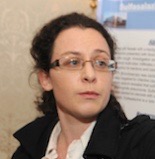
Fig 71. Nicola Ronan Irish Thoracic Society
Ivacaftor produces significant clinical benefit in patients with cystic fibrosis (CF) with the G551D mutation. Prevalence of this mutation at Cork CF Centre is 23%. This study assessed the impact of CFTR modulation on multiple modalities of patient assessment.
Thirty-three patients with the G551D mutation were assessed at baseline and prospectively three monthly for one year post initiation of ivacaftor. Change in ultra-low dose chest CT, blood inflammatory mediators, and sputum microbiome were assessed.
Significant improvements in FEV1, BMI and sweat chloride were observed post-ivacaftor. Improvement in ultra-low dose CT scores was observed after treatment with significant mean reductions in total Bhalla score (p< 0.01), peri-bronchial thickening (p = 0.035) and extent of mucus plugging (p< 0.001). The greatest improvements on chest CT were in the extent of mucus plugging. This is consistent with in vitro studies where ivacaftor enhanced airway surface liquid and ciliary beat frequency. Established lung damage was not reversible. Reductions in circulating inflammatory markers, including IL-1β, IL-6, and IL-8 were demonstrated. There was a 30% reduction in the relative abundance of Pseudomonas spp. and an increase in the relative abundance of bacteria associated with more stable community structures. Post-treatment community richness increased significantly (p = 0.03).
The authors concluded early and sustained improvements on ultra-low-dose CT scores suggest it may be a useful method of evaluating treatment response. It was paralleled improvement in symptoms, circulating inflammatory markers, and changes in the lung microbiota.
– Interestingly somewhat different findings to Peleg study described in 2017 section but these Irish patients appeared to be at an earlier stage where the change in CFTR activity and physicochemical conditions within the airways would have an effect on the bacterial content.
Nicola Ronan (fig.71) is a pulmonologist at Cork University Hospital, Ireland.
Rubin BK. Cystic Fibrosis 2017-The Year in Review. Respir Care. 2017 Dec 26. pii: respcare.06052. doi: 10.4187/respcare.06052. [Epub ahead of print] [Pubmed]

Fig 72. Bruce Rubin
Professor Rubin observes “it is always an exciting challenge to write a Year in Review artcicle identifying the best publications in the preceding year; in this case from October 2016 until the AARC meeting in October 2017. This is particularly true for cystic fibrosis (CF), where there has been an explosion of new data, new medications, and new understanding of the pathophysiology of the disease. PubMed lists more than 2,500 papers published during those 12 months, many of them outstanding. I am indebted to many colleagues and friends who are leaders in the CF community, active readers of the pediatric pulmonary listserv, and scientists and clinicians engaged in the care of CF, for offering their suggestions regarding which articles should be included in this review. I believe that you will enjoy reading this curated selection of manuscripts that I have tried to organize by theme”.
Bruce K Rubin (fig. 72) is the Jessie Ball du Pont Distinguished Professor and Chair Department of Pedaitrics at the Virginia Commonwealth School of Medicine and Children’s Hospital Richmond. Bruce.rubin@vcuhealth/org. Bruce kindly provided me with a full text of his article which is a very readable account of the present state of our understanding and management of people with cystic fibrosis .
Sayyid ZN, Sellers ZM. Technological advances shed light on left ventricular cardiac disturbances in cystic fibrosis. J Cyst Fibros. 2017 Jul;16(4):454-464. doi: 10.1016/j.jcf.2017.02.013. Epub 2017 Mar 14.
Clinical heart disease in CF is considered rare and is restricted to case reports. It has been unclear if this is due to the lack of physiological importance of CFTR in the heart, the relatively short lifespan of those with CF, or a technical inability to detect subclinical disease. The authors focus on data from new echocardiographic and magnetic resonance imaging technology, which are providing greater insight into cardiac function in CF and demonstrating that, in addition to secondary effects from pulmonary disease, there may be an intrinsic primary defect in the CF heart. With advancing lifespans and activity levels, understanding the risk of cardiac disease is vital to minimising morbidity in adults with CF.
— A detailed review of cardiac involvement in CF. One recalls in the domino transplant procedures of the Eighties, the heart of the CF recipient of the heart lung transplant was used successfully for another non-CF patient requiring a heart transplant. The actuarial survival of the recipients of these transplanted CF hearts was 75% at 1 year. No coronary artery disease was present in the 12 patients who underwent coronary angiography at 1 year (Yacoub MH et al, 1990 [Pubmed])
Zahra N Sayyid is at Stanford University, School of Medicine, Palo Alto, CA, United States.
Rowbotham NJ, Smith S, Leighton PA, Rayner OC, Gathercole K, Elliott ZC, Nash EF, Daniels T, Duff AJA, Collins S, Chandran S, Peaple U, Hurley MN, Brownlee K, Smyth AR. The top 10 research priorities in cystic fibrosis developed by a partnership between people with CF and healthcare providers. Thorax. 2017 Aug 4. pii: thoraxjnl-2017-210473. doi: 10.1136/thoraxjnl-2017-210473. [Epub ahead of print] [Pubmed]

Fig. 73 Nicola Rowbotham
ResearchGate
The authors conducted a James Lind Alliance Priority Setting Partnership*(vide infra) in CF. Research questions were elicited and then prioritised in successive surveys. A workshop agreed the final top 10. Online methods avoided cross infection and widened participation. The elicitation survey had 482 respondents (1080 questions) and prioritisation survey 677 respondents. Participants were drawn equally from the patient and clinical communities globally.
The group achieved a consensus on 10 research priorities which they consider will be attractive to funders – these were the following.
1. What are the effective ways of simplifying the treatment burden of people with cystic fibrosis?
2. How can we relieve gastrointestinal symptoms such as stomach pain, bloating and nausea in people with cystic fibrosis?
3. What is the best treatment for non-tuberculous mycobacteria in people with CF (including when to start and what medication?
4. Which therapies are effective in delaying or preventing progression of lung disease in early life in people with cystic fibrosis?
5. Is there a way of preventing CF related diabetes?
6. What effective ways of motivation support and technologies help people with cystic fibrosis improve and sustain adherence to treatment?
7. Can exercise replace physiotherapy for people with cystic fibrosis?
8. Which antibiotic combinations and dosing plans should be used for cystic fibrosis exacerbations?
9. Is there a way of reducing the negative effects of antibiotics for example resistance risk and adverse symptoms in people with cystic fibrosis?
10. What is the best way of eradicating Pseudomonas aeruginosa in people with cystic fibrosis?
* The James Lind Alliance (JLA) is a non-profit-making initiative, established in 2004. It brings patients, carers and clinicians together in Priority Setting Partnerships (PSPs) to identify and prioritise the Top 10 uncertainties, or unanswered questions, about the effects of treatments. The aim of this is to make sure that health research funders are aware of the issues that matter most to patients and clinicians. The James Lind Alliance is named after a pioneer of clinical trials, James Lind. Three centuries ago, sailors were dying of scurvy. There were many conflicting ideas about how to treat this deadly disease. James Lind, a Scottish naval surgeon, decided to confront these uncertainties by treating his patients within what is thought to have been the first ever clinical trial, comparing the proposed remedies. He allocated two sailors to each of six different treatments for a period of 14 days. His trial showed that oranges and lemons were dramatically better than the other suggested treatments (details from www.jla.nihr.ac.uk)
Dr Nicola Rowbotham (fig. 73) is a paediatrician and Academic Clinical Fellow in Evidence Based Child Health at the University of Nottingham.
Rowe SM, McColley SA, Rietschel E, Li X, Bell SC, Konstan MW, Marigowda G, Waltz D, Boyle MP; VX09-809-102 Study Group. Lumacaftor/Ivacaftor Treatment of Patients with Cystic Fibrosis Heterozygous for F508del-CFTRAnn Am Thorac Soc. 2017 Feb;14(2):213-219. doi: 10.1513/AnnalsATS.201609-689OC.[Pubmed]
In a prior study, lumacaftor/ivacaftor treatment (≤28 d) in patients with cystic fibrosis (CF) heterozygous for F508del-CFTR did not improve lung function. To evaluate an optimized lumacaftor/ivacaftor dosing regimen with a longer duration in a cohort of patients heterozygous for F508del-CFTR. Patients aged 18 years or older with a confirmed CF diagnosis and percent predicted FEV1 (ppFEV1) of 40 to 90 were randomised to lumacaftor/ivacaftor (400 mg/250 mg every 12 h) or placebo daily for 56 days. Primary outcomes were change in ppFEV1at Day 56 and safety. Other disease markers were evaluated.
Of 126 patients, 119 (94.4%) completed the study. Lumacaftor/ivacaftor was well tolerated, although chest tightness and dyspnea occurred more frequently with active treatment than with placebo (27.4% vs. 14.3% and 14.5% vs. 6.3%, respectively). Mean (SD) ppFEV1 values at baseline were 62.9 (14.3) in the active treatment group and 60.1 (14.0) in the placebo group. Absolute changes in ppFEV1 (least squares mean [SE]) at Day 56 were -0.6 (0.8) percentage points in the active treatment group and -1.2 (0.8) percentage points in the placebo group (P = 0.60). CF respiratory symptom scores in the active treatment group improved by a mean of 5.7 points versus a decrease of -0.8 in the placebo group (P < 0.01). No changes in body mass index occurred. Changes from baseline in sweat chloride (least squares mean [SE]) at Day 56 were -11.8 (1.3) mmol/L in the active treatment group and -0.8 (1.2) mmol/L in the placebo group (P < 0.0001).
The authors concluded sweat chloride and respiratory symptom scores improved with lumacaftor/ivacaftor, though no meaningful benefit was seen in ppFEV1 or body mass index in patients heterozygous for F508del-CFTR.
Steven M Rowe , Cori Daines, Felix C Ringshausen, Eitan Kerem, John Wilson, Elizabeth Tullis, Nitin Nair, Christopher Simard, Linda Han, Edward P Ingenito, Charlotte McKee, Julie Lekstrom-Himes, Jane C Davies. Tezacaftor-Ivacaftor in Residual-Function Heterozygotes with Cystic Fibrosis. N Engl J Med 2017 Nov 23;377(21):2024-2035.doi: 10.1056/NEJMoa1709847.Epub 2017 Nov 3. 29099333 Free PMC article

Fig. 74 Steven M. Rowe the-asci.org
Background: Cystic fibrosis is an autosomal recessive disease caused by mutations in the CFTR gene that lead to progressive respiratory decline. Some mutant CFTR proteins show residual function and respond to the CFTR potentiator ivacaftor in vitro, whereas ivacaftor alone does not restore activity to Phe508del mutant CFTR.
Methods: We conducted a randomized, double-blind, placebo-controlled, phase 3, crossover trial to evaluate the efficacy and safety of ivacaftor alone or in combination with tezacaftor, a CFTR corrector, in 248 patients 12 years of age or older who had cystic fibrosis and were heterozygous for the Phe508del mutation and a CFTR mutation associated with residual CFTR function. Patients were randomly assigned to one of six sequences, each involving two 8-week intervention periods separated by an 8-week washout period. They received tezacaftor-ivacaftor, ivacaftor monotherapy, or placebo. The primary end point was the absolute change in the percentage of predicted forced expiratory volume in 1 second (FEV1) from the baseline value to the average of the week 4 and week 8 measurements in each intervention period.
Results: The number of analyzed intervention periods was 162 for tezacaftor-ivacaftor, 157 for ivacaftor alone, and 162 for placebo. The least-squares mean difference versus placebo with respect to the absolute change in the percentage of predicted FEV1 was 6.8 percentage points for tezacaftor-ivacaftor and 4.7 percentage points for ivacaftor alone (P<0.001 for both comparisons). Scores on the respiratory domain of the Cystic Fibrosis Questionnaire-Revised, a quality-of-life measure, also significantly favored the active-treatment groups. The incidence of adverse events was similar across intervention groups; most events were mild or moderate in severity, with no discontinuations of the trial regimen due to adverse events for tezacaftor-ivacaftor and few for ivacaftor alone (1% of patients) and placebo (<1%).
Conclusions: CFTR modulator therapy with tezacaftor-ivacaftor or ivacaftor alone was efficacious in patients with cystic fibrosis who were heterozygous for the Phe508del deletion and a CFTR residual-function mutation. (Funded by Vertex Pharmaceuticals and others; EXPAND ClinicalTrials.gov number, NCT02392234
Steven Rowe (fig. 74) is Professor in the Division of Pulmonary, Allergy, and Critical Care Medicine, University of Alabama at Birmingham, and a number of other centres
Schneider EK, Azad MA, Han ML, Tony Zhou Q, Wang J, Huang JX, Cooper MA, Doi Y, Baker MA, Bergen PJ, Muller MT, Li , Velkov T. An “Unlikely” Pair: The Antimicrobial Synergy of Polymyxin B in Combination with the Cystic Fibrosis Transmembrane Conductance Regulator Drugs KALYDECO and ORKAMBI. ACS Infect Dis. 2016 Jul 8;2(7):478-88. doi: 10.1021/acsinfecdis.6b00035. Epub 2016 May 17. [Pubmed]
Novel combination therapies are desperately needed for combating lung infections caused by bacterial “superbugs”. This study aimed to investigate the synergistic antibacterial activity of polymyxin B in combination with the cystic fibrosis (CF) drugs KALYDECO (ivacaftor) and ORKAMBI (ivacaftor + lumacaftor) against Gram-negative pathogens that commonly colonize the CF lung, in particular, the problematic Pseudomonas aeruginosa. In summary, the combination of polymyxin B with KALYDECO or ORKAMBI exhibited synergistic activity against highly polymyxin-resistant P. aeruginosa CF isolates and can be potentially useful for otherwise untreatable CF lung infections.
Alan R Smyth, Jayesh Bhatt, Sarah J Nevitt. Once-daily versus multiple-daily dosing with intravenous aminoglycosides for cystic fibrosis Database of Systematic Reviews 2017 March 27, 3: CD002009 [Pubmed]
Fifteen studies were identified for possible inclusion in the review. Four studies reporting results from a total of 328 participants (aged 5 to 50 years) were considered suitable to included in this review.
The authors conclude that once- and three-times daily aminoglycoside antibiotics appear to be equally effective in the treatment of pulmonary exacerbations of cystic fibrosis. There is evidence of less nephrotoxicity in children.
Smyth AR; Rosenfeld M. Prophylactic anti-staphylococcal antibiotics for cystic fibrosis. Update of Cochrane Database Syst Rev. 2014 Nov 24;(11):CD001912;PMID: 25419599 Cochrane Database of Systematic Reviews. 4:CD001912,
[Pubmed]

Fig. 75 Alan Smyth Cystic Fibrosis Trust
This is an update of a previously published review. The authors included four studies, with a total of 401 randomised participants aged zero to seven years on enrolment; one study is ongoing. After the customary criticisms of methodology of a number of previous trials the authors found that fewer children receiving anti-staphylococcal antibiotic prophylaxis had one or more isolates of Staphylococcus aureus (low quality evidence). There was no significant difference between groups in infant or conventional lung function (moderate quality evidence). They found no significant effect on nutrition (low quality evidence), hospital admissions, additional courses of antibiotics (low quality evidence) or adverse effects (moderate quality evidence). There was no significant difference in the number of isolates of Pseudomonas aeruginosa between groups (low quality evidence), though there was a trend towards a lower cumulative isolation rate of Pseudomonas aeruginosa in the prophylaxis group at two and three years and towards a higher rate from four to six years. As the studies reviewed lasted six years or less, conclusions cannot be drawn about the long-term effects of prophylaxis.
The authors concluded anti-staphylococcal antibiotic prophylaxis results in fewer children having isolates of Staphylococcus aureus, when commenced early in infancy and continued up to six years of age. The clinical importance of this finding is uncertain. Further research may establish whether the trend towards more children with CF with Pseudomonas aeruginosa, after four to six years of prophylaxis, is a chance finding and whether choice of antibiotic or duration of treatment might influence this.
— This review finds that fewer children on prophylaxis isolated S. aureus which is a good positive finding. The oft-quoted increase in P. aeruginosa in children on prophylaxis (although based on unsatisfactory evidence) is of even less significance now early eradication P. aeruginosa is so effective. Anti-staphyloccocal prophylaxis should be advised. However, for those opposed to continuous prophylaxis it should be noted Copenhagen patients are not on long-term prophylaxis but do have monthly respiratory cultures; they require two courses of anti-staphylococcal antibiotics annually to treat positive cultures to remain free of chronic S. aureus infection.
Everything possible should be done to prevent chronic S. aureus infection – which does not appear to be the policy at some CF Centres as judged by the substantial proportion of their patients who have chronic S. aureus infection.
Alan Smyth (fig.75) is Professor of Paediatrics in the University of Nottingham, UK
Smyth RL; Rayner O. Oral calorie supplements for cystic fibrosis. [Review][Update of Cochrane Database Syst Rev. 2014 Nov 03;(11):CD000406; PMID: 25363148] Cochrane Database of Systematic Reviews. 5:CD000406, 2017 05 04.[Pubmed]

Fig. 76 Rosalind Smyth profiles.ucl.ac.uk
The authors of this Cochrane review concluded that oral calorie supplements do not confer any additional benefit in the nutritional management of moderately malnourished children with cystic fibrosis over and above the use of dietary advice and monitoring alone. While nutritional supplements may be used, they should not be regarded as essential. They suggest further randomised controlled trials are needed to establish the role of short-term oral protein energy supplements in people with cystic fibrosis and acute weight loss and also for the long-term nutritional management of adults with cystic fibrosis or advanced lung disease, or both.
– Professor Ros Smyth (fig.75) was a co-author in the original CALICO trial in 2006 where the conclusion was “Long term use of oral protein energy supplements did not result in an improvement in nutritional status or other clinical outcomes in children with cystic fibrosis who were moderately malnourished. Oral protein energy supplements should not be regarded as an essential part of the management of this group of children”. At that time over 50% of children with CF in the UK were taking regular (expensive) proprietary dietary supplements with only sparse evidence of their efficacy. The original trial showed that dietary advice to increase the intake of normal food was of equivalent value, the supplements were still widely used as one way of dealing with the eating problems so common in small children with CF and in improving energy intake in adults (see original comment in 2006 section of this History – Poustie V J et al, 2006)
Sommerwerck U, Virella-Lowell I, Angyalosi G, Viegas A, Cao W, Debonnett L. Long-term safety of tobramycin inhalation powder in patients with cystic fibrosis: phase IV (ETOILES) study. Cur Med Res Opin. 2016 Nov;32(11):1789-1795. Epub
2016 Sep 9.[Pubmed]

Fig 76. Urte Sommerwerck
Long-term treatment with inhaled antibiotics is recommended for chronic Pseudomonas aeruginosa (Pa) infection in cystic fibrosis (CF) patients. The ETOILES study (Clinicaltrials.gov identifier: NCT01519661) evaluated the safety of tobramycin inhalation powder (TIP) for 1 year.
This single-arm, open-label, multicenter, phase IV trial, enrolled CF patients aged ≥6 years, with baseline FEV1 ≥25%-≤75% predicted and Pa infection, and assessed the safety of TIP over six cycles in terms of the incidence of treatment-emergent adverse events (AEs) and serious AEs (SAEs). Secondary endpoints included presence of airway reactivity, relative change in FEV1% predicted, and change in sputum Pa density (log10 colony forming units/g sputum).
A total of 157 patients were enrolled, and 96 patients (61.1%) completed the study. The most commonly reported AE was infective pulmonary exacerbation of CF (55.4%). Cough was reported as an AE in 23.6% of patients; a majority were mild or moderate and two were severe (1.3%). SAEs were reported by 31.2% of patients. No deaths were reported during the study. There were no clinically meaningful changes reported in airway reactivity. Most frequently reported post-inhalation event was cough at all time points; however, it was of short duration (<4 minutes) and decreased over the course of the study, possibly due to patients becoming more experienced with the administration of TIP. The post-inhalation events resolved without intervention in most cases. FEV1% predicted remained stable from Cycles 1 to 4 and tended to decrease thereafter, although it was not statistically significant (change from baseline to study end mean [SD] = -1.9% [14.55]; P = 0.199).
This was one of the largest studies with long-term TIP exposure. The majority of patients enrolled were adults with more advanced CF lung disease than those in previous TIP studies. No new emerging safety signals were seen and efficacy was sustained during the year.
Dr. Urte Sommerwerck (fig.76) works in the Department of Pneumonology, Ruhrlandklinik, West German Lung Centre, University Hospital Essen, Essen , Germany.
Stalvey MS, Pace J, Niknian M, Higgins MN, Tarn V, Davis J, Heltshe SL, Rowe SM. Growth in Prepubertal Children With Cystic Fibrosis Treated With Ivacaftor. Pediatrics 2017 Feb;139(2). pii: e20162522. doi: 10.1542/peds.2016-2522.
[Pubmed]

Fig 77. Michael Stalvey
The authors hypothesised that targeting the biological defect in the CF transmembrane conductance regulator (CFTR) protein may affect growth outcomes. In this post hoc analysis, the authors assessed linear growth and weight in 83 children (aged 6-11 years) enrolled in 2 clinical trials, the longitudinal-observation GOAL study and the placebo-controlled ENVISION study, to evaluate the effects of ivacaftor, a CFTR potentiator. They calculated height and weight z scores and height and weight growth velocities (GVs).
In ivacaftor-treated children in GOAL, height and weight z scores increased significantly from baseline to 6 months (increases of 0.1 [P < .05] and 0.26 [P < .0001], respectively); height GV increased significantly from 3 to 6 months (2.10-cm/year increase; P < .01). In ivacaftor-treated children in ENVISION, height and weight z scores increased significantly from baseline to 48 weeks (increases of 0.17 [P < .001] and 0.35 [P < .001], respectively). Height and weight GVs from baseline to 48 weeks were also significantly higher with ivacaftor than with placebo (differences of 1.08 cm/year [P < .05] and 3.11 kg/year [P < .001], respectively).
The authors suggest Ivacaftor treatment in prepubescent children may help to address short stature and altered GV in children with CF; results from these analyses support the existence of an intrinsic defect in the growth of children with CF that may be ameliorated by CFTR modulation.
— It is difficult to say whether this favourable effect is on “an intrinsic defect in growth of children with CF” or a beneficial effect ivacaftor has on factors such as infection, respiratory function, intestinal absorption, and insulin production.
Dr Michael Stalvey (fig. 77) is a paediatric endocrinologist in Birmingham, Alabama and is affiliated with the Children’s Hospital of Alabama.
Stahl M, Wielpütz MO, Graeber SY, Joachim C, Sommerburg O, Kauczor HU, Puderbach M, Eichinger M, Mall MA. Comparison of Lung Clearance Index and Magnetic Resonance Imaging for Assessment of Lung Disease in Children with Cystic Fibrosis. J Respir Crit Care Med. 2017 Feb 1;195(3):349-359. doi: 10.1164/rccm.201604-0893OC.[Pubmed]

Fig 78. Mirjam Stahl
A study to correlate the LCI with abnormalities detected by MRI and compare the sensitivity of the two techniques to detect responses to therapy for pulmonary exacerbations in children with CF.
LCI determined by age-adapted multiple breath washout techniques and MRI studies were performed in 97 clinically stable children with CF across the pediatric age range (0.2-21.1 yr). Furthermore, LCI (n = 26) or MRI (n = 10) were performed at the time of pulmonary exacerbation and after antibiotic therapy. MRI was evaluated using a dedicated morphofunctional score.
The LCI correlated with the global MRI score as well as MRI-defined airway wall abnormalities, mucus plugging, and abnormal lung perfusion in infants and toddlers (P < 0.05 to P < 0.001) and in older children (P < 0.001) with CF. LCI and MRI were sensitive to detect response to antibiotic therapy for pulmonary exacerbations.
Their results indicate that LCI and MRI may be useful complementary tools for noninvasive monitoring and as quantitative endpoints in early intervention trials in children with CF. In this context, MRI enables detection of disease heterogeneity, including regional mucus plugging associated with abnormal lung perfusion in early CF lung disease.
Dr Mirjam Stahl (fig.78) is Principal Investigator of the Translational Lung Research Center Heidelberg and the German Center for Lung Research.
Sivam S; Al-Hindawi Y; Di Michiel J; Moriarty C; Spratt P; Jansz P; Malouf M; Plit M; Pleass H; Havryk A; Bowen D; Haber P; Glanville AR; Bye PT. Liver and lung transplantation in cystic fibrosis: an adult cystic fibrosis centre’s experience. Intern Med J 46(7):852-4, 2016 Jul.[Pubmed]

Fig.79 Sheila Sivam woolcock.org.au
A retrospective analysis was performed on nine patients. Three patients required lung transplantation approximately a decade after liver transplant, and another underwent combined liver and lung transplants (the only fatality). Four additional patients with liver transplants are awaiting assessment for lung transplants. One patient is awaiting combined liver and lung transplants. With increased survival in CF, several patients may require more than single organ transplantation.
Shiela Sivam (Fig. 79) is a respiratory and sleep physician in the Department of Respiratory and Sleep Medicine, Royal Prince Alfred Hospital, Camperdown, New South Wales, Australia and Sydney Medical School, University of Sydney, Sydney, New South Wales, Australia.
Stanojevic S; McDonald A; Waters V; MacDonald S; Horton E; Tullis E; Ratjen F. Effect of pulmonary exacerbations treated with oral antibiotics on clinical outcomes in cystic fibrosis. Thorax. 72(4):327-332, 2017 Apr.[Pubmed]

Fig.80 Stana Stanojevic medicine.dal.ca
Despite extensive knowledge regarding the effect of pulmonary exacerbations treated with intravenous antibiotics on clinical outcomes in cystic fibrosis (CF), there is little known about the role of milder pulmonary exacerbations treated with oral antibiotics (oPEx).
This was a retrospective cohort study of patients with CF followed at the Hospital for Sick Children and St. Michael’s Hospital from 2009 to 2014. The authors evaluated the effect of oPEx on short-term clinical outcomes as the proportion of oPEx events in which 100% or 90% of baseline FEV1% predicted was recovered at the end of treatment. They then examined the association of the number of oPEx events in the past 12 months on lung function (FEV1% predicted) and nutritional status (body mass index (BMI) z-score) using a mixed-effects model.
There were a total of 2608 oPEx events in 570 subjects during the study period. In over half (53.4%) of oPEx events, lung function was already at 90% or higher of baseline FEV1 at the initiation of oral antibiotic therapy and 82% were at 90% or higher of baseline FEV1 at follow-up.
In individuals with CF, one or more oPex events in the previous 12 months were associated with decreased FEV1 compared with 12 months periods without oPex events. When the cumulative effect of oPExs on lung function was examined over the entire study period, patients with six or more oPEx events had the steepest rate of FEV1 decline. oPEx events were not associated with changes in BMI.
The authors concluded pulmonary exacerbations treated with oral antibiotics are associated with short-term loss of FEV1 and have a negative effect on lung function.
Dr Sanja Stanojevic (fig. 80) is a member of the Department of Pediatrics, Hospital for Sick Children, and the Institute of Health Policy, University of Toronto.
Stanojevic S; Davis SD; Retsch-Bogart G; Webster H; Davis M; Johnson RC; Jensen R; Pizarro ME; Kane M; Clem CC; Schornick L; Subbarao P; Ratjen FA. Progression of Lung Disease in Preschool Patients with Cystic Fibrosis. Am J Respir Crit Care Med 2017; 195(9):1216-1225, 2017 May 01.[Pubmed]
A study to define the utility of the Lung Clearance Index (LCI), measured by multiple breath washout, as a means to track disease progression in preschool children with CF. Children with CF between the ages of 2.5 and 6 years with a confirmed diagnosis of CF and age-matched healthy control subjects were enrolled at three North American CF centers. Multiple breath washout tests were performed at baseline, 1, 3, 6, and 12 months to mimic time point chosen in clinical care and interventional trials; spirometry was also conducted. A generalised linear mixed-effects model was used to distinguish LCI changes associated with normal growth and development (i.e., healthy children) from the progression of CF lung disease.
Data were collected on 156 participants with 800 LCI measurements.
Although both LCI and spirometry discriminated health from disease, only the LCI identified significant deterioration of lung function in CF over time. The LCI worsened during cough episodes and pulmonary exacerbations, whereas similar symptoms in healthy children were not associated with increased LCI values.
The authors concluded that LCI is a useful marker to track early disease progression and may serve as a tool to guide therapies in young patients with CF.
Stephen MJ, Long A, Bonsall C, Hoag JB, Shah S, Bisberg D, Holsclaw D, Varlotta L, Fiel S, Du D, Zanni R, Hadjiliadis D. Daily spirometry in an acute exacerbation of adult cystic fibrosis patients. Chron Respir Dis. 2017 Jan 1:1479972317743756. doi: 10.1177/1479972317743756. [Epub ahead of print] [Pubmed]
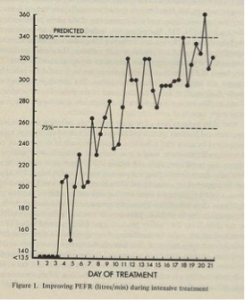
Fig 81.Twice daily PEFRs during a severe exacerbation on referral to our CF centre during the Eighties
To help answer the question of length of intravenous antibiotics during an acute exacerbation of cystic fibrosis (CF), the authors had subjects to follow daily home spirometry while on intravenous antibiotics. CF patients, 18 and older, with an acute exacerbation requiring intravenous antibiotics had a daily FEV1. The average time to a 10% increase over their initial sick FEV1 was calculated, as well as the time to a new baseline. A total of 25 subjects completed the study. Ten of the 25 subjects did not have a sustainable 10% increase in FEV1. Of the 15 subjects with a sustainable 10% increase in FEV1, it took 5.2 days (±4.5) after day 1, while a new baseline was achieved on average at 6.6 days (±4.8) after day 1. Given the wide range of time to a 10% improvement and new baseline, it is recommended there should be flexibility in length of intravenous antibiotics in CF, not by a pre-set number.

Fig. 82 Michael J Stephen PennMedicne.org
— This seems to be a helpful approach as, for a variety of reasons, patients differ in their response to antibiotic treatment. For many years in the Leeds Regional CF Centre we recorded the twice-daily Peak Expiratory Flow rates of children undergoing a course of IV antibiotic treatment (fig. 81) ; this was continued until the values plateaued. Failure to improve each day would prompt a search for the reason/s. The twice-daily PFRs would usually be measured before and after a bronchodilator to note the usual reduction in bronchial lability that occurs during effective treatment.
Michael J Stephen is associate professor in the Division of Pulmonary and Critical Care, Drexel University School of Medicine, Philadelphia, PA, USA.
Stephenson AL, Sykes J, Stanojevic S, Quon BS, Marshall BC, Petren K, Ostrenga J, Fink AK, Elbert A, Goss CH. Survival Comparison of Patients With Cystic Fibrosis in Canada and the United States: A Population-Based Cohort Study. Ann Intern Med. 2017 Mar 14. doi: 10.7326/M16-0858. [Epub ahead of print] [Pubmed]

Fig 83. Anne Stephenson
In 2011, the median age of survival of patients with cystic fibrosis reported in the United States was 36.8 years, compared with 48.5 years in Canada. Direct comparison of survival estimates between national registries is challenging because of inherent differences in methodologies used, data processing techniques, and ascertainment bias. The purpose of this study was to use a standardised approach to calculate cystic fibrosis survival estimates and to explore differences between Canada and the United States.
Population-based study involving 42 Canadian cystic fibrosis clinics and 110 U.S. cystic fibrosis care centers. Patients followed in the Canadian Cystic Fibrosis Registry (CCFR) and U.S. Cystic Fibrosis Foundation Patient Registry (CFFPR) between 1990 and 2013. Cox proportional hazards models were used to compare survival between patients followed in the CCFR (n = 5941) and those in the CFFPR (n = 45 448). Multivariable models were used to adjust for factors known to be associated with survival.
The Median age of survival in patients with cystic fibrosis increased in both countries between 1990 and 2013; however, in 1995 and 2005, survival in Canada increased at a faster rate than in the United States (P < 0.001). On the basis of contemporary data from 2009 to 2013, the median age of survival in Canada was 10 years greater than in the United States (50.9 vs. 40.6 years, respectively). The adjusted risk for death was 34% lower in Canada than the United States (hazard ratio, 0.66 [95% CI, 0.54 to 0.81]). A greater proportion of patients in Canada received transplants (10.3% vs. 6.5%, respectively [standardised difference, 13.7]). Differences in survival between U.S. and Canadian patients varied according to U.S. patients’ insurance status.
Ascertainment bias due to missing data or nonrandom loss to follow-up might affect the results.
Dr Anne Stephenson (fig.83) is Assistant Professor at the Institute of Health Policy, Management and Evaluation, Toronto.
— The authors concluded the differences in cystic fibrosis survival between Canada and the United States persisted after adjustment for risk factors associated with survival, except for private-insurance status among U.S. patients. Differential access to transplantation, increased post-transplant survival, and differences in health care systems may, in part, explain the Canadian survival advantage.
AN INTERESTING COMMENTARY ON THE ST MICHAEL’S HOSPITAL (TORONTO) WEBSITE
People with cystic fibrosis are living longer than ever before, but their lifespan is almost 10 years longer in Canada than in the United States, according to research published March 14 in the Annals of Internal Medicine.
The median age of survival for individuals with cystic fibrosis in Canada is 50.9 years compared to 40.6 years in the United States, said Dr. Anne Stephenson, a respirologist and cystic fibrosis researcher at St. Michael’s Hospital in Toronto, which has the largest adult CF clinic in Canada.
In addition, after taking into account factors such as age and the severity of the disease, the risk of death among people with cystic fibrosis was 34 per cent lower in Canada than in the United States, according to the research by lead author Dr. Stephenson and colleagues.
The study was funded by the U.S. Cystic Fibrosis Foundation using data from 45,456 patients in the U.S. Cystic Fibrosis Foundation Registry and 5,941 patients in the Canadian Cystic Fibrosis Registry from 1990 to 2013. The 10-year difference in lifespan was based on data from the last five years, 2009 to 2013.
Although the study was not designed to explain why the lifespan differs in the two countries, Dr. Stephenson said there were several possible reasons: transplants, diet and medical insurance.
“Survival has increased in both countries, but Canada began to see greater improvements than the United States starting in 1995, with an even more dramatic increase in the survival rate in Canada noted in 2005,” said Dr. Stephenson.
Canadians with cystic fibrosis were exposed to a high fat diet in the 1970s, which was not implemented in the United States until the 1980s. In people with cystic fibrosis, higher caloric intake results in better nutritional status which and in previous studies has been linked to improved survival. Individuals born in the 1970s and exposed to good nutrition from birth could explain why Canadian survival rates saw improvement in 1995. This would suggest that countries where aggressive nutritional support was instituted in later decades should see the survival benefit in the near future.
Lung transplantation is one of the few treatments for cystic fibrosis that can positively impact survival almost immediately and a higher proportion of CF patients received a transplant in Canada than in the United States during the study period. The survival difference increased dramatically in 2005 which coincided with the year that the United States began using a lung allocation score to prioritise people on the lung transplant waiting list. This score is not used in Canada raising the possibility that this difference may be contributing to the survival gap seen.
The study found there was no difference in survival rates between U.S. patients with private health insurance compared to Canadians, who have universal, publicly funded health-care coverage. However, Canadians had a 44 per cent lower risk for death than U.S. patients receiving continuous Medicaid or Medicare, a 36 per cent lower risk than those receiving intermittent Medicaid or Medicare, and a 77 per cent lower risk than those with unknown or no health insurance.
— This is an interesting study and it is likely both the earlier nutritional treatment of the Canadians started in Toronto by Douglas Crozier in the Seventies and the present insurance differences are important factors.
Abigail Strang, Anthony J Fischer, Aaron Chidekel. Pseudomonas eradication and clinical effectiveness of Ivacaftor in four Hispanic patients with S549N. Pediatr Pulmonol 2017; 52(7):E37-E39 April [Pubmed]

Fig 84. Abigail Strang
Ivacaftor was approved for rarer class-III CFTR mutations including S549N in 2014. Since these mutations are uncommon, ongoing reports of patient experiences with Ivacaftor and these mutations are important. This case series describes the clinical effectiveness (including airway infection status, lung function, and growth) of Ivacaftor therapy in four pediatric Hispanic patients with S549N and F508del over 24 months. In these patients, Ivacaftor was highly efficacious with no further Pseudomonas-positive cultures despite prior chronic colonization in three patients as well as notable improvements in lung function and growth. The remarkable improvements in lung function and growth were similar to G551D patients with more striking changes in airway infection status.
Dr Abigail Strang (fig.84) is paediatric pulmonologist at the Department of Pulmonology, A.I. du Pont Hospital for Children, Wilmington, Delaware.
Schwarz C, Brandt C, Whitaker P, Sutharsan S, Skopnik H, Gartner S, Smazny C, Röhmel J F. Invasive Pulmonary Fungal Infections in Cystic Fibrosis. Mycopathologia. 2017 Sep 1. doi: 10.1007/s11046-017-0199-4. [Epub ahead of print] [Pubmed]

Fig 85. Carsten Schwarz
This case series provides useful multicenter experience on diagnostic, manifestation, and treatment of non-ABPA cases of pulmonary mycoses in patients with CF have been collected from the CF Centres in Berlin, Essen, Worms, Frankfurt (Germany), Leeds (UK), and Barcelona (Spain). Non-ABPA was defined as total serum IgE level <500 kU/L. Scedosporium and Lomentospora species seem to be more virulent in patients with CF and have been successfully treated with triple antifungal drug regimens in several cases. Rare fungi including yeasts can have pathogenic potential in CF. In this series, antibiotic treatment failure was the main indicator for the initiation of antifungal treatment. For an early and effective treatment of pulmonary mycoses in CF, the identification of biomarkers and of risk factors beyond antibiotic treatment failure is crucial and urgently needed. Furthermore, treatment efficacy studies are necessary for the different causative agents of these infections
Carsten Schwarz (fig. 85) is Director of the Adult CF Centre, Endoscopy and Lung Transplantation Charite Universitatsmedizin, Berlin.
Seror V, Cao C, Roussey M, Giorgi R. PAP assays in newborn screening for cystic fibrosis: a population-based cost-effectiveness study. J Med Screen. 2016 Jun;23(2):62-9. doi: 10.1177/0969141315599421. Epub 2015 Aug 24.[Pubmed]

Fig. 86 Valerie Seror economics.scienceconf.org
A study to compare the cost effectiveness of adding a pancreatitis-associated protein (PAP) assay to common immunoreactive trypsinogen (IRT) and DNA cystic fibrosis (CF) newborn screening strategies.
Using data collected on 553,167 newborns, PAP cut-offs were calculated based on non-inferiority of the detection rates of classical forms of CF. Cost effectiveness was considered from the third-party payer’s perspective using only direct medical costs, and the unit costs of PAP assays were assessed based on a micro-costing study. Robustness of the cost-effectiveness estimates was assessed, taking the secondary outcomes of screening (ie. detecting mild forms and CF carriers) into account.
IRT/DNA, IRT/PAP, and IRT/PAP/DNA strategies had similar detection rates for classical forms of CF, but the strategies involving PAP assays detected smaller numbers of mild forms of CF. The IRT/PAP strategy was cost-effective in comparison with either IRT/DNA or IRT/PAP/DNA. IRT/PAP/DNA screening was cost-effective in comparison with IRT/DNA if relatively low value was assumed to be attached to the identification of CF carriers.
The authors concluded IRT/PAP strategies could be strictly cost-effective, but dropping DNA would mean the test could not detect CF carriers. IRT/PAP/DNA strategies could be a viable option as they are significantly less costly than IRT/DNA, but still allow CF carrier detection
— In the opinion of many, including this reviewer, the failure of a test to detect CF carriers would be a definite disadvantage.
Valerie Seror (fig.86) with INSERM, UMR912 “Economics and Social Sciences Applied to Health & Analysis of Medical Information” (SESSTIM), 13006, Marseille, France Aix Marseille University, UMR_S912, IRD, 13006, Marseille, France
Sykes J, Stanojevic S, Goss CH, Quon BS, Marshall BC, Petren K, Ostrenga J, Fink A, Elbert A, Stephenson AL. A standardised approach to estimating survival statistics for population-based cystic fibrosis registry cohorts. J Clin Epidemiol. 2016 Feb;70:206-13. doi: 10.1016/j.jclinepi.2015.08.026. Epub 2015 Oct 3. 26434789 Free PMC Article[Pubmed]

Fig. 87 Jenna Sykes
disph.utoronto.ca
The authors’ objective was to quantify the effect of different statistical techniques, inclusion/exclusion criteria, and missing data on the predicted median survival age. Using the Canadian cystic fibrosis registry (CCFR), the median age of survival was calculated using both the Cox proportional hazards (PH) and the life-table methods. Through simulations, they examined how the median age of survival would change when: (1) patients were excluded, (2) death dates were inaccurate, (3) patients were lost to follow-up, (4) entire years with no clinic visits were excluded even if the patient had a visit in subsequent years, and (5) censoring patients at their date of transplant. Simulations were run assuming 5-35% of data were affected by each scenario.
Over the period 2009-2013, there were 4,666 individuals in the CCFR with 240 deaths. The observed median age of survival calculated by the Cox PH method was 50.9 [95% confidence interval (CI): 47.4, 54.3] and 50.5 from the life-table method (95% CI: 47.5, 53.5). Censoring patients at their transplant date overestimated the median age of survival by 7.2 years (58.1; 95% CI: 53.3, 64.7). Simulations determined that by missing just 15% of deaths, the median age of survival can be overestimated by 3.5 years (54.4; 95% CI: 54.2, 56.1), and having 25% of patients lost to follow-up can underestimate the median age of survival by 3.3 years (47.6; 95% CI: 46.8, 47.7).
— The authors present several important recommendations to assist national cystic fibrosis registries in calculating and reporting the median age of survival in a standardised fashion. It is imperative to state the statistical method used as well as the proportion lost to follow-up and the treatment of missing data and transplanted patients. Registries must be diligent in their data collection as incomplete data can lead to overestimation and underestimation of survival.
Jenna Sykes is at the Department of Respirology, St. Michael’s Hospital, 30 Bond Street, 6th Floor, Bond Wing, Toronto, Ontario, Canada M5B 1W8.
Talamo Guevara M, McColley SA. The safety of lumacaftor and ivacaftor for the treatment of cystic fibrosis. Expert Opin Drug Saf. 2017 Nov;16(11):1305-1311. doi: 10.1080/14740338.2017.1372419. Epub 2017 Sep 21. [Pubmed]
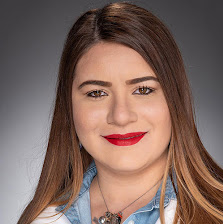
Fig. 88 Maria Talamo Guevara
CookChildren’s
This article reviews safety of this therapy. Areas covered: Safety findings in ivacaftor, lumacaftor and combined therapy trials, and reported subsequently through post-approval evaluation, were accessed by PubMed and Google searches using key words ‘VX-770’, ‘ivacaftor’, ‘VX-809’, and ‘lumacaftor’. Transaminitis was seen in ivacaftor and combination trials. Non-congenital cataracts were seen in pre-clinical animal studies and in children taking ivacaftor and combined therapy. Dyspnea occurs in some patients taking lumacaftor and combined therapy and usually resolves without stopping treatment. Lumacaftor is a strong inducer of CYP3A while ivacaftor is a CYP3A sensitive substrate. Combination therapy can decrease systemic exposure of medications that are substrates of CYP3A, decreasing therapeutic effect. Co-administration of lumacaftor-ivacaftor with sensitive CYP3A substrates or CYP3A substrates with narrow therapeutic index is not recommended. Expert opinion: Lumacaftor-ivacaftor therapy may be associated with ocular and hepatic side effects. Specific recommendations for monitoring are available. Dyspnea occurs, especially during initiation of treatment. Potential drug interactions should be evaluated in patients taking combination therapy. The risk benefit ratio of lumacaftor-ivacaftor favours therapy.
– A comprehensive summary of the potential problems with these drugs.
Maria Talamo Guevara (fig.88) is a paedaitric pulmonologist in the Dept. of Pediatrics , Northwestern University Feinberg School of Medicine and Ann & Robert H. Lurie Children’s Hospital of Chicago .
Taylor-Cousar JL, Jain M, Barto TL, Haddad T, Atkinson J, Tian S, Tang R, Marigowda G, Waltz D, Pilewski J; VX14-809-106 Investigator Group. Lumacaftor/ivacaftor in patients with cystic fibrosis and advanced lung disease homozygous for F508del-CFTR. J Cyst Fibros. 2017 Nov 7. pii: S1569-1993(17)30891-3. doi: 10.1016/j.jcf.2017.09.012. [Epub ahead of print]

Fig.89 Jennifer L Taylor-Cousar
National Jewish Health
A study to evaluate the safety, tolerability, and efficacy of lumacaftor/ivacaftor [Orkambi] in patients with cystic fibrosis (CF) with severe lung disease. Patients with CF 12 years of age and older, homozygous for F508del-CFTR, with percent predicted forced expiratory volume in 1 second (ppFEV1) <40 received lumacaftor 400 mg/ivacaftor 250mg every 12h (full dose) for 24weeks in an open-label, prospective study. Dose modification to half dose for 1-2weeks (including at initiation) was permitted. Safety and tolerability were the primary outcome measures; clinical outcomes were also assessed.
Compared with patients with higher lung function, respiratory events were more common in patients with ppFEV1<40; aside from these events, the lumacaftor/ivacaftor safety profile was consistent with previous studies.
Results suggest that patients with ppFEV1<40 may benefit from treatment initiation at a lower dose with augmented monitoring before increasing to the full dose.
Jennifer L Taylor-Cousar (fig. 89) is a professor of adult and paediatric pulmonology at National Jewish Health, Denver.
Taylor-Cousar JL, Munck A, McKone EF, van der Ent CK, Moeller A, Simard C, Wang LT, Ingenito EP, McKee C, Lu Y, Lekstrom-Himes J, Elborn JS. Tezacaftor-Ivacaftor in Patients with Cystic Fibrosis Homozygous for Phe508del. N Engl J Med. 2017 Nov 23;377(21):2013-2023. doi: 10.1056/NEJMoa1709846. Epub 2017 Nov 3. [Pubmed]
In this phase 3, randomized, double-blind, multicenter, placebo-controlled, parallel-group trial, the authors evaluated combination therapy with tezacaftor and ivacaftor (Symdeko) in patients 12 years of age or older who had cystic fibrosis and were homozygous for the CFTR Phe508del mutation. Patients were randomly assigned in a 1:1 ratio to receive either 100 mg of tezacaftor once daily and 150 mg of ivacaftor twice daily or matched placebo for 24 weeks. The primary end point was the absolute change in the percentage of the predicted forced expiratory volume in 1 second (FEV1) through week 24 (calculated in percentage points); relative change in the percentage of the predicted FEV1 through week 24 (calculated as a percentage) was a key secondary end point.
Of the 510 patients who underwent randomization, 509 received tezacaftor-ivacaftor or placebo, and 475 completed 24 weeks of the trial regimen. The mean FEV1 at baseline was 60.0% of the predicted value. The effects on the absolute and relative changes in the percentage of the predicted FEV1 in favour of tezacaftor-ivacaftor over placebo were 4.0 percentage points and 6.8%, respectively (P<0.001 for both comparisons). The rate of pulmonary exacerbation was 35% lower in the tezacaftor-ivacaftor group than in the placebo group (P=0.005). The incidence of adverse events was similar in the two groups. Most adverse events were of mild severity (in 41.8% of patients overall) or moderate severity (in 40.9% overall), and serious adverse events were less frequent with tezacaftor-ivacaftor (12.4%) than with placebo (18.2%). A total of 2.9% of patients discontinued the assigned regimen owing to adverse events. Fewer patients in the tezacaftor-ivacaftor group than in the placebo group had respiratory adverse events, none of which led to discontinuation.The authors concluded the combination of tezacaftor and ivacaftor was efficacious and safe in patients 12 years of age or older who had cystic fibrosis and were homozygous for the CFTR Phe508del mutation.
Dr Jennifer Taylor-Cousar (fig. 89) is a paediatrician and adult pulmonologist in Denver, Colorado.
Town JA; Aitken ML. Deaths Related to Bronchial Arterial Embolization in Patients With Cystic Fibrosis: Three Cases and an Institutional Review. Chest. 150(4):e93-e98, 2016 Oct [Pubmed]

Fig. 90 James A Town
UW Medicine
The outcomes after BAE for hemoptysis in CF and present three cases highlighting this complication. From 2007 to 2015, 12 patients underwent 17 BAE procedures for hemoptysis at our institution. Three patients experienced respiratory failure and died within 3 months of BAE. Non-survivors had significantly lower baseline FEV1 values than survivors (21.8% vs. 52.6%, P <.05). BAE as a treatment for life-threatening hemoptysis may precipitate respiratory failure in end-stage CF and should accelerate the evaluation for lung transplantation.
The authors advise that institutions should re-evaluate their BAE practices to ensure preservation of the bronchial circulation, which contributes to gas exchange in these patients.
James A Town is in the Division of Pulmonary and Critical Care, Department of Medicine, University of Washington, Seattle, WA.
Usatin D, Yen EH, McDonald C, Asfour F, Pohl J, Robson J. Differences between WHO AND CDC early growth measurements in the assessment of Cystic Fibrosis clinical outcomes. J Cyst Fibros. 2017 Jul;16(4):503-509. doi: 10.1016/j.jcf.2016.12.001. Epub 2016 Dec 15. [Pubmed]

Fig. 91 Danielle Usatin
Webmed Doctor
Early childhood growth status has been used to predict long-term clinical outcomes in CF patients. Adulthood CF outcomes based on early weight-for-length (WFL) measurements, using either World Health Organisation (WHO) or Centers for Disease Control (CDC) scales, have not been compared.
Cystic Fibrosis Foundation registry patients were studied (n=3014). Participants were categorised at age two years as WFL <50th percentile on both WHO and CDC scales, ≥50th percentile on WHO but not CDC, or ≥50th percentile on both. Pulmonary function and overall survival were assessed at age 18years. Stepwise gains in pulmonary function and lung transplant-free survival were noted across the three increasing WFL categories.
The authors concluded children with CF who achieve higher weight for length (WFL) at age two years have improved pulmonary and survival outcomes into adulthood. CF providers should continue to utilise current early growth recommendations, with goal WFL ≥50th percentile on CDC growth charts before age two.
— This long-term study is interesting and valuable even though the result was to be expected. In the past the long-term effect of various new interventions was unknown although predicted. For example, it was not until 2001 that the positive long-term favourable effect on growth following diagnosis by neonatal screening was established by Phillip Farrell’s group (Farrell PM et al, Pediatrics 2001; 107:1-13).
Dr. Danielle Usatin (fig.91) a pediatric gastroenterologist in San Francisco.
Vears DF, Delany C, Massie J, Gillam L. Why Do Parents Want to Know their Child’s Carrier Status? A Qualitative Study. J Genet Couns. 2016 Dec; 25(6):1257-1266. Epub 2016 May 19. pubmed.ncbi.nlm.nih.gov/27193897/

Fig. 92 Danya Vears
Loop(Frontiers)
When a child is identified with a genetic condition, some parents want to know the carrier status of their other children. There has been little exploration of why parents want this information. To address this question, semi-structured interviews were conducted with parents of 32 children with cystic fibrosis, haemophilia, and Duchenne muscular dystrophy who wanted to know the carrier status of their other children. Data was analysed using inductive content analysis. Parents expressed a range of reasons for desiring their child’s carrier status, which fell into two broad categories: 1) benefit for the parents and 2) perceived benefit to the child. Parents discussed the desire for certainty and peace of mind derived from having knowledge of their child’s status. The most commonly expressed reason for wanting to know their child’s carrier status was in order to communicate the information to their child to provide them with the ability to make informed reproductive decisions.
These reasons suggest parents are seeking their children’s carrier information both as a coping strategy and to communicate carrier information as part of their role as a parent. This has important implications for genetic counselling practice, especially as international guidelines generally recommend against carrier testing in children. – as far as CF is concerned neonatal screening presents an opportunity to identify carrier infants.
— It is to be hoped this information to identify other carriers in the family is used and the international guidelines regarded as not applicable to this particular situation.
Danya F Vears (fig.92) is a senior research fellow and social scientist, Centre for Health Equity, Melbourne School of Population and Global Health, University of Melbourne, Parkville, Australia
Vermeulen F, Lebecque P, De Boeck K, Leal T. Biological variability of the sweat chloride in diagnostic sweat tests: A retrospective analysis. J Cyst Fibros. 2017 Jan;16(1):30-35. doi: 10.1016/j.jcf.2016.11.008. Epub 2016 Dec 22. pubmed.ncbi.nlm.nih.gov/28017620/

Fig. 93 Francois Vermeulen
UZ Leuven
The sweat test is the current gold standard for the diagnosis of cystic fibrosis (CF). CF is unlikely when sweat chloride (Clsw) is lower than 30mmol/L, Clsw>60 is suggestive of CF, with intermediate values between 30 and 60mmol/L. To correctly interpret a sweat chloride value, the biological variability of the sweat chloride has to be known.
Sweat tests performed in two centres using the classic Gibson and Cooke method were retrospectively reviewed (n=5904). Within test variability of Clsw was measured by comparing results from right and left arm collected on the same day. Between-test variability was calculated from subjects with sweat tests performed on more than one occasion.
Within-test variability of Clsw calculated in 1022 subjects was low with differences between -3.2 (p5) and +3.6mmol/L (p95). Results from left and right arm were classified differently in only 3 subjects. Between test variability of Clsw in 197 subjects was larger, with differences between -18.2mmol/L (p5) and +14.1mmol/L (p95) between repeat tests. Changes in diagnostic conclusion were seen in 55/197 subjects, the most frequent being changing from indeterminate to ‘CF unlikely’ range (48/102).
The authors concluded variability of sweat chloride is substantial, with frequent changes in diagnostic conclusion, especially in the intermediate range.
Francois Vermeulen is at the CF Centre, Department of Pediatrics, University Hospital of Leuven, Leuven, Belgium.
Usha Rani Somaraju, Arturo Solis-Moya. Pancreatic enzyme replacement therapy for people with cystic fibrosis
Cochrane Cystic Fibrosis and Genetic Disorders Group DOI: 10.1002/14651858.CD008227.pub3 View/save citation. pubmed.ncbi.nlm.nih.gov/27878805/
This long review is not described in detail here although many would question the authors’ conclusions that “there is limited evidence of benefit from enteric-coated microspheres when compared to non-enteric coated pancreatic enzyme preparations up to one month. In the only comparison where we could combine any data, the fact that these were cross-over studies is likely to underestimate the level of inconsistency between the results of the studies due to over-inflation of confidence intervals from the individual studies. There is no evidence on the long-term effectiveness and risks associated with pancreatic enzyme replacement therapy. There is also no evidence on the relative dosages of enzymes needed for people with different levels of severity of pancreatic insufficiency, optimum time to start treatment and variations based on differences in meals and meal sizes. There is a need for a properly designed study that can answer these questions”.
—- This reviewer recommends that any readers who are confused by this unhelpful Cochrane Review and wish to obtain information on the practical aspects of the effective use of pancreatic enzymes in CF, of which there is a vast amount, to read “Diagnosis and treatment of intestinal malabsorption in cystic fibrosis”. Littlewood JM, Wolfe SP, Conway SP. Pediatr Pulmonol. 2006 Jan;41(1):35-49.[Pubmed].
Usha Rani Somaraju is in the Department of Biochemistry, Malla Reddy Medical College for Women, Suraram Main Road, Jeedimetla Qutbullapur Municipality, Hyderabad, India, 500 055. More recently at Star Hospitals Hyderabad, India.
Arturo Solis Moya is a pediatric pulmonologist at Hospital San Jose, Costa Rica. More recently Servicio de Neumología, Hospital Nacional de Niños, San José, Costa Rica.
Vermeulen F, Le Camus C, Davies JC, Bilton D, Milenković D, De Boeck K. Variability of sweat chloride concentration in subjects with cystic fibrosis and G551D mutations. J Cyst Fibros. 2017 Jan; 16(1):36-40. doi: 10.1016/j.jcf.2016.02.015. Epub 2016 Mar 17[Pubmed]
There is only limited information on the within subject variability of sweat chloride over time. Such information would be useful for sample size calculations in clinical trials. Therefore, the authors retrospectively analysed repeated sweat chloride values obtained in patients with G551D mutation(s) assigned to placebo in an ivacaftor interventional trial. In subjects with G551D at least 12years of age, a pilocarpine sweat test using Macroduct collector was taken on both arms at 8 time points over 48weeks. We explored 1062 pilocarpine sweat test values obtained in 78 placebo patients of the VX08-770-102 trial.
Mean overall sweat chloride value (all patients, all tests, n=1062) was 100.8mmol/L (SD 12.7mmol/L). Using a multilevel mixed model, the between-subject standard deviation (SD) for sweat chloride was 8.9mmol/L (95% CI 7.4-10.6) and within-subject SD was 8.1mmol/L (95% CI 7.5-8.7). Limits of repeatability for repeat measurements were -19.7 to +21.6mmol/L using values from one arm, and -13.3 to 11.8mmol/L using mean of values obtained at 4 test occasions. Sample size calculations showed that the minimal treatment effect on sweat chloride concentration that can be demonstrated for a group of 5 patients is around 15mmol/L, using a crossover design and combinations of 4 tests for each phase of the trial.
The authors concluded that although the sweat test is considered a robust measure, sweat chloride measurements in patients with CF and a G551D mutation had an inherent biological variability that is higher than commonly considered. Further analyses of placebo group data are crucial to learn more about the natural variability of this outcome parameter.
Dr Francois Vermeulen (fig. 93 above) is based at the Cystic Fibrosis Reference Centre, University Hospital, Leuven.
(See also Fidler MC et al. J Cyst Fibros 2017; 16:41-44. Abstracted above)
Tummler B. Variability of sweat chloride – A never ending story. J Cyst Fibros 2017Jan; 16:7-8. pubmed.ncbi.nlm.nih.gov/27964834/

Fig. 94 Burkhard Tümmler MDH
An editorial on the subject by Burkhard Tummler dealing with the three papers in the January 2017 Journal of Cystic fibrosis. Tummler observes mean chloride changes are predictive for mean treatment effects but not for the individual subject. Individual responses in sweat testing were variable with impaired drug absorption and the second CFTR mutation. Tummler suggest that “more meaningful data of how subjects with rare CFTR mutation genotypes respond to CFTR modulators could be generated in prospective randomised n-of-1 cross over studies whereby basic defect and clinical phenotype are characterized by numerous complementary assays such as lung and sinonasal imaging, airway microbial metagenomics, b-adrenergic sweat secretion, intestinal pH, nasal PD measurements or intestinal current measurements or in vivo measurement on patients’ organoids.
Burkhard Tummler (fig. 94) Clinical Research Group ‘Molecular Pathology of Cystic Fibrosis’, Clinic for Paediatric Pneumology, Allergology and Neonatology, OE 6710, Hannover Medical School, Hannover, Germany; Biomedical Research in Endstage and Obstructive Lung Disease Hannover (BREATH), Member of the German Center for Lung Research, Hannover, Germany.
Waters V, Yau Y, Beaudoin T, Wettlaufer J, Tom SK, McDonald N, Rizvi L, Klingel M, Ratjen F, Tullis E. Pilot trial of tobramycin inhalation powder in cystic fibrosis patients with chronic Burkholderia cepacia complex infection. J Cyst Fibros 2017;16(4):492-495.[Pubmed]

Fig. 95 Valerie Waters
SickKids
There is no effective chronic suppressive therapy Burkholderia cepacia complex infection in cystic fibrosis (CF) patients. This was a pilot, open-label clinical trial of tobramycin inhalation powder (TIP) delivered via Podhaler twice daily for 28days in adults and children with CF and chronic B. cepacia complex infection in Toronto, Canada. A total of 10 subjects (4 pediatric, 6 adult patients) were treated. There was a mean drop of 1.4 log (CFU/ml) in sputum bacterial density (p=0.01) and sputum IL-8 levels decreased significantly after 28days of TIP (p=0.04). The mean relative change in FEV1 (L) from Day 0 to Day 28 of TIP administration was a 4.6% increase but this was not statistically significant. The majority of patients (70%) had no or mild adverse events.
Dr Valerie Waters (fig. 95) is an Associate Professor in the Department of Paediatrics at the University of Toronto and an infectious diseases physician at the Hospital for Sick Children.
Weber HC, Robinson PF, Saxby N, Beggs SA, Els I, Ehrlich RI. Do children with cystic fibrosis receiving outreach care have poorer clinical outcomes than those treated at a specialist cystic fibrosis centre? Aust J Rural Health. 2017 Feb;25(1):34-41. doi: 10.1111/ajr.12334. Epub 2016 Nov 17.[Pubmed] article available

Fig. 96 Heinrich Weber
LinkedIn
This is a retrospective database review of children with CF treated at the Royal Children’s Hospital in Melbourne and its outreach clinics in Albury (Victoria), and Tasmania. The aim was to compare the outcomes of children with CF managed at an academic centre with that of outreach care, using lung function, nutritional status and Pseudomonas aeruginosa colonisation. Three models of care, namely CF centre care, Shared care and predominantly Local care, were compared, based on the level of involvement of CF centre multidisciplinary team. In our analyses, we controlled for potential confounders, such as socio-economic status and the degree of remoteness, to determine its effect on the outcome measures.
RESULTS: There was no difference in lung function, i.e. forced expiratory volume in 1 s (FEV1 ), the prevalence of Pseudomonas aeruginosa colonisation or nutritional status (body mass index (BMI)) between those receiving CF centre care and various modes of outreach care. Neither socio-economic status, measured by the Socio-Economic Index for Area (SEIFA) for disadvantage, nor distance from an urban centre (Australian Standard for Geographical Classification (ASGC)) were associated with lung function and nutritional outcome measures. There was however an association between increased Pseudomonas aeruginosa colonisation and poorer socio-economic status.
The authors concluded outcomes in children with CF in regional and remote areas receiving outreach care supported by an academic CF centre were no different from children receiving CF centre care.
—- The CF Centre vs. local hospital care discussion continues to attract contrary views and at times heated discussion. In the present study from Australia there seems to be no advantage for the children receiving regular care at a major CF centre over those receiving their care elsewhere. The authors do not discuss the interesting striking difference in the use of DNase (28.7% at the CF centre, 42.9% on shared care and 58.6% of those receiving local care). In previous studies that failed to show differences between screened and late diagnosed children it was pointed out that more treatment was required to keep the non-screened children is good condition (Simms EJ et al, Pediaitrics 2007; 119:19-28. 17200267) The more frequent use of DNase in the children in the remote areas may be relevant in the present study.
Heinrich Weber (fig. 96) is Associate Professor of Paediatrics in the University of Tasmania.
Weir E; Burns PD; Devenny A; Young D; Paton JY. Cardiopulmonary exercise testing in children with cystic fibrosis: one centre’s experience. Arch Dis Child 102(5):440-444, 2017 May. [Pubmed]
While exercise testing is increasingly used as a prognostic indicator in cystic fibrosis (CF), it is reported to be underused in UK CF centres, particularly in children. Here, the authors evaluated the cardiopulmonary exercise testing (CPET) results in children and young people with CF at CF annual review and its possible clinical value.
An observational study comparing CPET results using a cycle ergometer ramp test (peak oxygen uptake (Vo2peak)) and pulmonary function (forced expiratory volume in 1 s (FEV1)) was performed with body mass index (BMI) used as a disease severity marker. Data were identified from clinical case notes and our CF database. Thirty-eight children and young people (mean age 11+/-2.4, range 7-14 years; 17 males and 21 females) completed at least one CPET with 95% achieving technically satisfactory tests allowing measurement of Vo2peak. Mean Vo2peak was 107 +/-17.6% predicted, range 74%-150% predicted, with 8% having a reduced Vo2peak of <85% of predicted. Mean FEV1 z-score was -0.77+/-1.24, range -4.42 to 2.24. We did not demonstrate a significant correlation between Vo2peak % predicted and FEV1 z-score (r=0.25, p=0.13), or between Vo2peak % predicted and BMI z-score (r=-0.05, p=0.77).Twenty-eight of 38 completed a second CPET the following year with 71% showing a decline in Vo2peak (mean decline of 8% of predicted value, equivalent to 3.8 mL/kg/min).
The authors concluded that CPET is feasible with 95% of children and young people achieving technically satisfactory assessments starting from age 7. In this group with relatively mild CF, mean Vo2peak was normal with no significant correlation between Vo2peak and FEV1 or BMI, as markers of disease severity. The majority demonstrated a normal Vo2peak. However, 71% showed a downward trend on repeat testing 12-18 months later.
—- It is true there that formal exercise testing is not a routine in most paediatric CF centres. In the present study, the majority of the children and young people with CF had BMI and pulmonary function within the normal range. The majority also had Vo2peak measurements within the normal range although most showed a decline in Vo2peak over time. The authors state it remains to be shown if these declines are clinically significant or are part of normal biological variation. The paper provides a useful review of the subject but certainly would not encourage one to add exercise testing to the already crowded routine for children with CF.
Elise Weir is in the Department of Respiratory Paediatrics, Royal Hospital for Children, Glasgow, UK.
Wettlaufer J, Klingel M, Yau Y, Stanojevic S, Tullis E, Ratjen F, Waters V. Longitudinal study of Stenotrophomonas maltophilia antibody levels and outcomes in cystic fibrosis patients. J Cyst Fibros. 2017 Jan;16(1):58-63. doi: 10.1016/j.jcf.2016.06.007. Epub 2016 Jun 23. [Pubmed]
Previous studies have shown an association between higher Stenotrophomonas maltophilia antibody levels and decreased lung function in patients with cystic fibrosis (CF). The purpose of this study was to assess the serologic response to S. maltophilia over time and to determine whether changes in antibody levels could predict clinical outcomes. Changes in S. maltophilia antibody levels in adult and pediatric patients with CF from 2008 to 2014 were assessed between groups of infection patterns. Regression models accounting for repeated measures were used to assess whether antibody levels could predict subsequent S. maltophilia microbiological status, and whether they are associated with lung function and subsequent pulmonary exacerbation.
A total of 409 S. maltophilia antibody samples from 135 CF patients showed that antibody levels did not change significantly between study visits, regardless of infection group. Higher antibody levels were independently associated with future culture positivity (OR 1.62; 95% CI 1.09, 2.41; p=0.02). While higher antibody levels were not independently associated with decreases in FEV1% predicted, they were associated with an increased hazard ratio for subsequent pulmonary exacerbation (HR 1.3; 95% CI 1.1, 1.6; p<0.001).
The authors concluded S. maltophilia antibody levels may be helpful to identify individuals at risk of exacerbation who may benefit from earlier antimicrobial treatment.
— Interesting but, as was the case with Pseudomonas antibodies, S. maltophilia antibodies are unlikely to be widely used in management of patients infected by this organism.
Jillian D Wettlaufer is in the Division of Infectious Diseases, Department of Pediatrics, The Hospital for Sick Children, University of Toronto, 555 University Avenue, Toronto, Canada
White H, Shaw N, Denman S, Pollard K, Wynne S, Peckham DG. Variation in lung function as a marker of adherence to oral and inhaled medication in cystic fibrosis. Eur Respir J. 2017 Mar 8;49(3). pii: 1600987. doi: 10.1183/13993003.00987-2016. Print 2017 Mar. [Pubmed]

Fig. 97 Helen White LinkedIn
The aim of this study was to characterise adherence in an adult population with cystic fibrosis (CF) and to investigate if variation in lung function was a predictor of adherence to treatment. The coefficient of variation of weight and C-reactive protein were not predictive of adherence. The coefficient of variation of FEV1 was identified as an objective predictor of adherence. The authors suggested further evaluation of this potential marker of adherence is now required.
Dr. Helen White (fig. 97) is a Principal Lecturer within the Nutrition and Dietetic Group and course leader for MSc Nutrition. She is Postgraduate Lead within the Group, and collaborates with NHS partners on a numbers of research projects incorporating adherence, nutrition and patient experience.
Woodruff SA, Sontag MK, Accurso FJ, Sokol RJ, Narkewicz MR. Prevalence of elevated liver enzymes in children with cystic fibrosis diagnosed by newborn screen. J Cyst Fibros. 2017 Jan;16(1):139-145. doi:10.1016/j.jcf.2016.08.002. Epub 2016 Aug 20. [Pubmed]

Fig 98 . Samantha Woodruff childrenscolorado.org
Prevalence and risks for elevated liver enzymes have not been studied systematically in children with CF identified by newborn screen. 298 CF children were identified by newborn screen since 1982. AST, ALT and GGT was tested at annual visits. The percent of children with 1 or ≥2 values of elevated AST, ALT and GGT was determined. Relationship of liver enzymes to clinical factors or subsequent liver disease was analysed.
At least one abnormal value for AST (63%), ALT (93%) and ALT ≥1.5× ULN (52%) occurred by 21years of age. Liver enzyme elevations were not correlated with CFTR mutation, meconium ileus or ethnicity. AST and GGT ≥1.5× ULN were associated with later advanced liver disease HR (CI) 6.53 (2.02-21.1) and 4.03 (1.15-13.45), respectively.
– The authors concluded that elevated liver enzymes are common during childhood in CF patients identified by newborn screening. They suggested that elevated AST and GGT may be markers for risk of advanced liver disease. The extent to which URSO was used in these patients was not known. Presumably the use of URSO would be indicated at an early stage in those with persistent elevation of these enzymes – most clinicians would agree that URSO is less effective as liver disease progresses. The authors’ protocol is to prescribe ursodeoxycholic acid after at least 2 elevations of AST, ALT or GGT N 1.5× ULN for more than 6 months. Thus while the continued persistence of elevated liver enzymes beyond 6 months may have been influenced by ursodeoxycholic acid treatment (from 2005), this would have not have had an effect on our definition of elevated enzyme prevalence.
Dr. Samantha Woodruff (fig. 98) is a pediatric gastroenterologist in Aurora, Colorado and is affiliated with multiple hospitals in the area, including Children’s Hospital Colorado and Memorial Hospital.
Woestenenk JW, Gulmans VA, van der Ent CK, Houwen RH. Height Assessment in the Dutch-Origin Pediatric Cystic Fibrosis Population. Nutr Clin Pract. 2017 Feb;32(1):130-132. doi: 10.1177/0884533616639109. Epub 2016 Jul 10. [Pubmed
Height evaluation is an integral part of cystic fibrosis care. Height is compared with reference values by converting it to height-for-age (HFA) z scores. However, HFA z scores do not adjust for genetic potential (ie, target height [TH]), which could result in an incorrect estimation of the height. To evaluate the magnitude of this potential problem, the authors assessed the agreement between HFA and HFA-adjusted-for-TH (HFA/TH) z scores in 474 Dutch children with CF.
In this study sample, HFA z scores were -0.07 (95% confidence interval, -0.02 to -0.12) lower than HFA/TH z scores. When HFA and HFA/TH z scores were subdivided into 4 categories (≥0, <0 and ≥-1, <-1 and ≥-2, and ≤-2), a moderate agreement was found. HFA z scores were classified lower than HFA/TH z scores in 21% of the measurements and higher in 15% of the measurements.
– The authors concluded in clinical routine, height evaluation based on height-for-age may result in underestimation or overestimation of height growth, which may induce inappropriate nutrition interventions. Seems there is still a place for clinical judgment of the state of nutrition!
Jenna Woestenenk is in Medicine and Dermatology, Dietetics, and Cystic Fibrosis Center Utrecht, University Medical Center Utrecht, Utrecht, the Netherlands.
Zacharasiewicz A, Renner S, Haderer F, Weber M, Dehlink E, Szepfalusi Z, Frischer T. Early detection of lung function decrements in children and adolescents with cystic fibrosis using new reference values. Wien Klin Wochenschr. 2017 Mar 9. doi: 10.1007/s00508-017-1184-0. [Epub ahead of print] [Pubmed]

Fig. 99 Angela Zacharasiewicz
ResearchGate
Interpretation of lung function values in children with cystic fibrosis depends on the applied reference values. The authors hypothesize that differences between the new global lung function initiative (GLI) values and the formerly used Zapletal et al. values produce significantly different clinical results. They analyzed 3719 lung function measurements of 108 children and adolescents (n = 54 male; aged 6-18 years) with CF treated between September 1991 and July 2009. Data were analysed in milliliters (ml) and % predicted (pred.) and interpreted using Zapletal and GLI reference values. Applying GLI compared to Zapletal resulted in significantly lower mean forced expiratory volume in 1s (FEV1)% pred. Zapletal 86.6% (SD 20.6), GLI 79.9% (SD 20.3) and 32% (n = 497/1543) were misclassified as normal when using Zapletal. Despite showing no overall differences in FEV1 and forced vital capacity (FVC) between concomitant Pseudomonas detection (PA+) in n = 938 and Pseudomonas negative (PA-) (n = 2781) using either reference PA+ resulted in lower FEV1 and FVC values with increasing age; however, measurement of small airway obstruction with forced expiratory flow at 75% of FVC (FEF75) values – available for Zapletal -showed significant differences. Reassurance regarding lung function when using old reference values may occur with potential clinical significance. Discrepancies in lung function interpretation underline the importance of using uniform and best available reference values.
Dr Angela Zacharasiewicz (fig. 99) is a consultant Paediatric Pulmonologist in Vienna.
Zeybel GL, Pearson JP, Krishnan A, Bourke SJ, Doe S, Anderson A, Faruqi S, Morice AH, Jones R, McDonnell M, Zeybel M, Dettmar PW, Brodlie M, Ward C. Ivacaftor and symptoms of extra-oesophageal reflux in patients with cystic fibrosis and G551D mutation. J Cyst Fibros. 2017 Jan;16(1):124-131. doi: 10.1016/j.jcf.2016.07.004. Epub 2016 Jul 27. 27475719 Free PMC Article[Pubmed]
Oesophageal reflux (EOR) may lead to micro aspiration in patients with cystic fibrosis (CF), a probable cause of deteriorating lung function. Successful clinical trials of ivacaftor highlight opportunities to understand EOR in a real world study. Data from 12 patients with CF and the G551D mutation prescribed ivacaftor (150mg bd) was collected at baseline, 6, 26 and 52 weeks. The changes in symptoms of EOR were assessed by questionnaire (reflux symptom index (RSI) and Hull airway reflux questionnaire (HARQ)). Six patients presented EOR at baseline (RSI >13; median 13; range 2-29) and 5 presented airway reflux (HARQ >13; median 12; range 3 to 33). Treatment with ivacaftor was associated with a significant reduction of EOR symptoms (P<0∙04 versus baseline) denoted by the reflux symptom index and Hull airway reflux questionnaire. – Ivacaftor treatment appeared to improve the symptoms of gastroesophageal reflux although no objective evidence was obtained.
Gemma L Zeybel is at the Institute for Cell and Molecular Bioscience, Newcastle University, Catherine Cookson Building, Framlington Place, Newcastle Upon Tyne NE2 4HH, United Kingdom.
Thomassen JC, Mueller MI, Alejandre Alcazar MA, Rietschel E, van Koningsbruggen-Rietschel S. Effectof Lumacaftor/Ivacaftor on glucose metabolism and insulin secretion in Phe508del homozygous cystic fibrosis patients. J Cyst Fibros. 2017 Dec 15. pii: S1569-1993(17)30973-6. doi: 10.1016/j.jcf.2017.11.016. [Epub ahead of print] [Pubmed]

Fig. 100 Jan Thomassen
ResearchGate
A study to investigate the effect of Lumacaftor/Ivacaftor on glucose metabolism and insulin secretion in patients with cystic fibrosis (CF) (Phe508del/Phe508del). After investigating 5 patients these authors concluded the investigation could not demonstrate that treatment with Lumacaftor/Ivacaftor had a consistent impact on glucose tolerance and insulin secretion.
Jan C Thomassen (fig.100) is a clinical scientist at the CF Center, Children’s Hospital, Faculty of Medicine, University of Cologne, Germany; Translational Experimental Pediatrics/Experimental Pulmonology, Children’s Hospital, Faculty of Medicine, University of Cologne, Germany.


